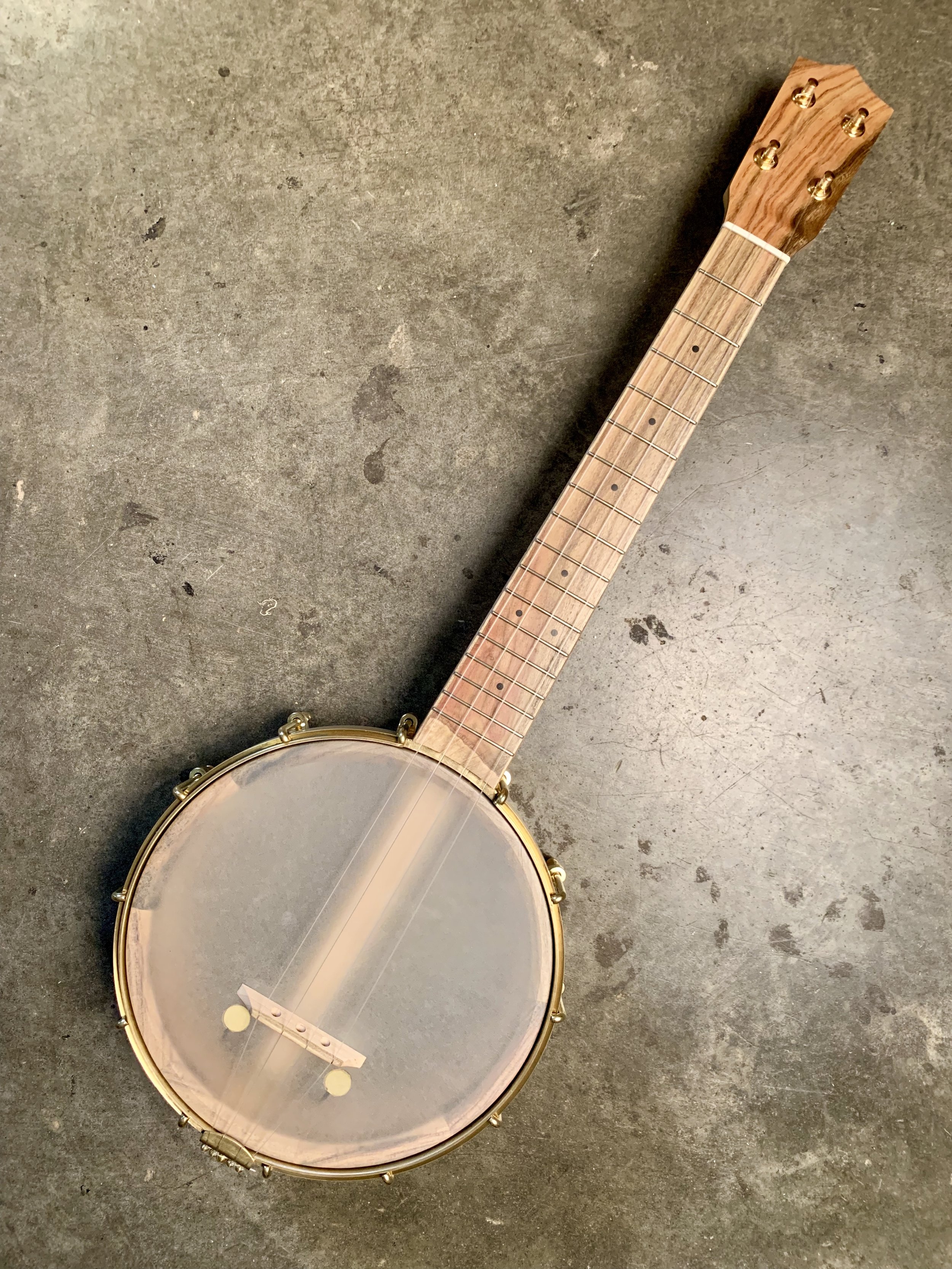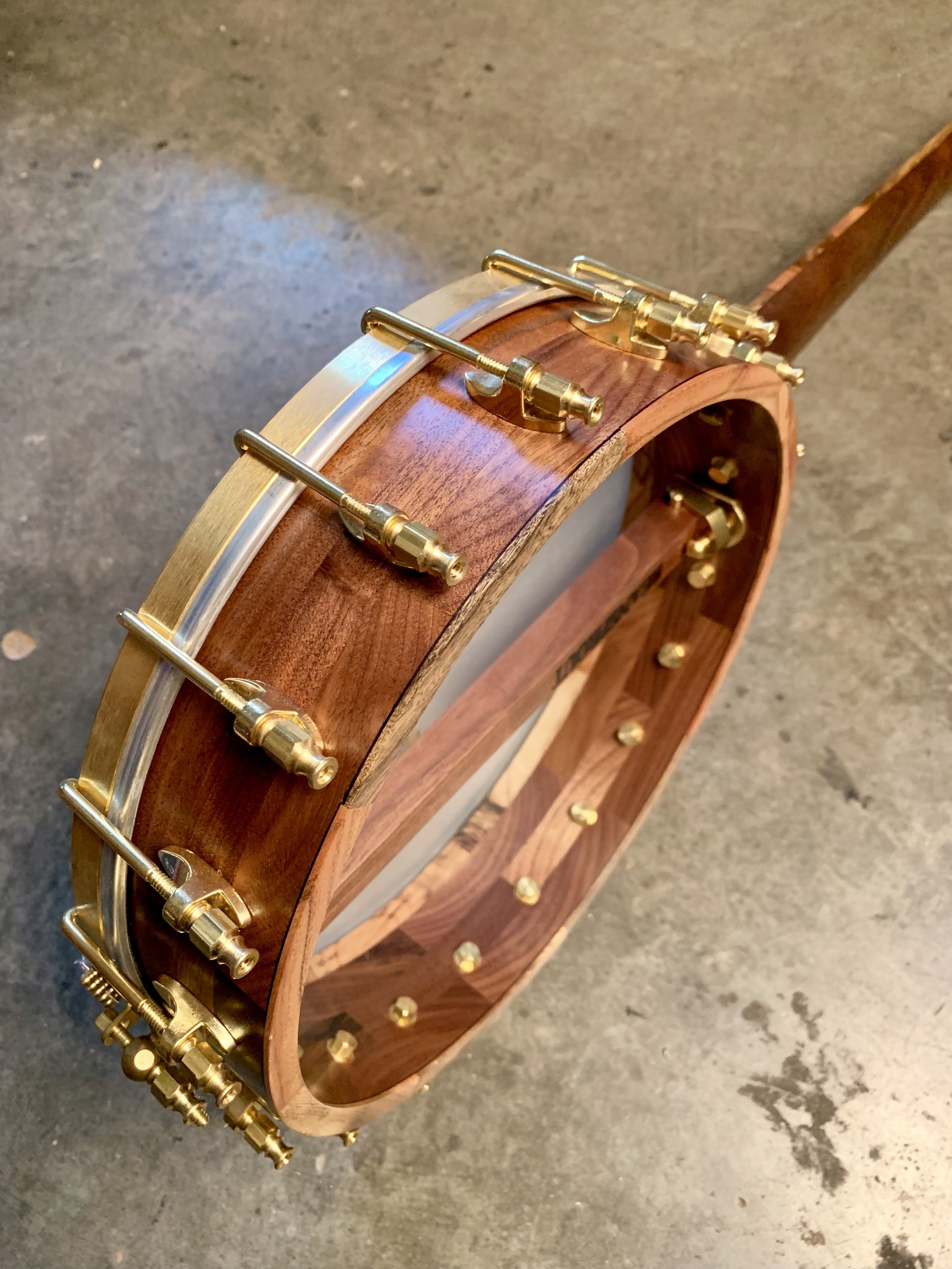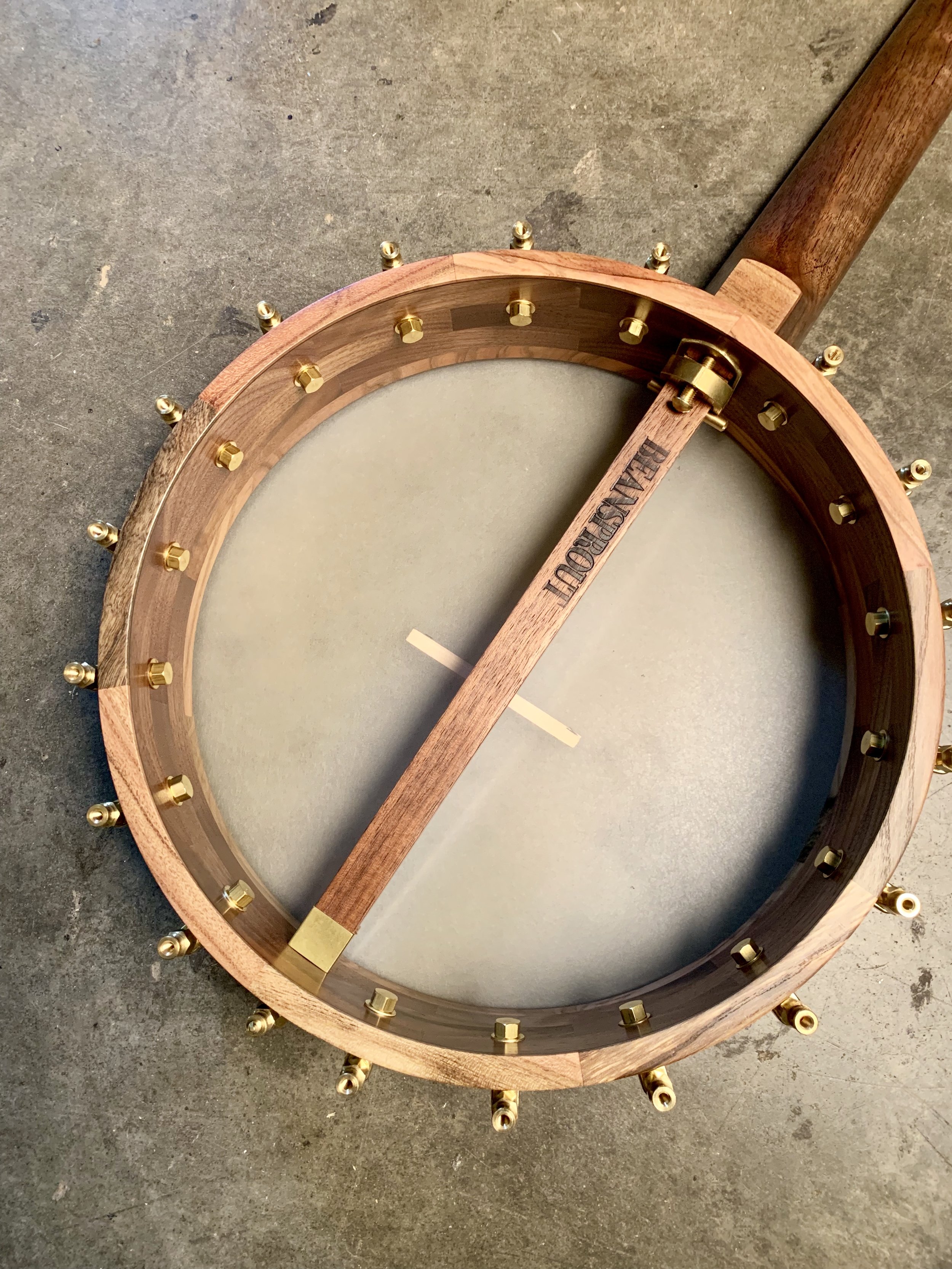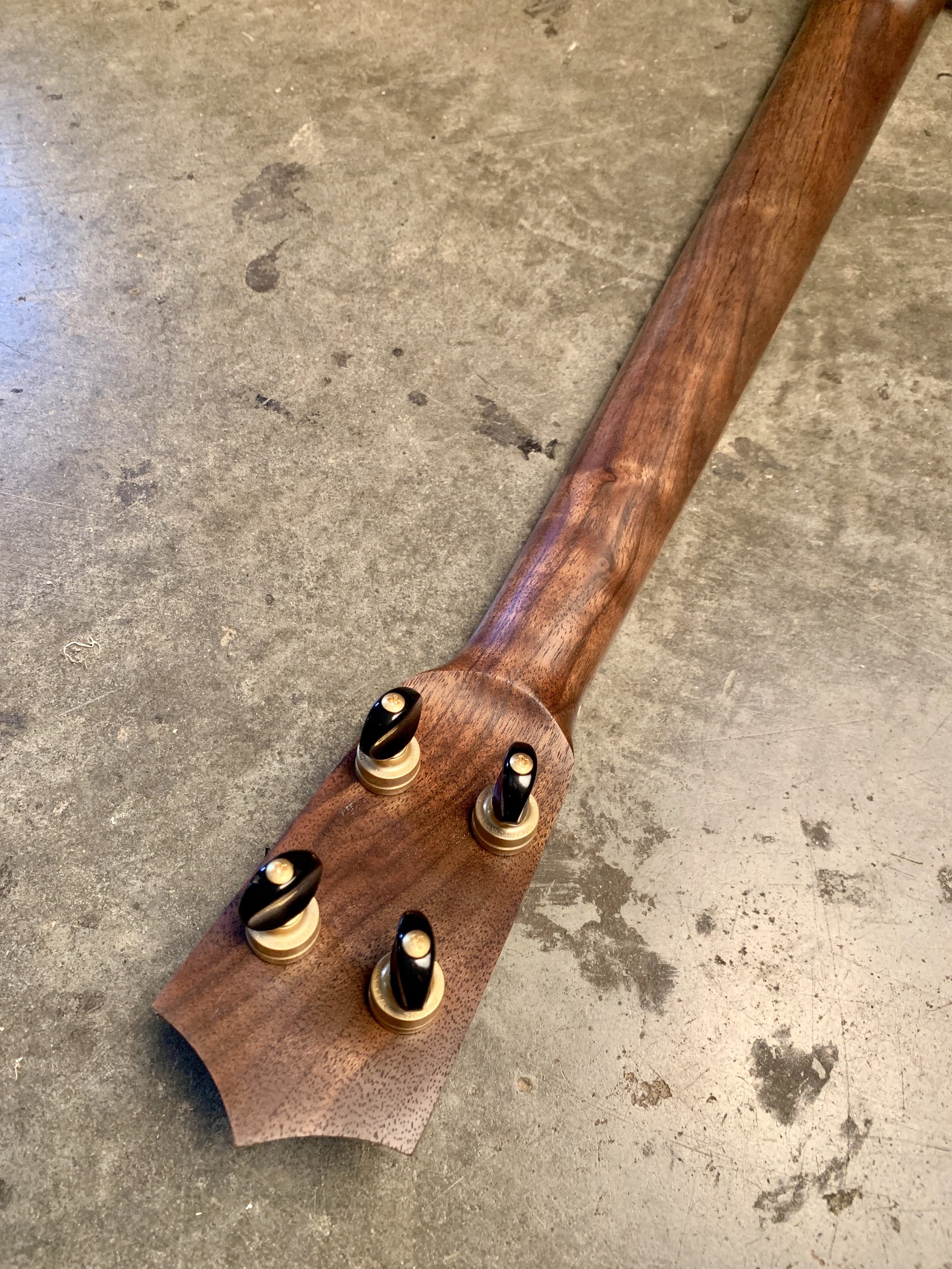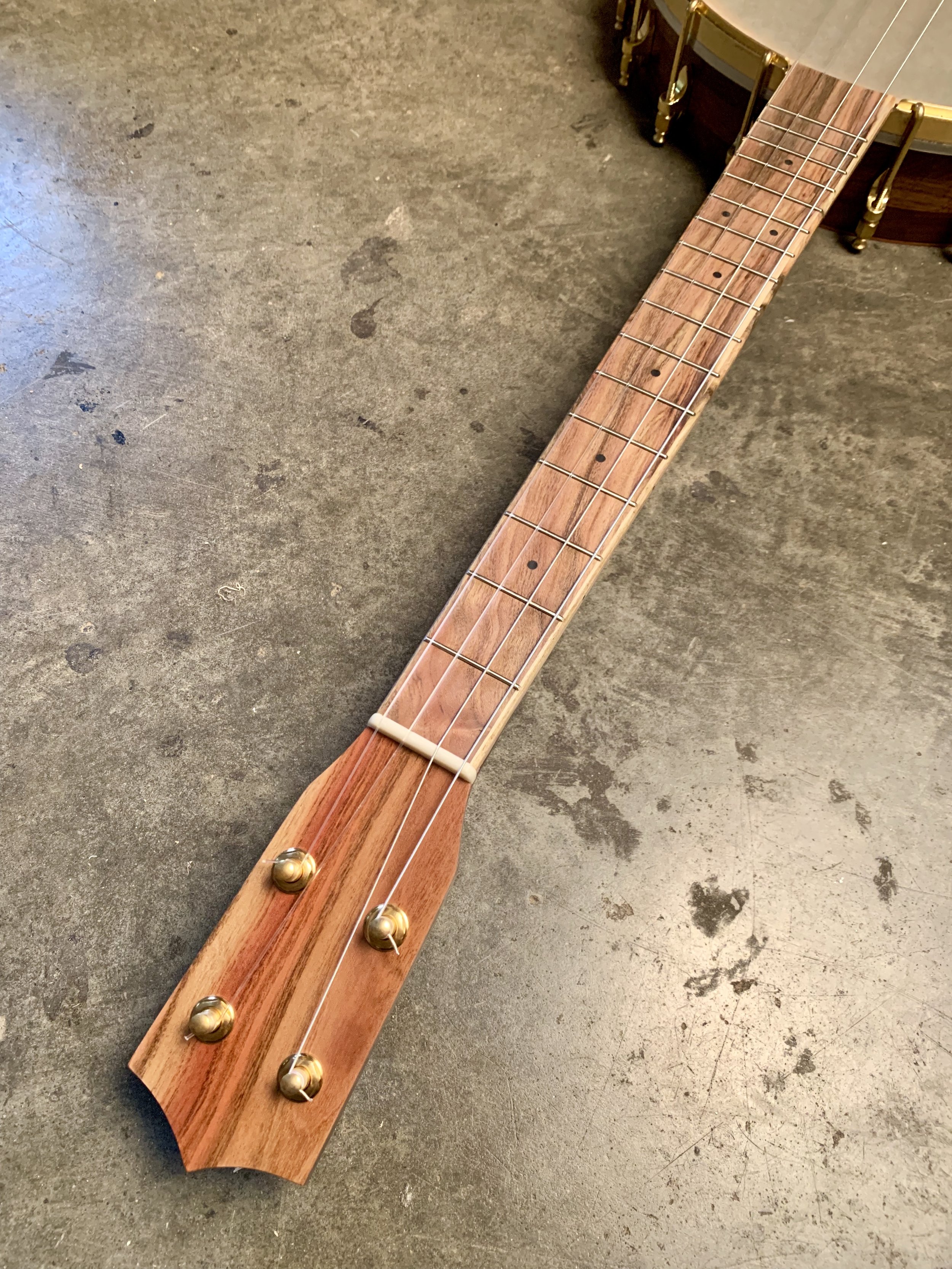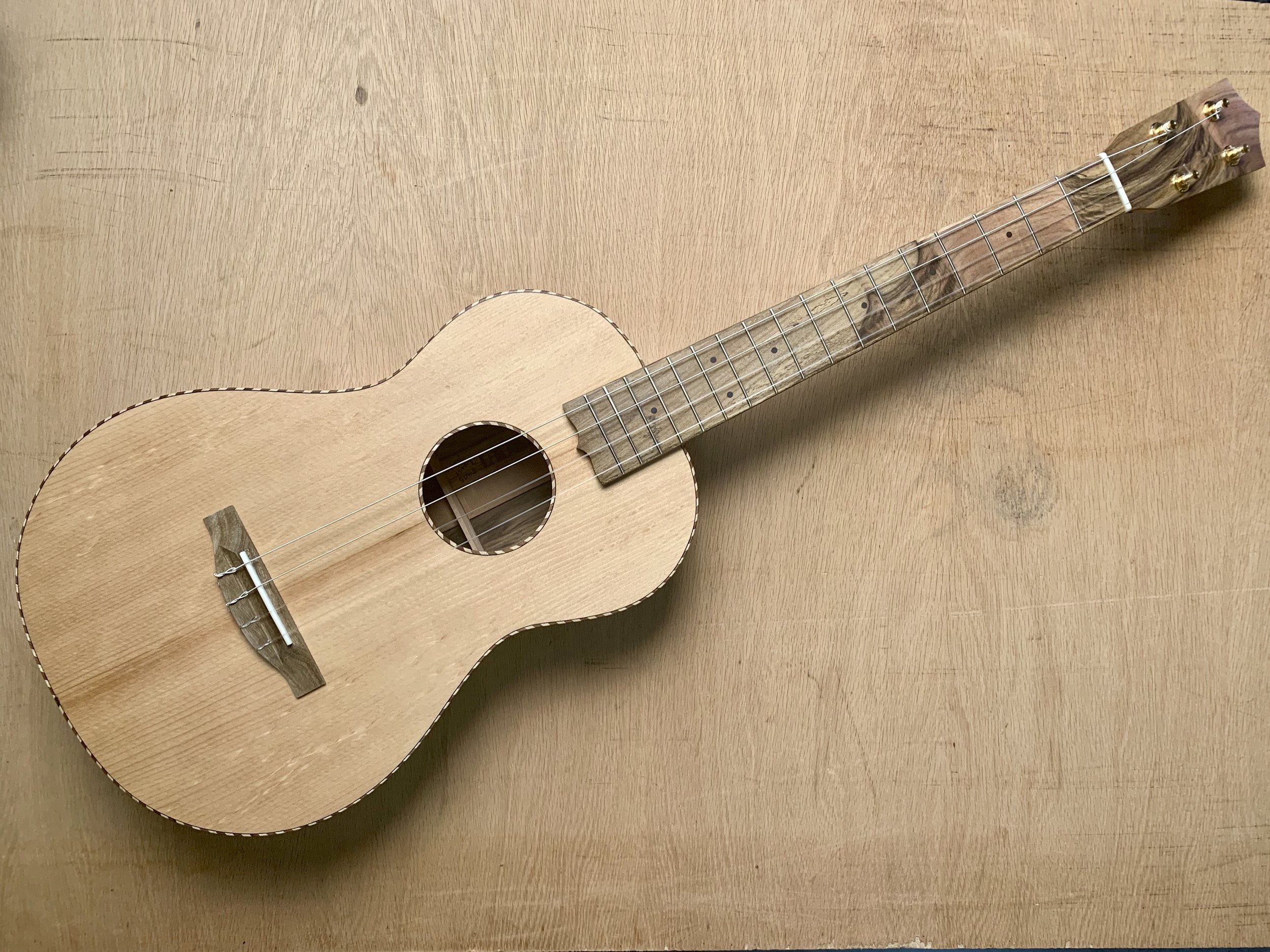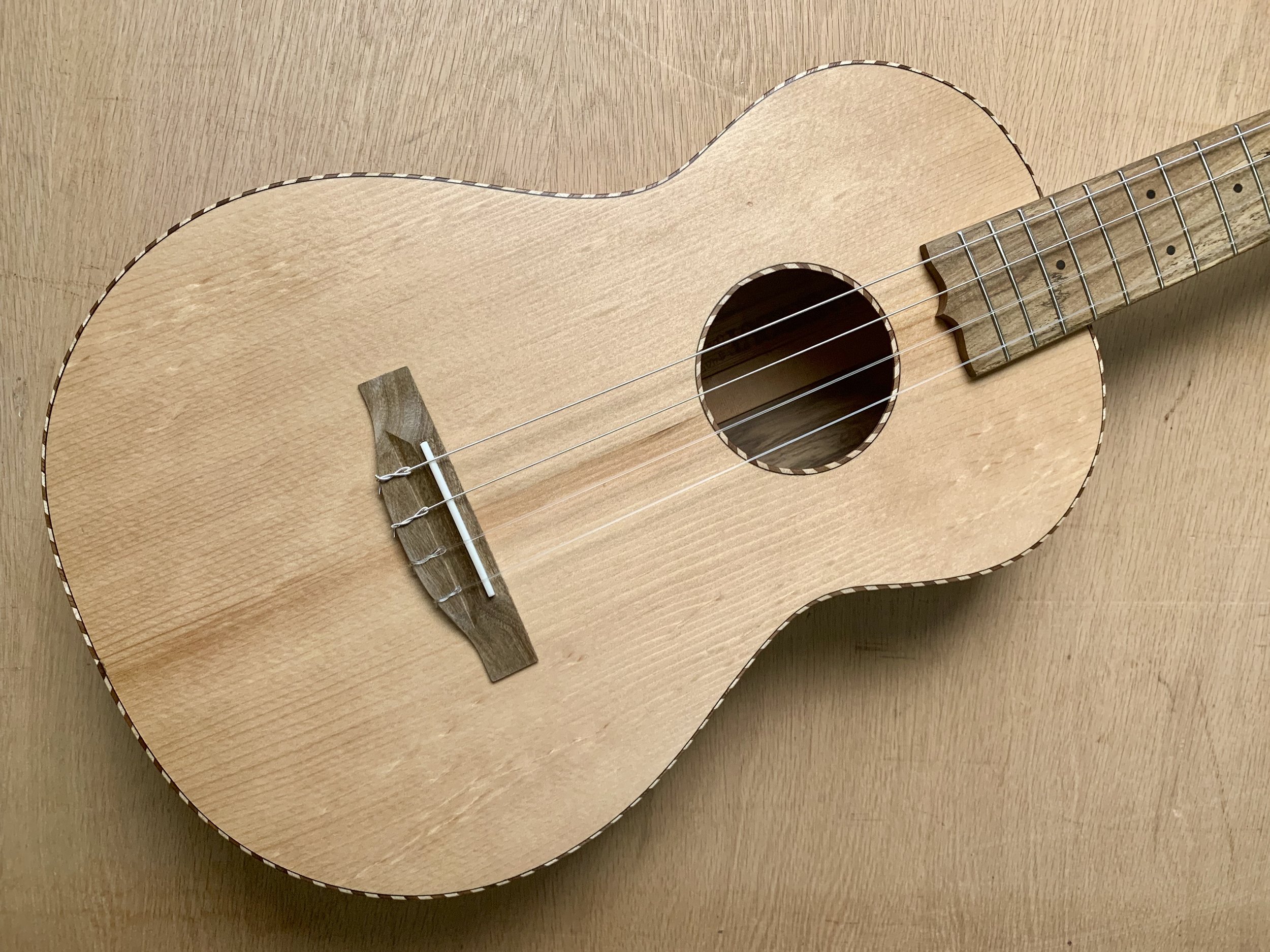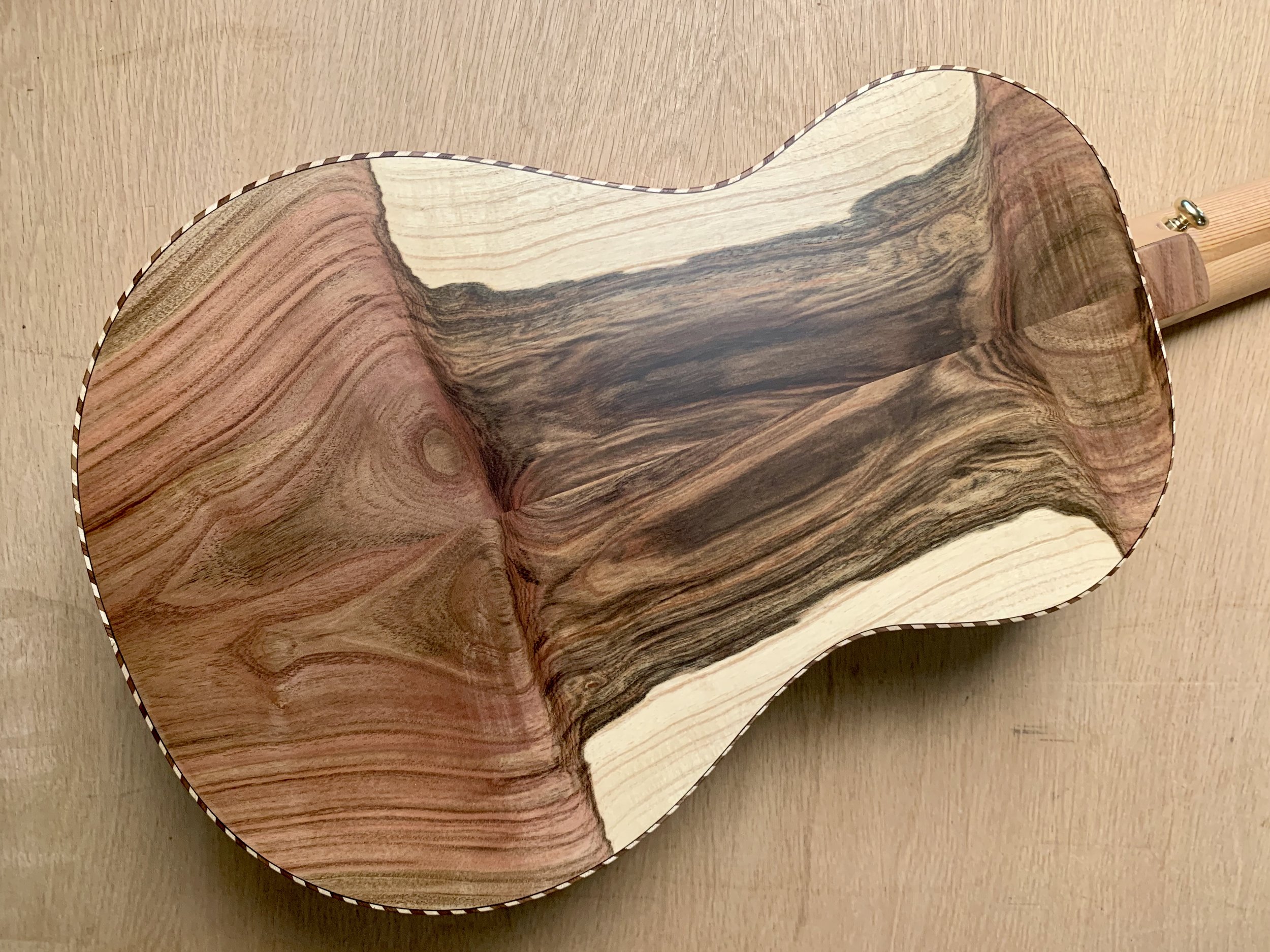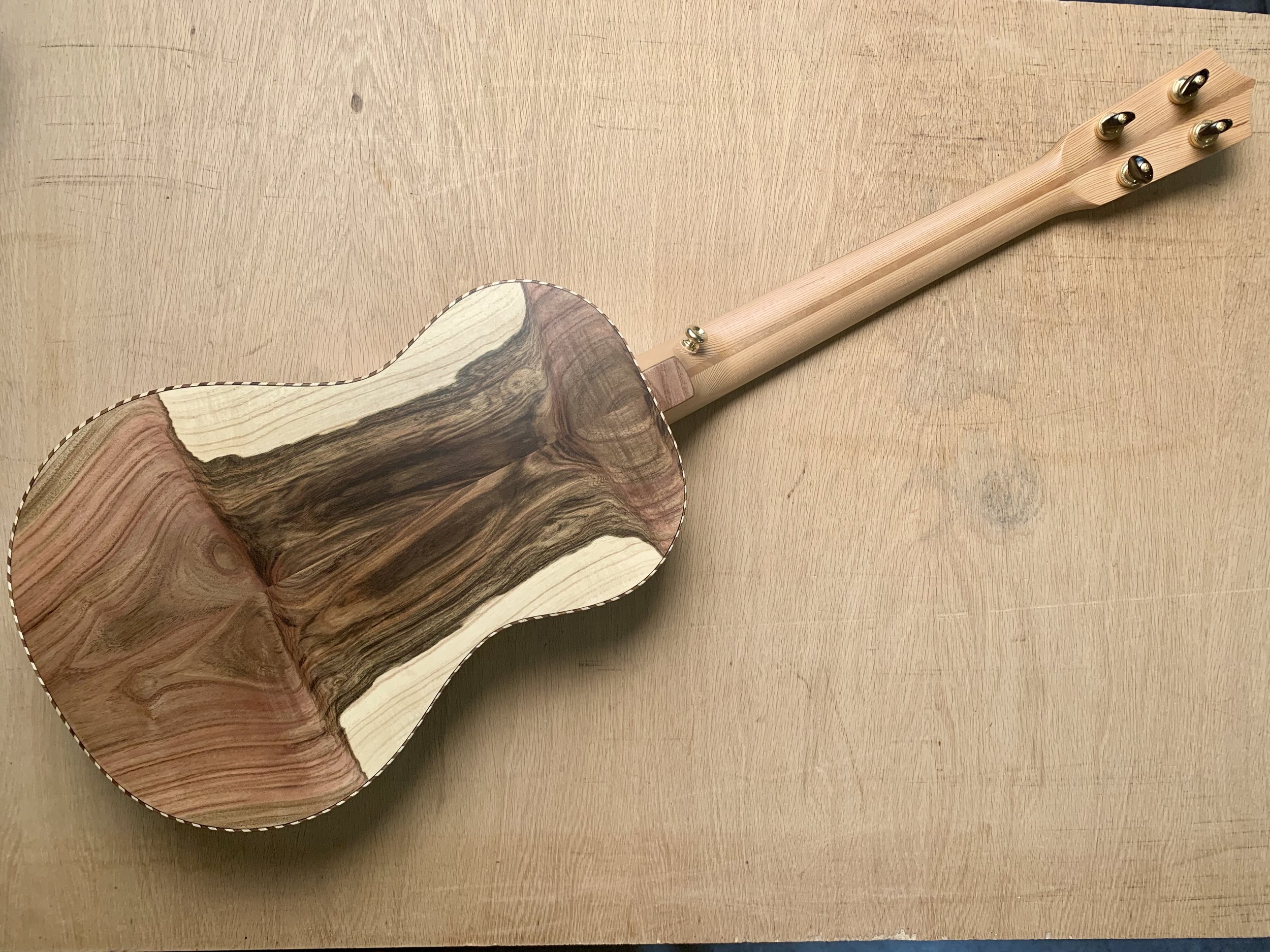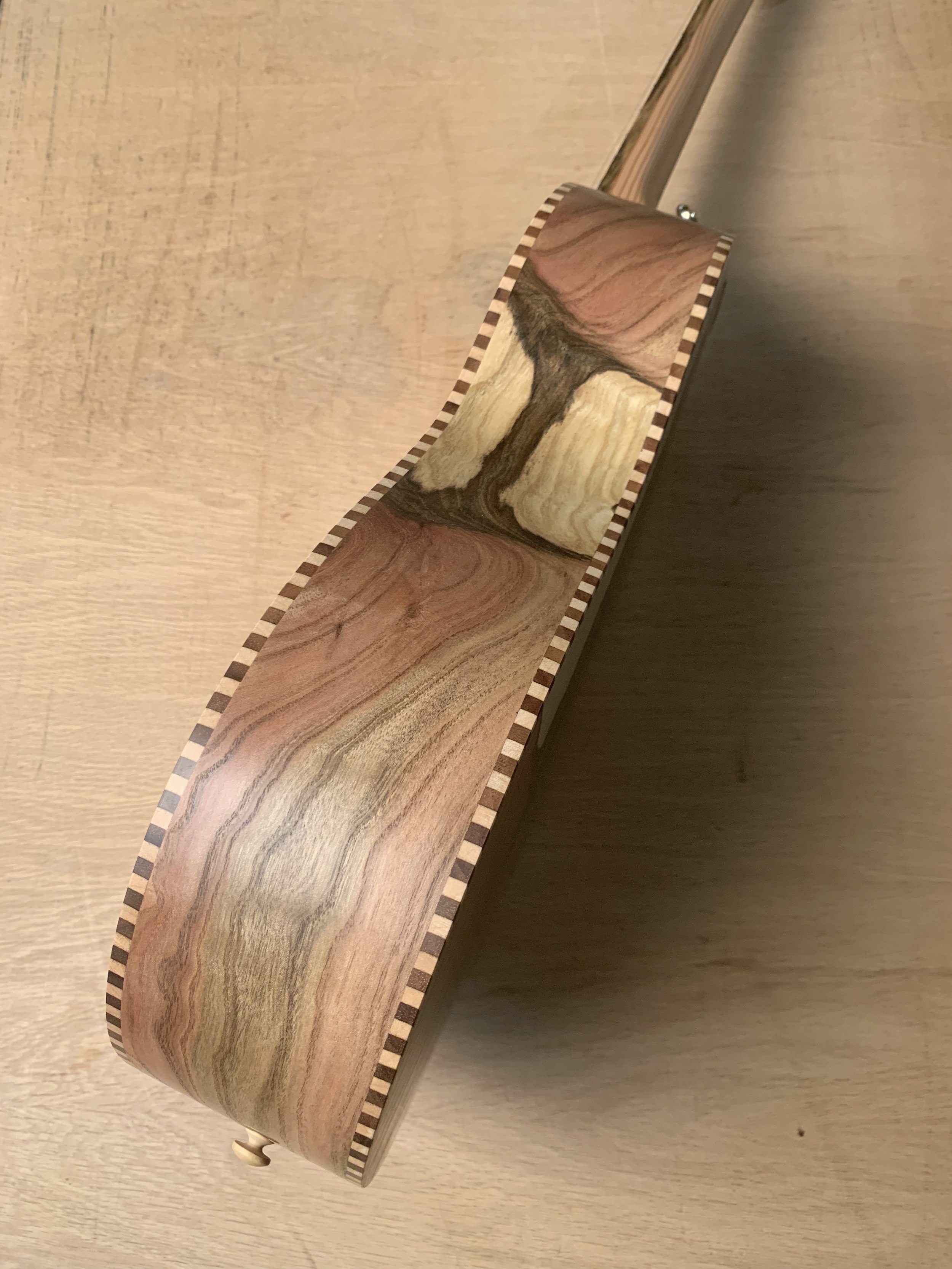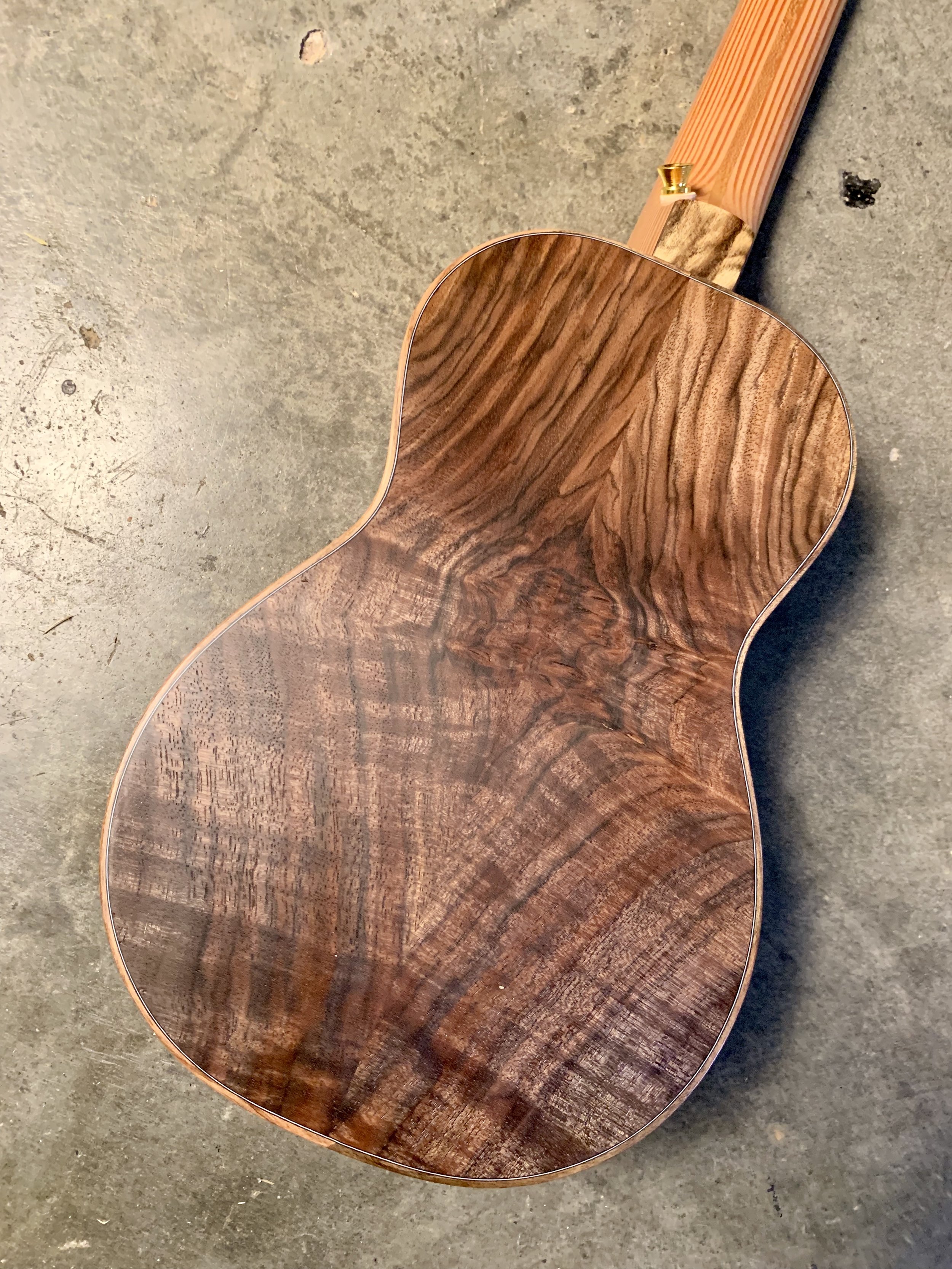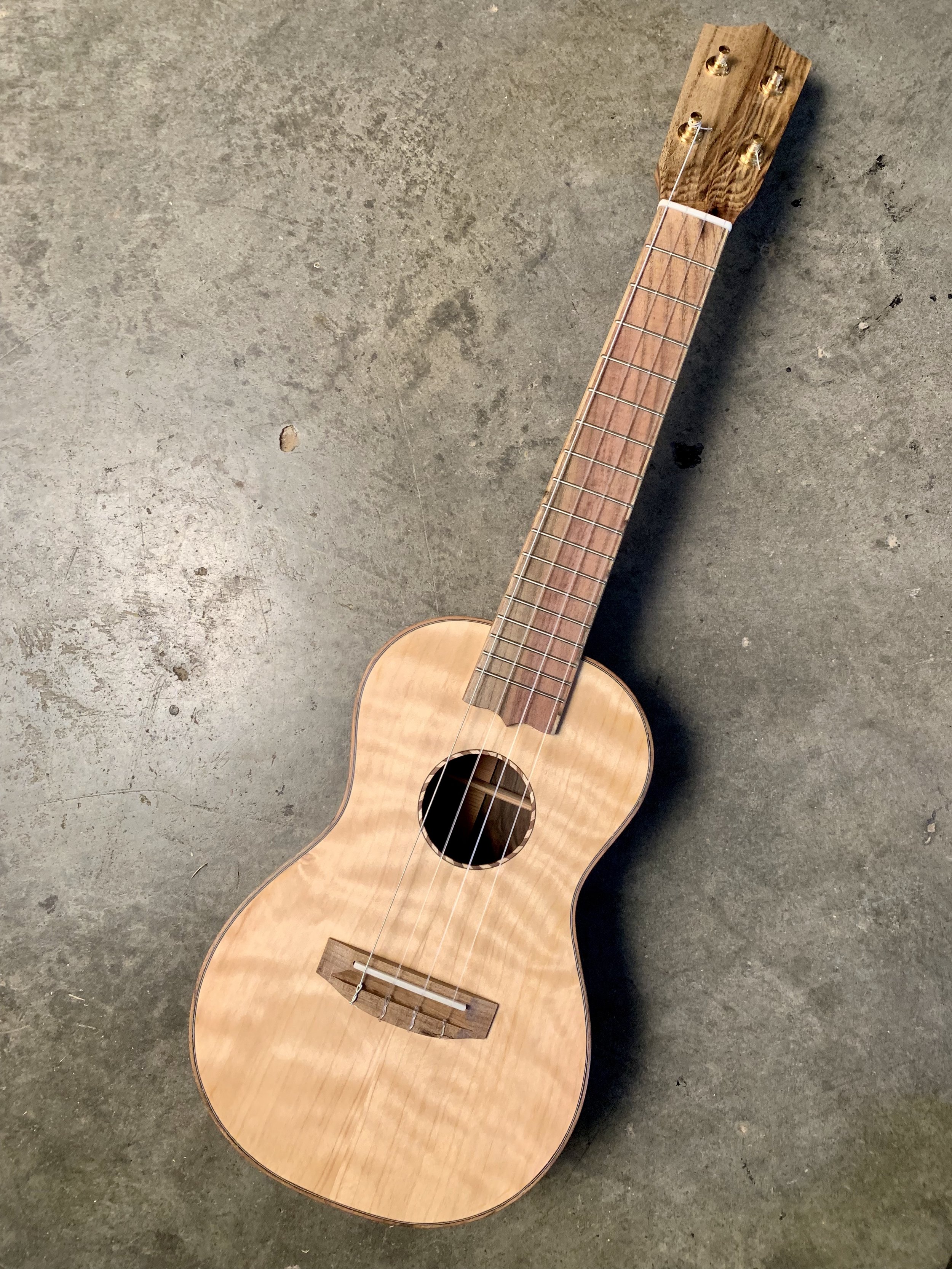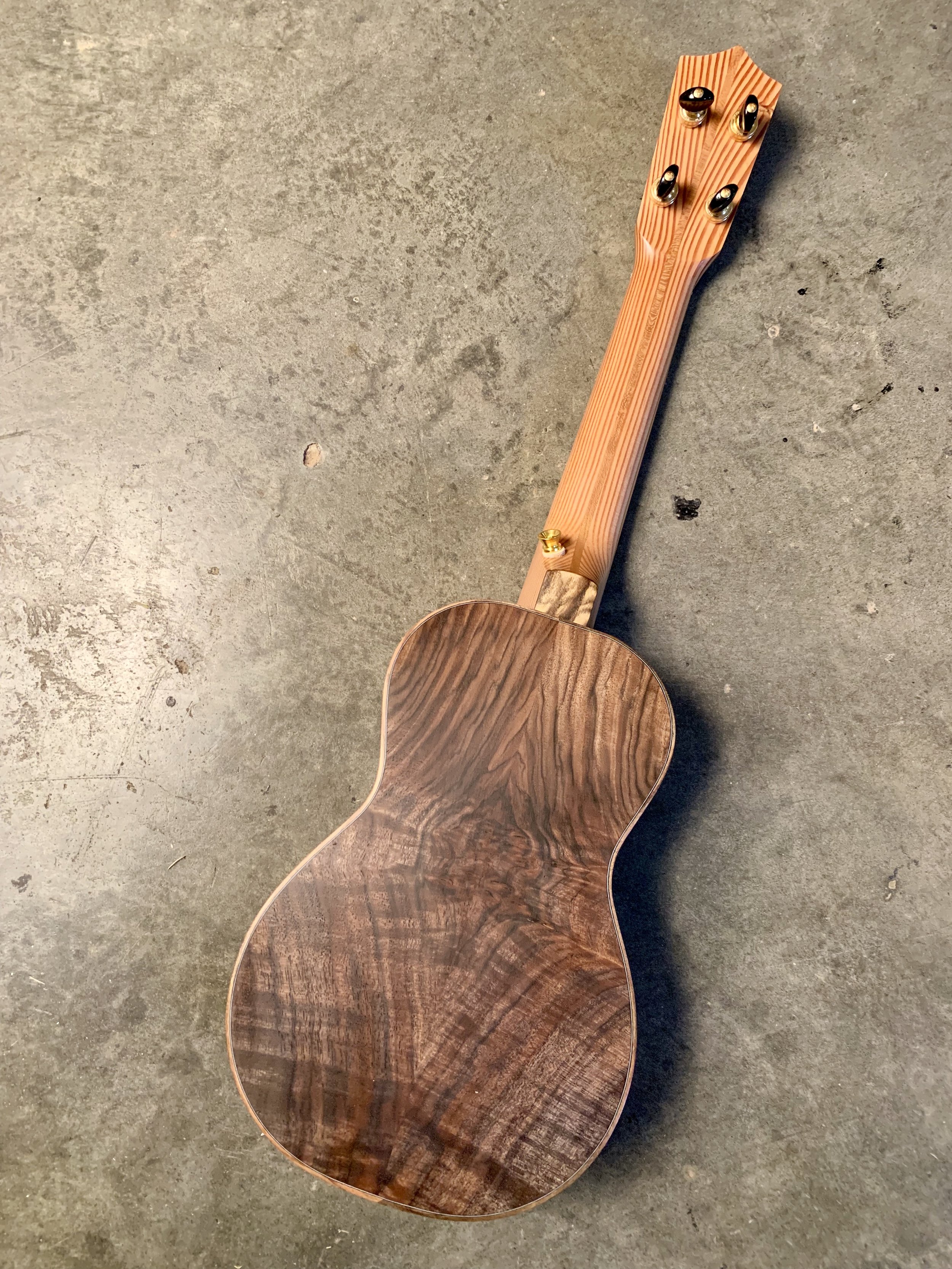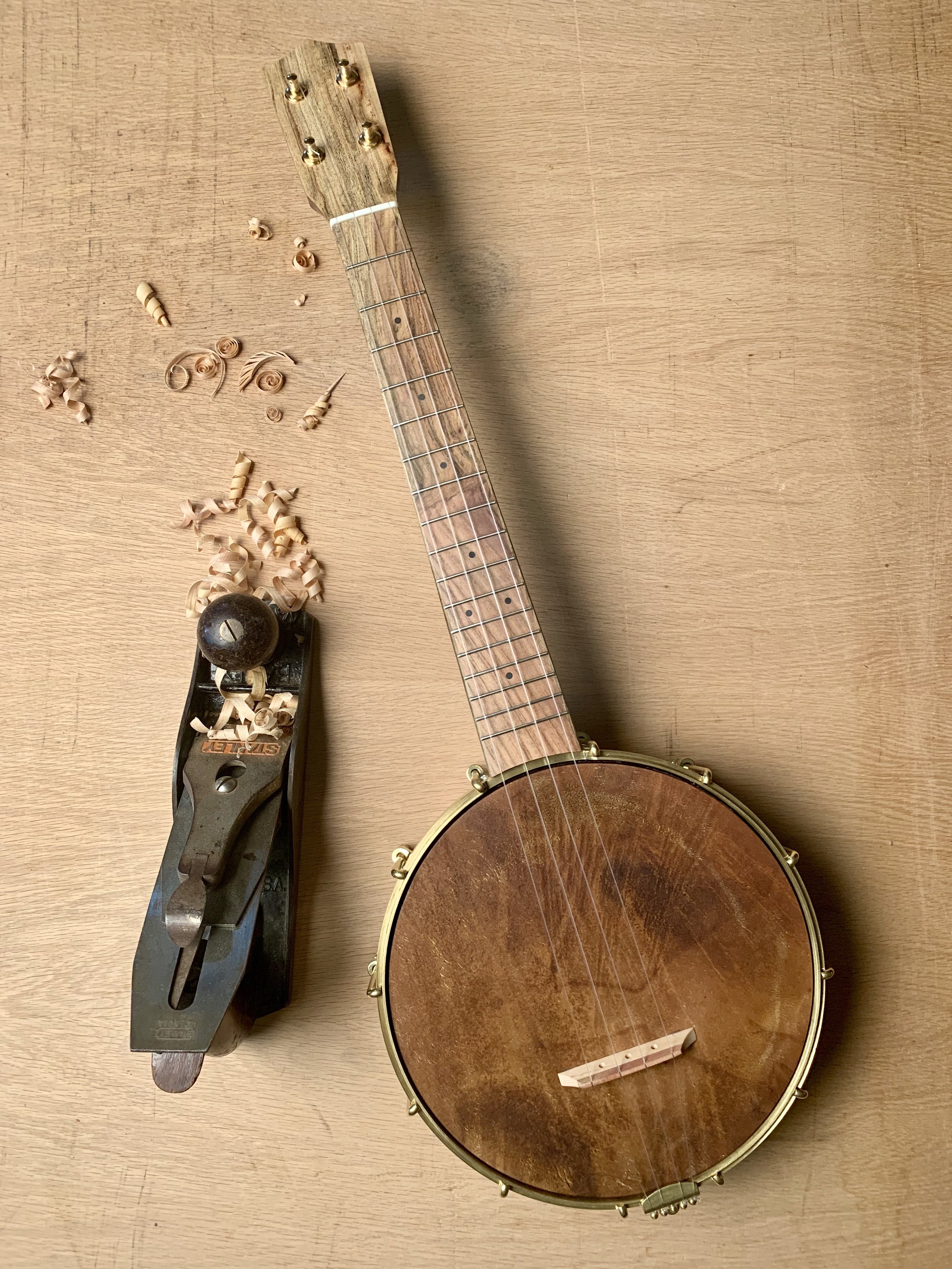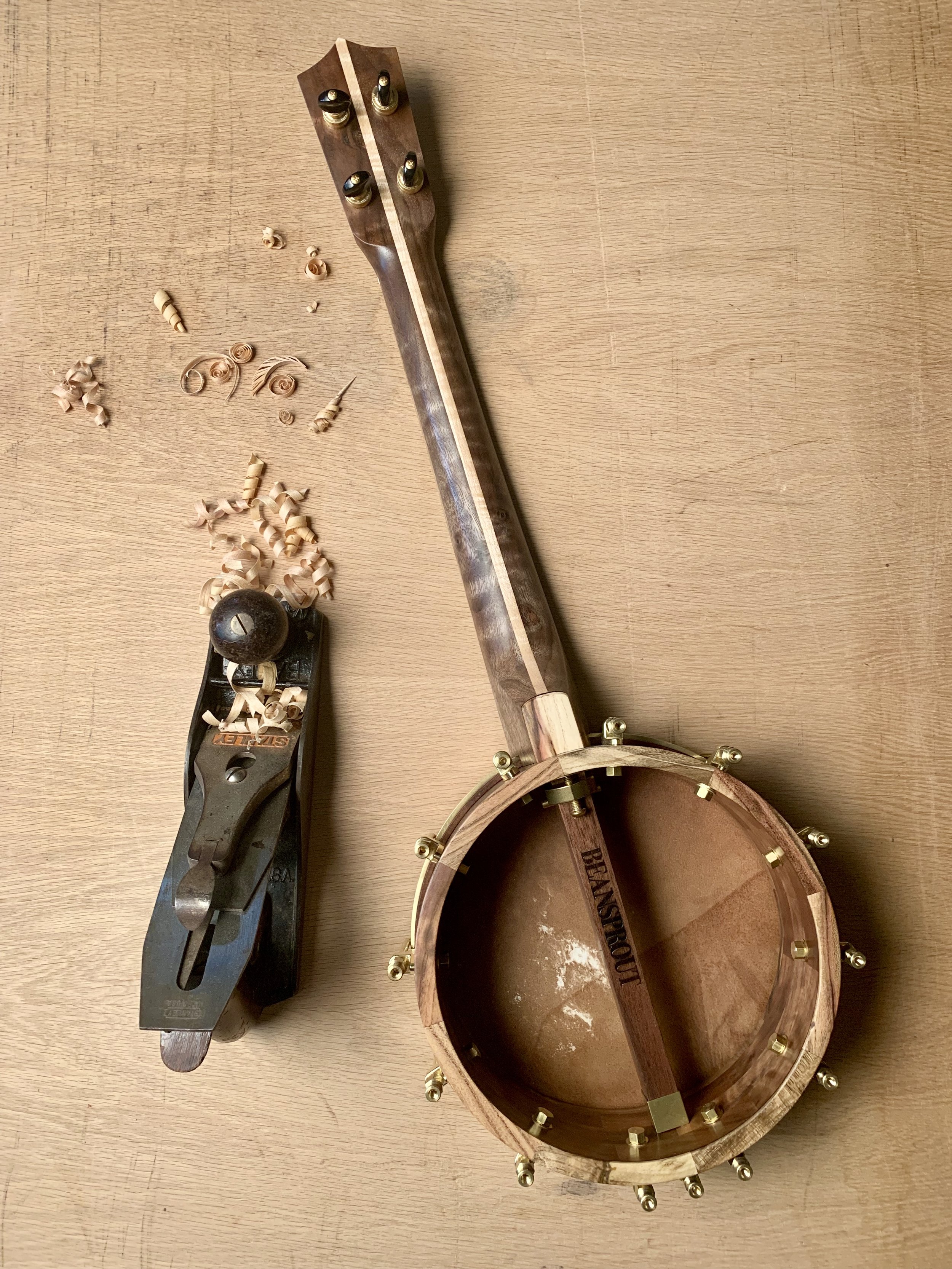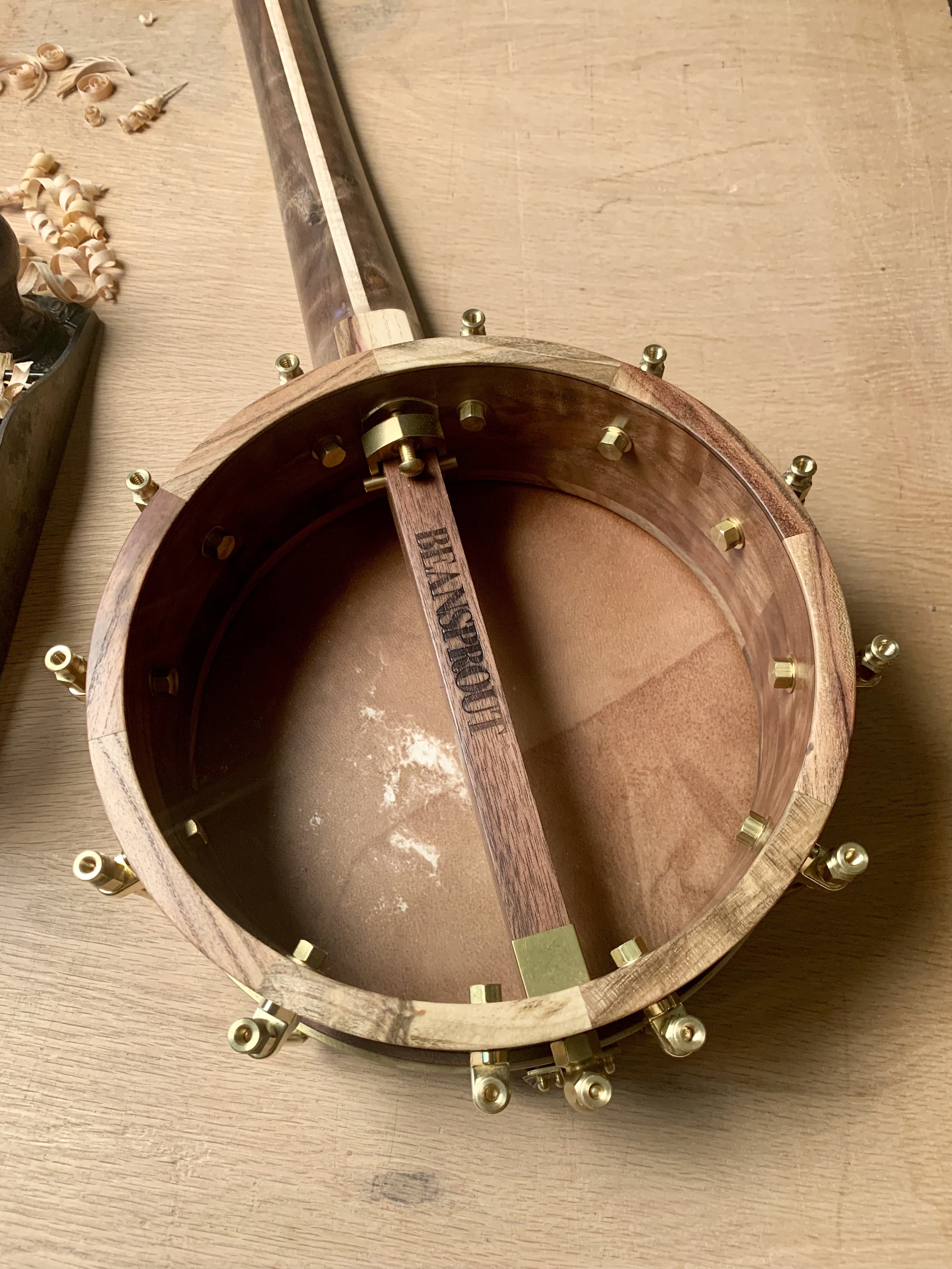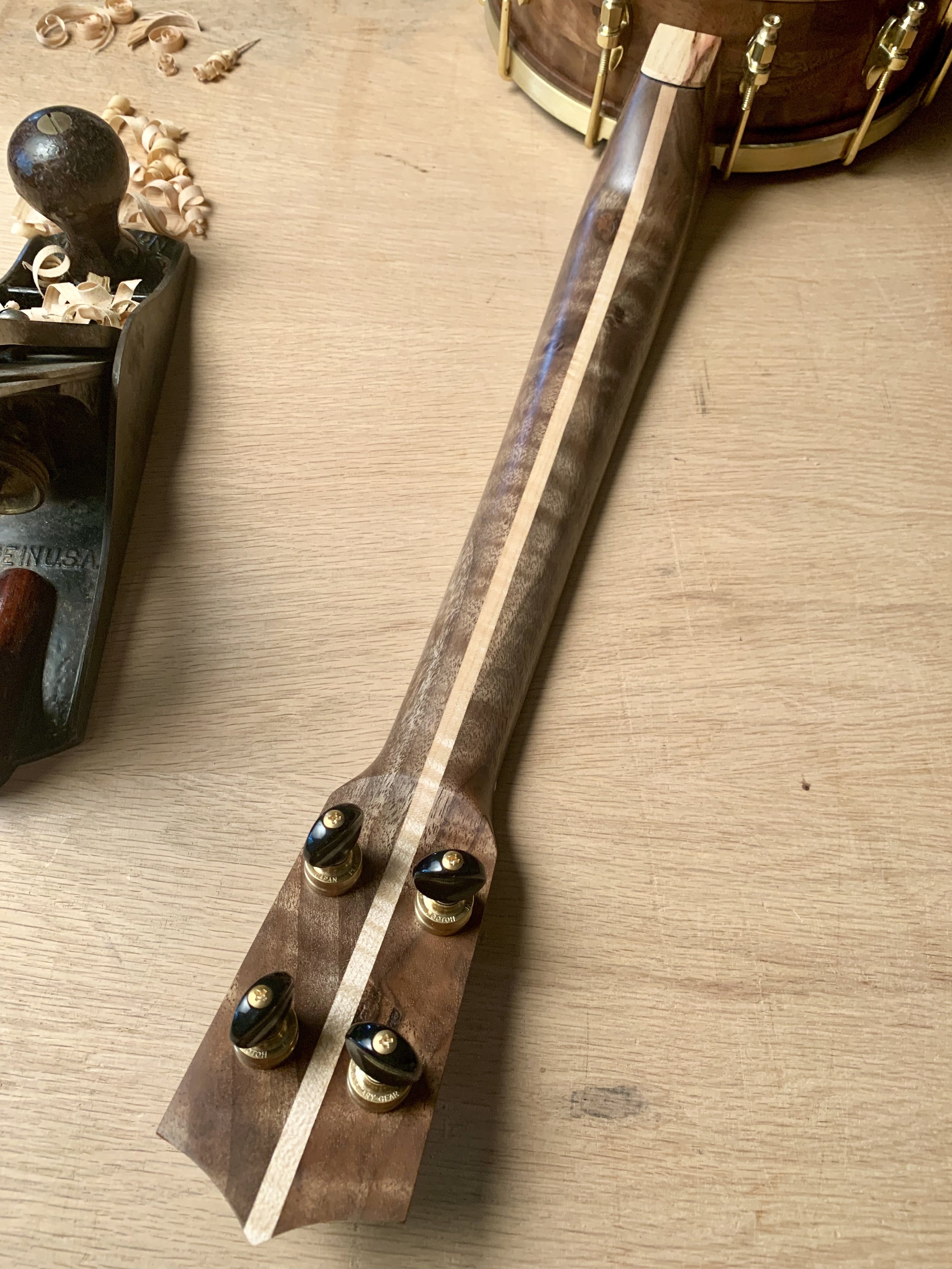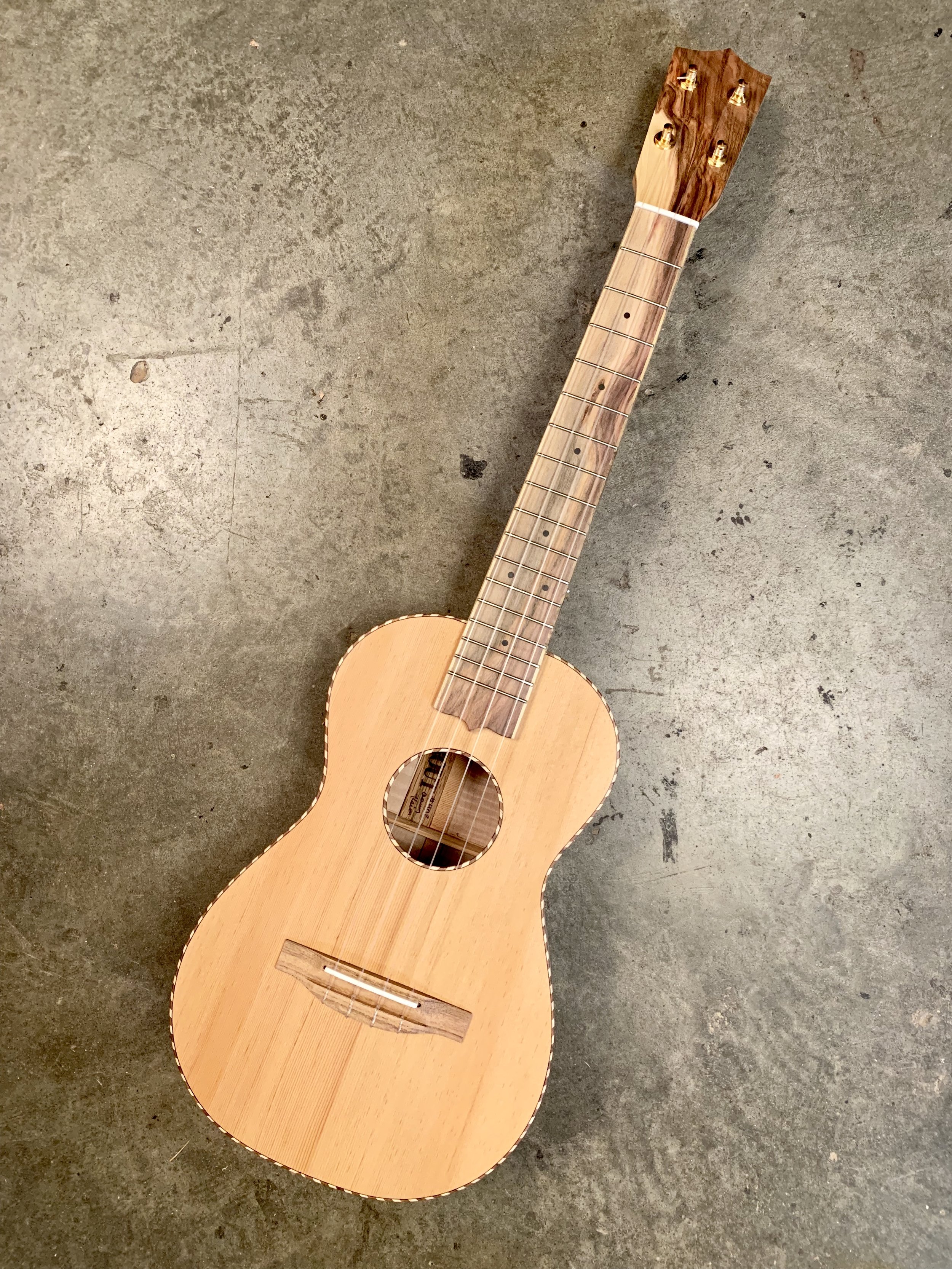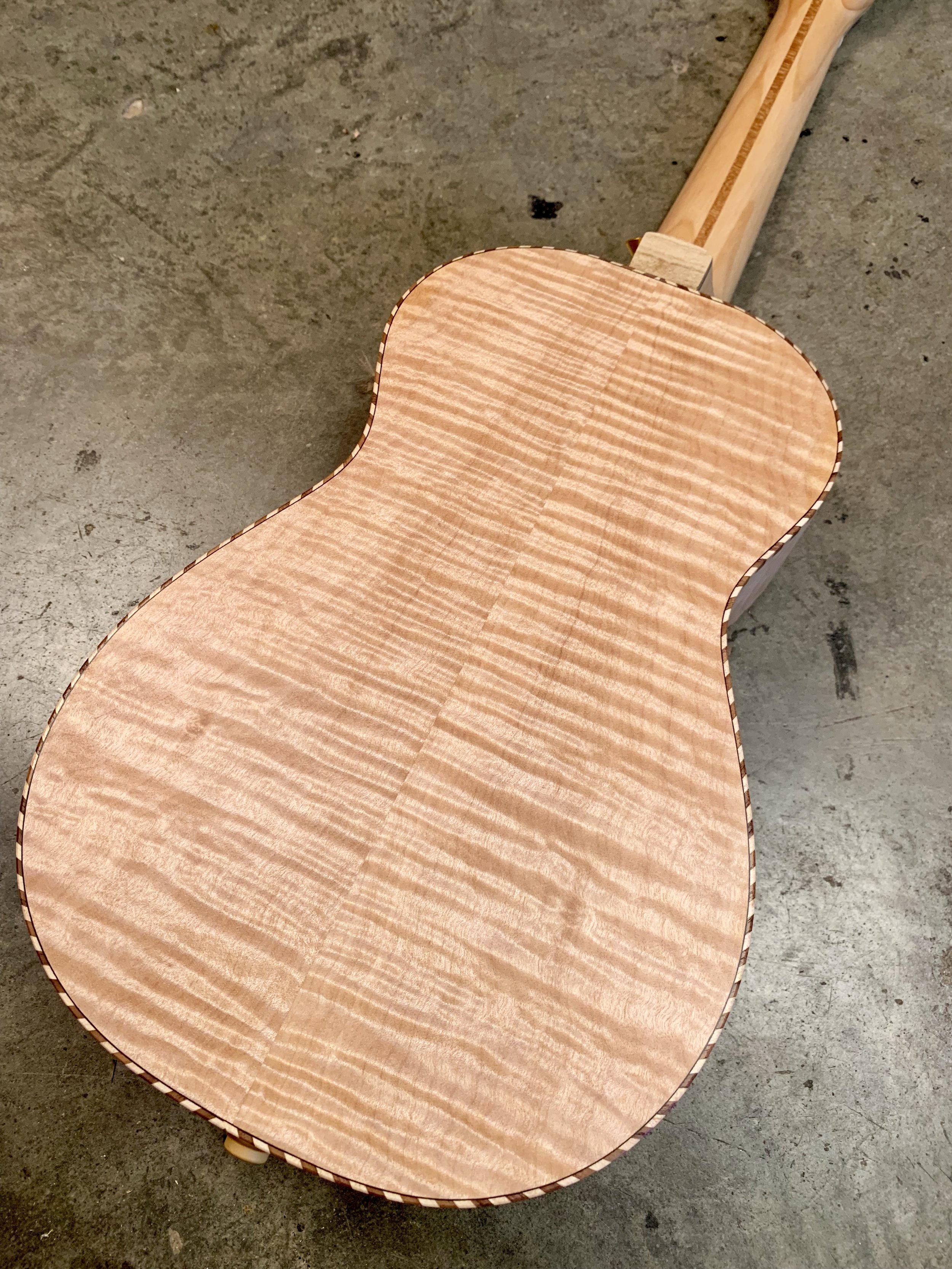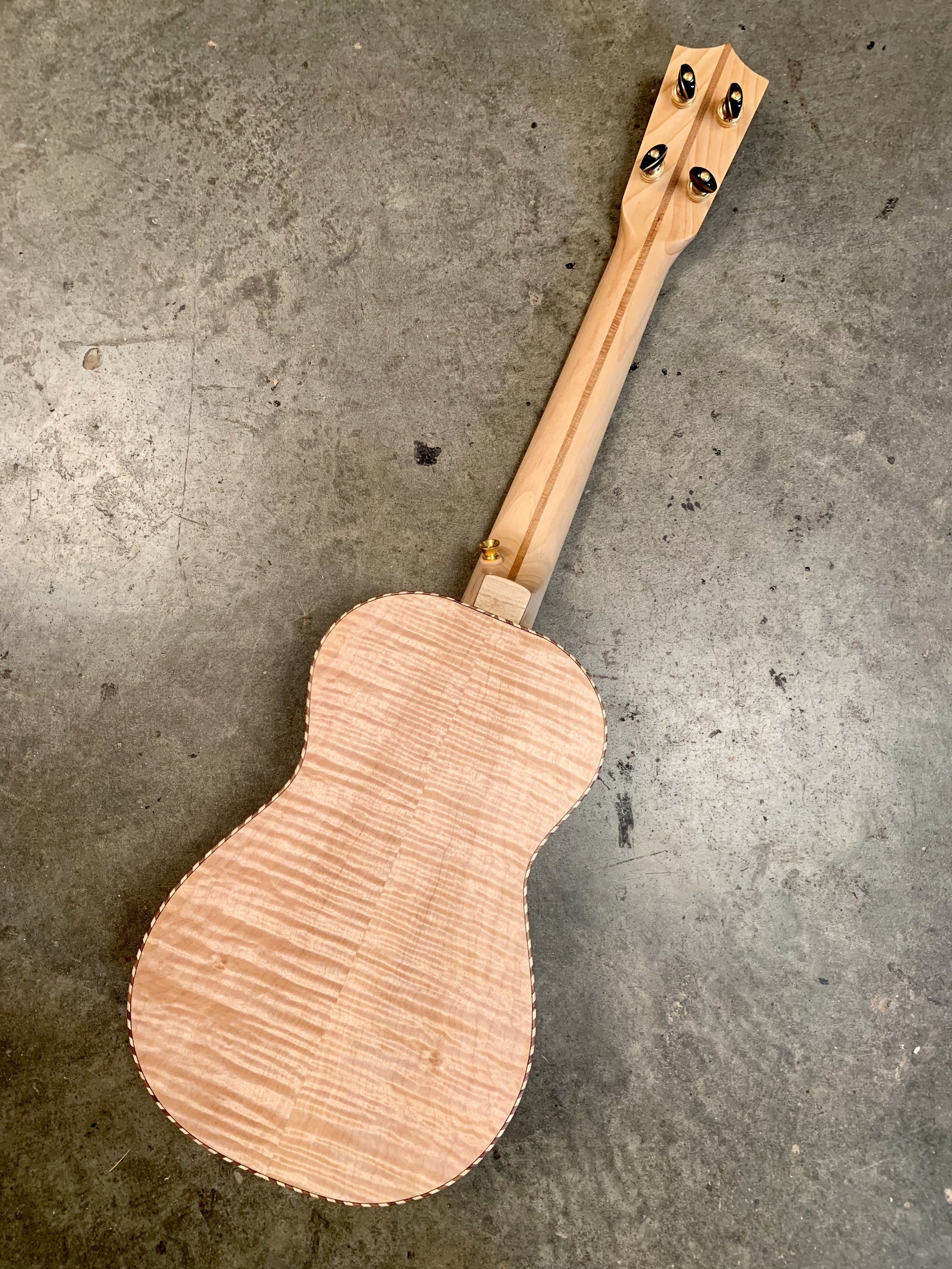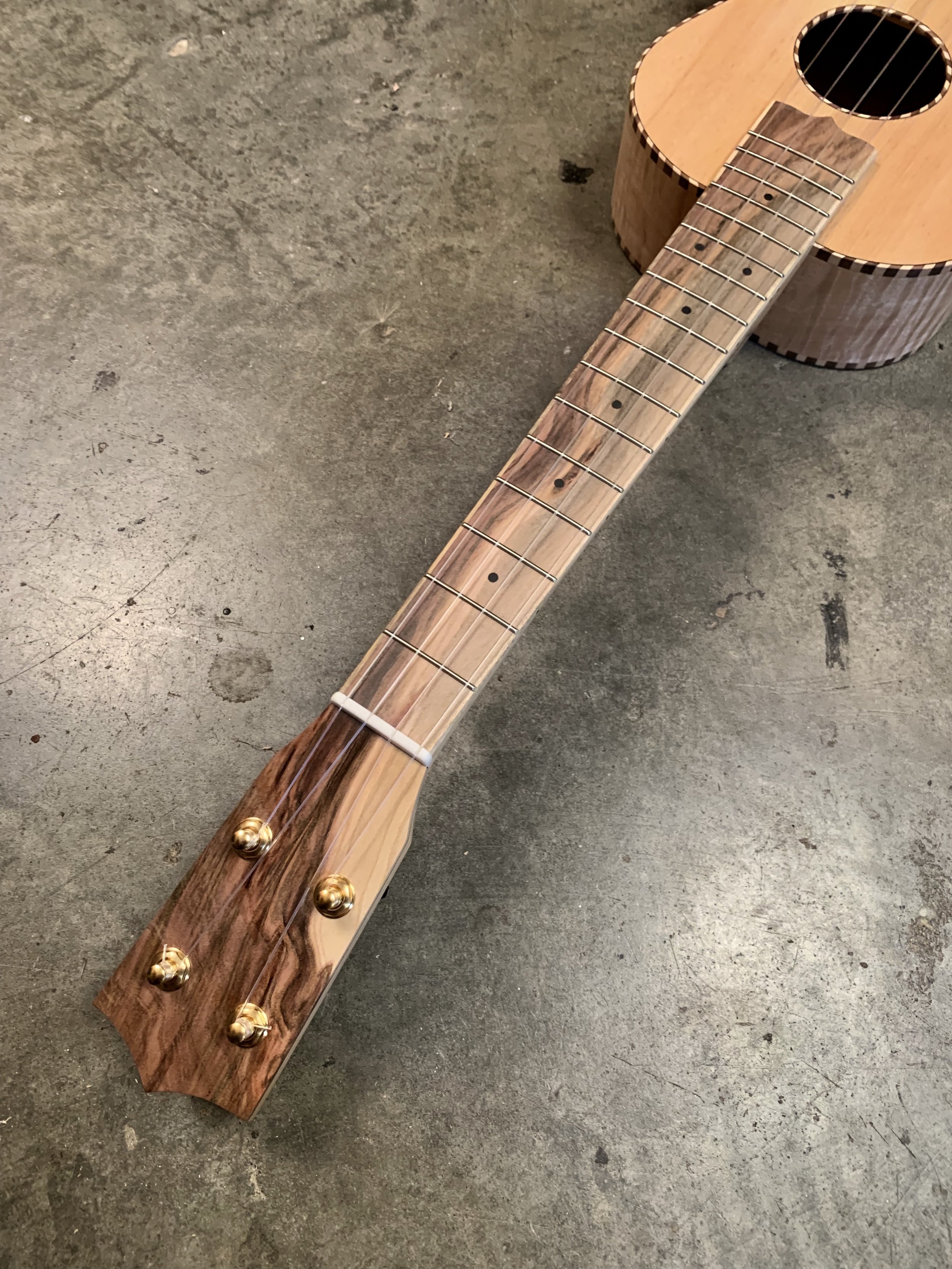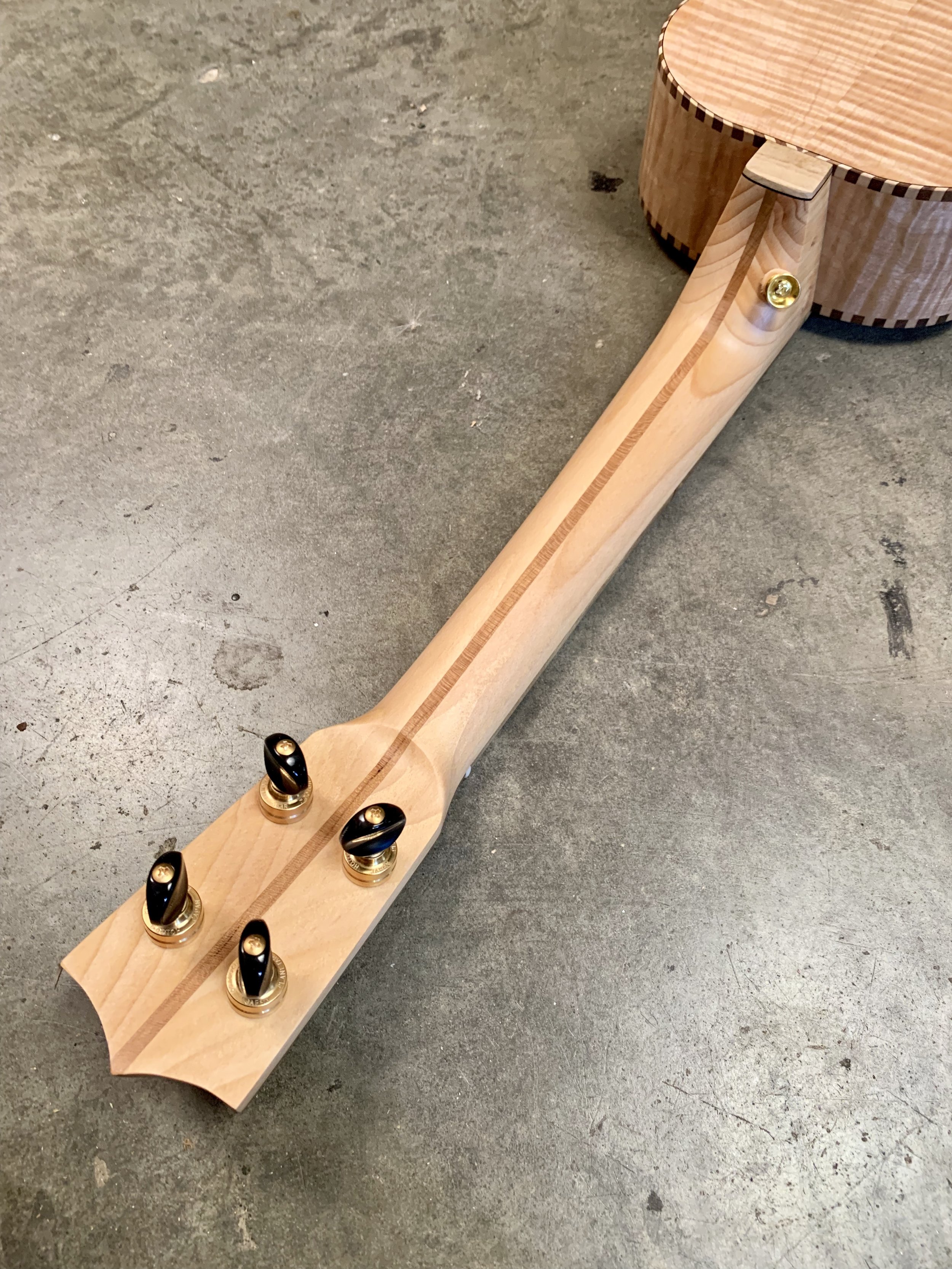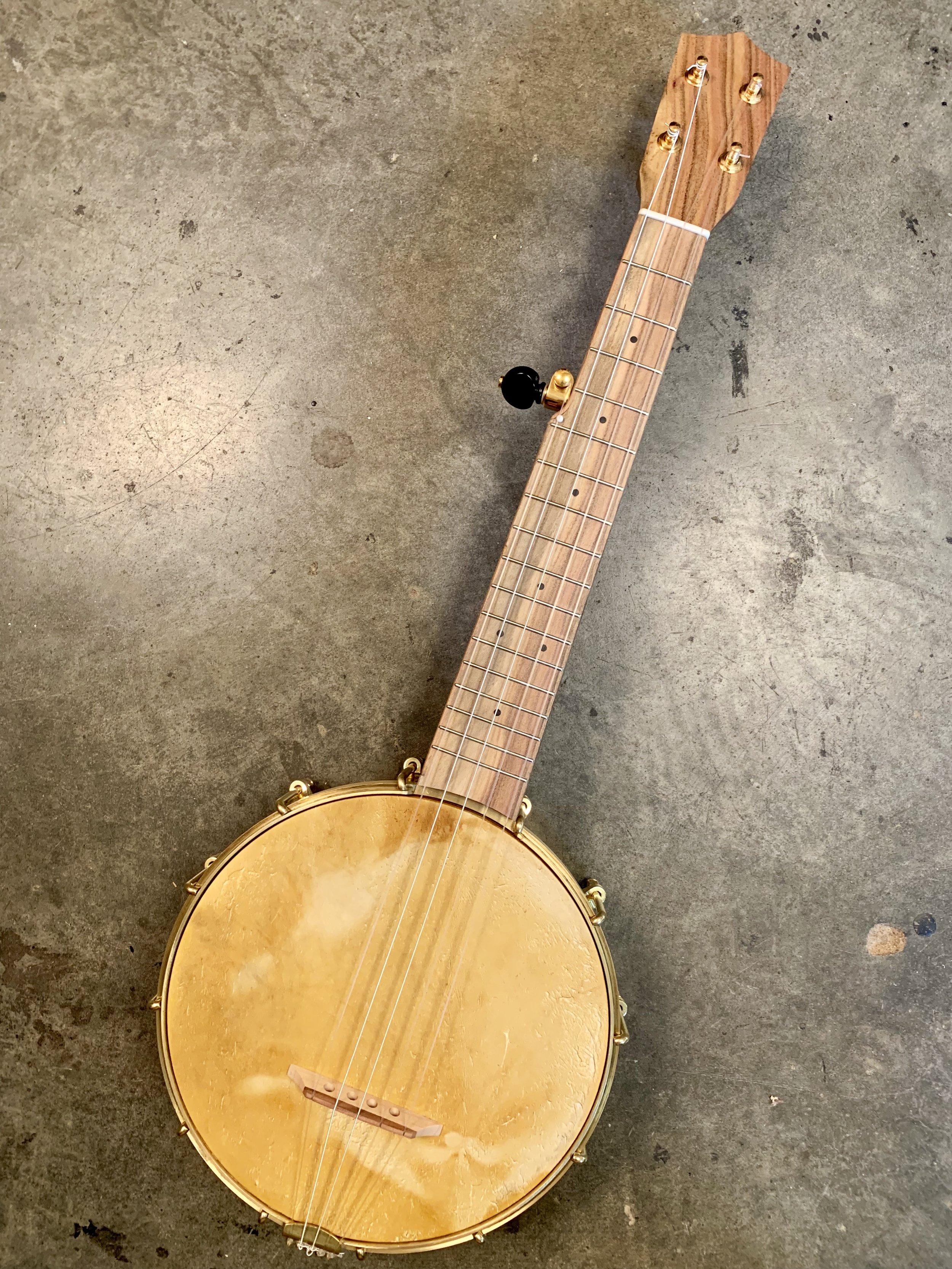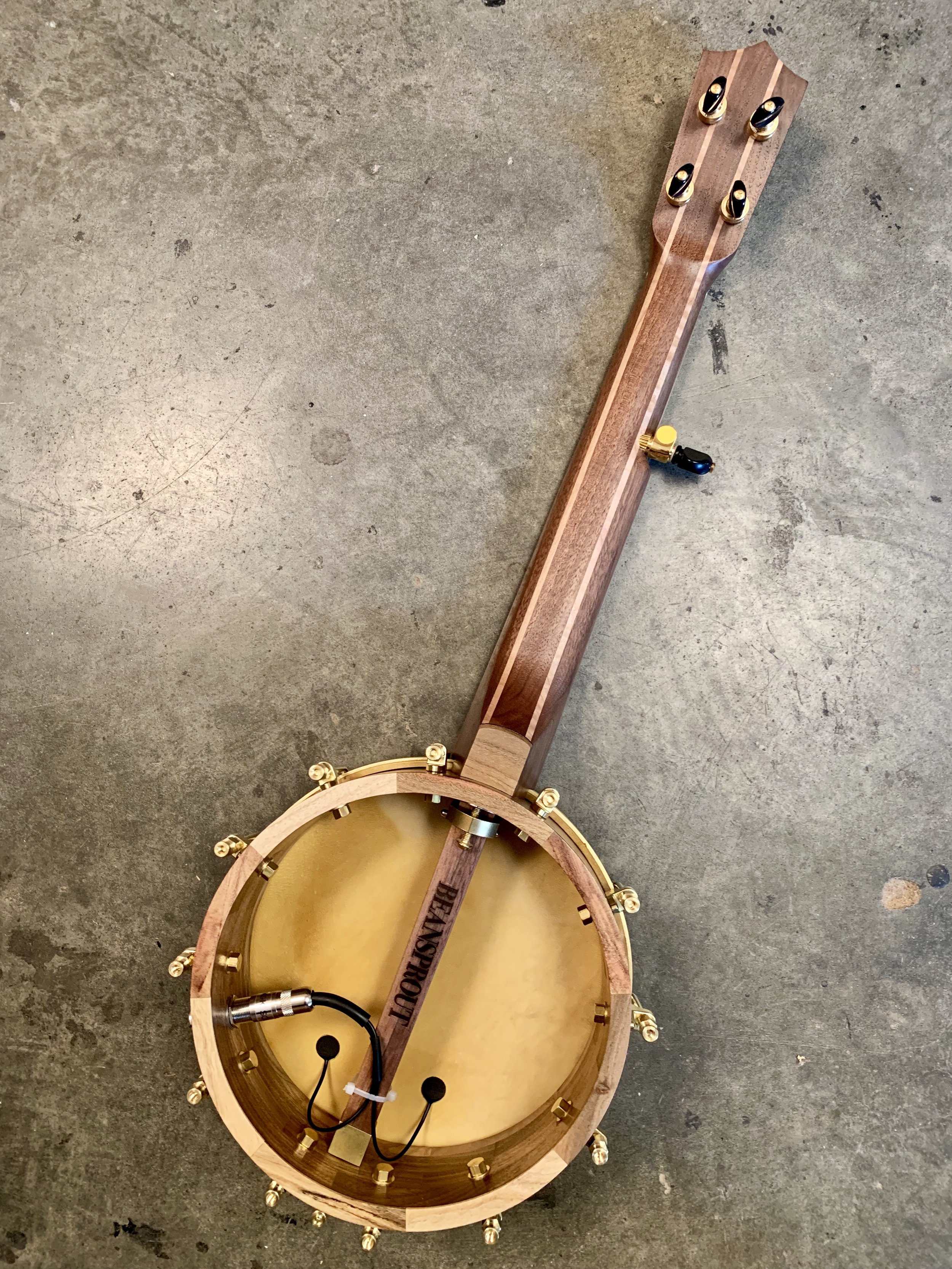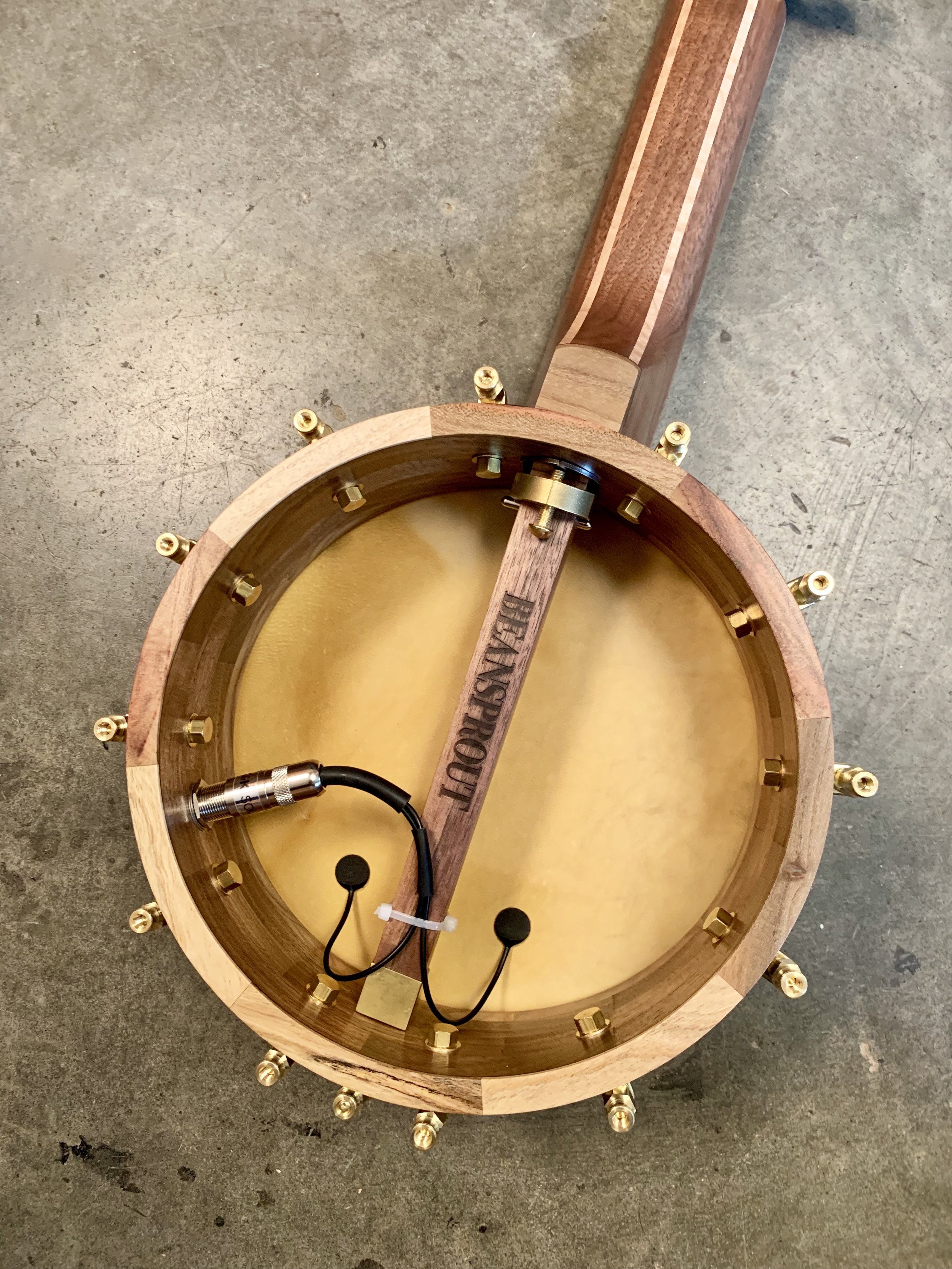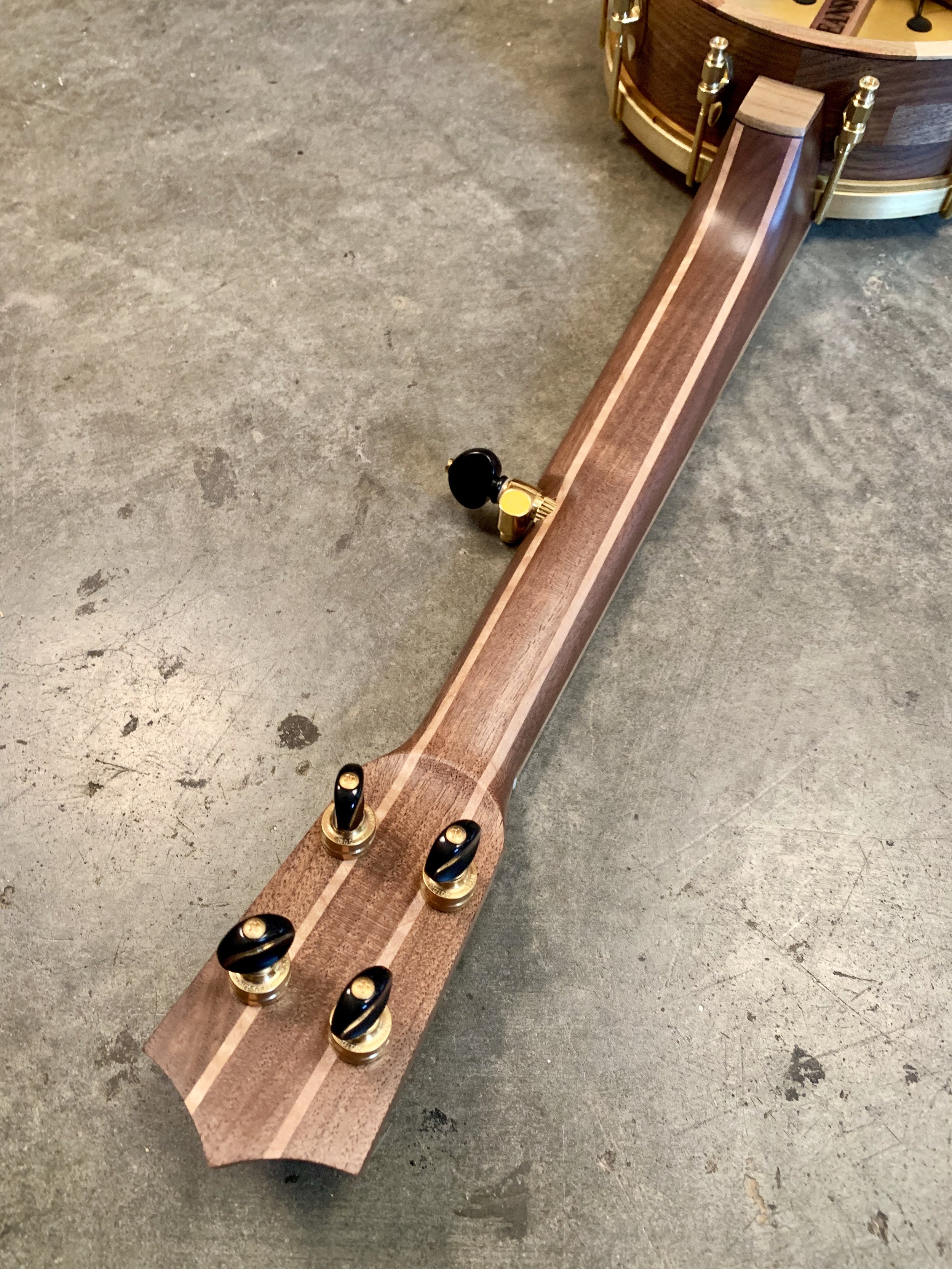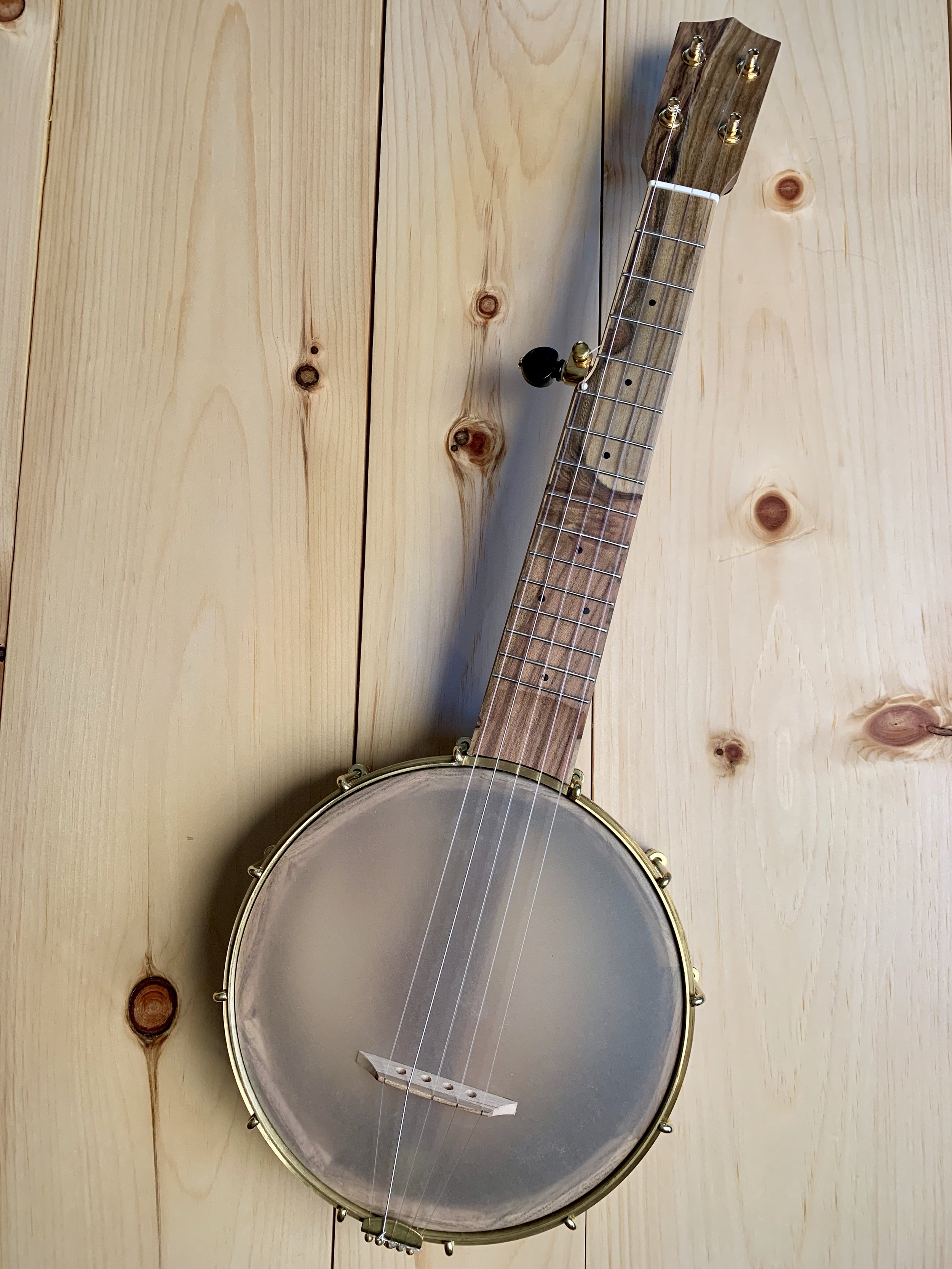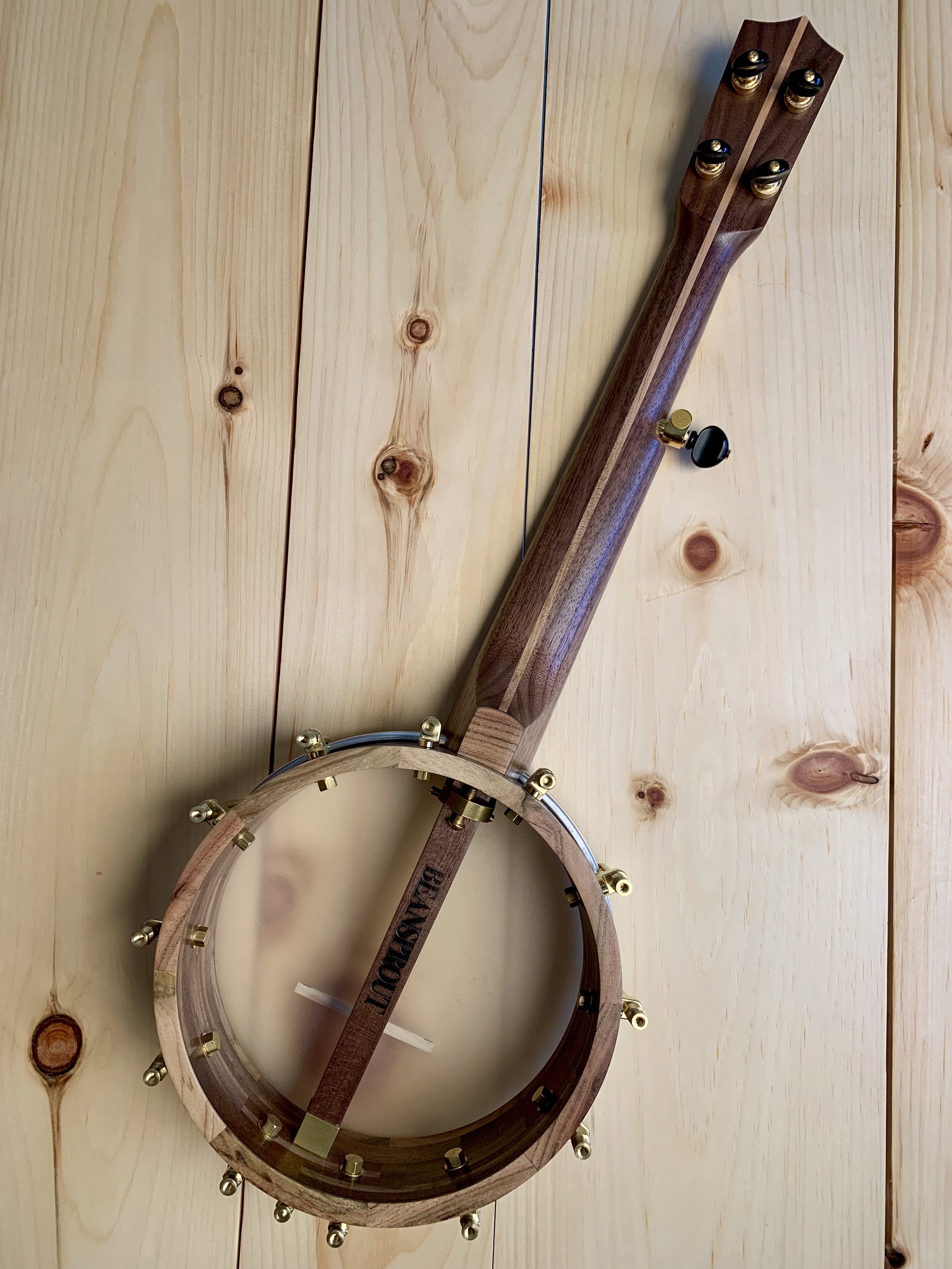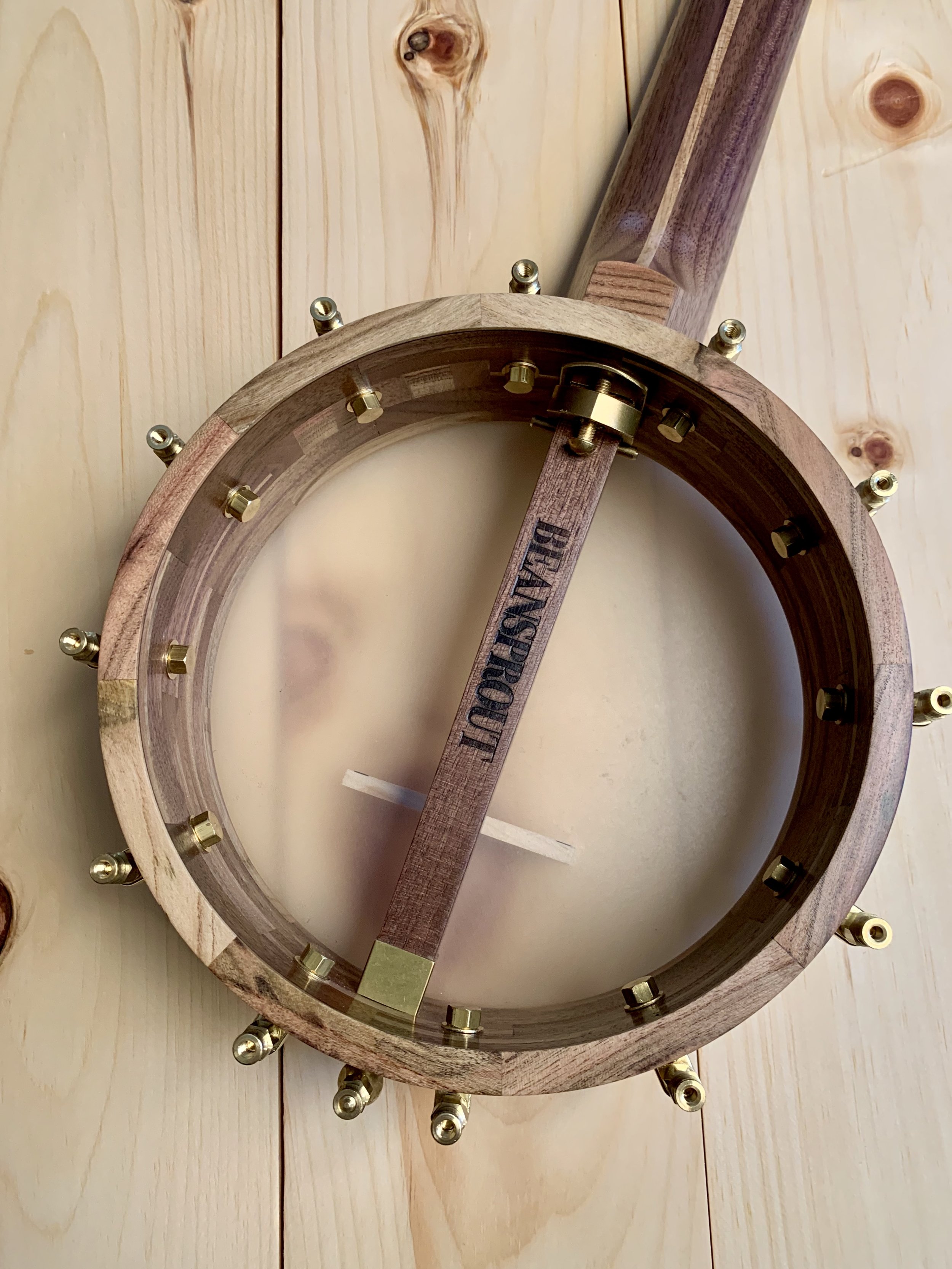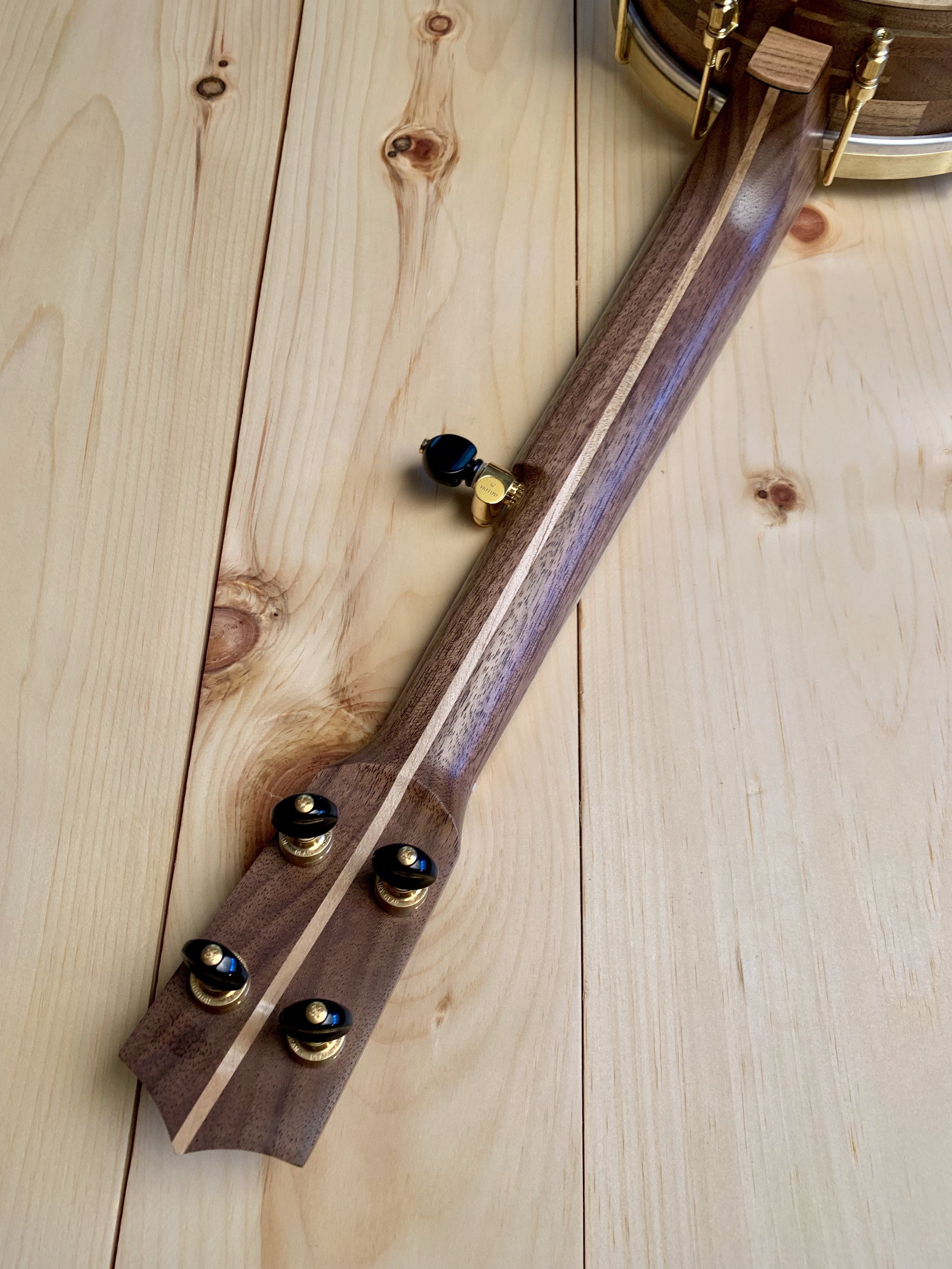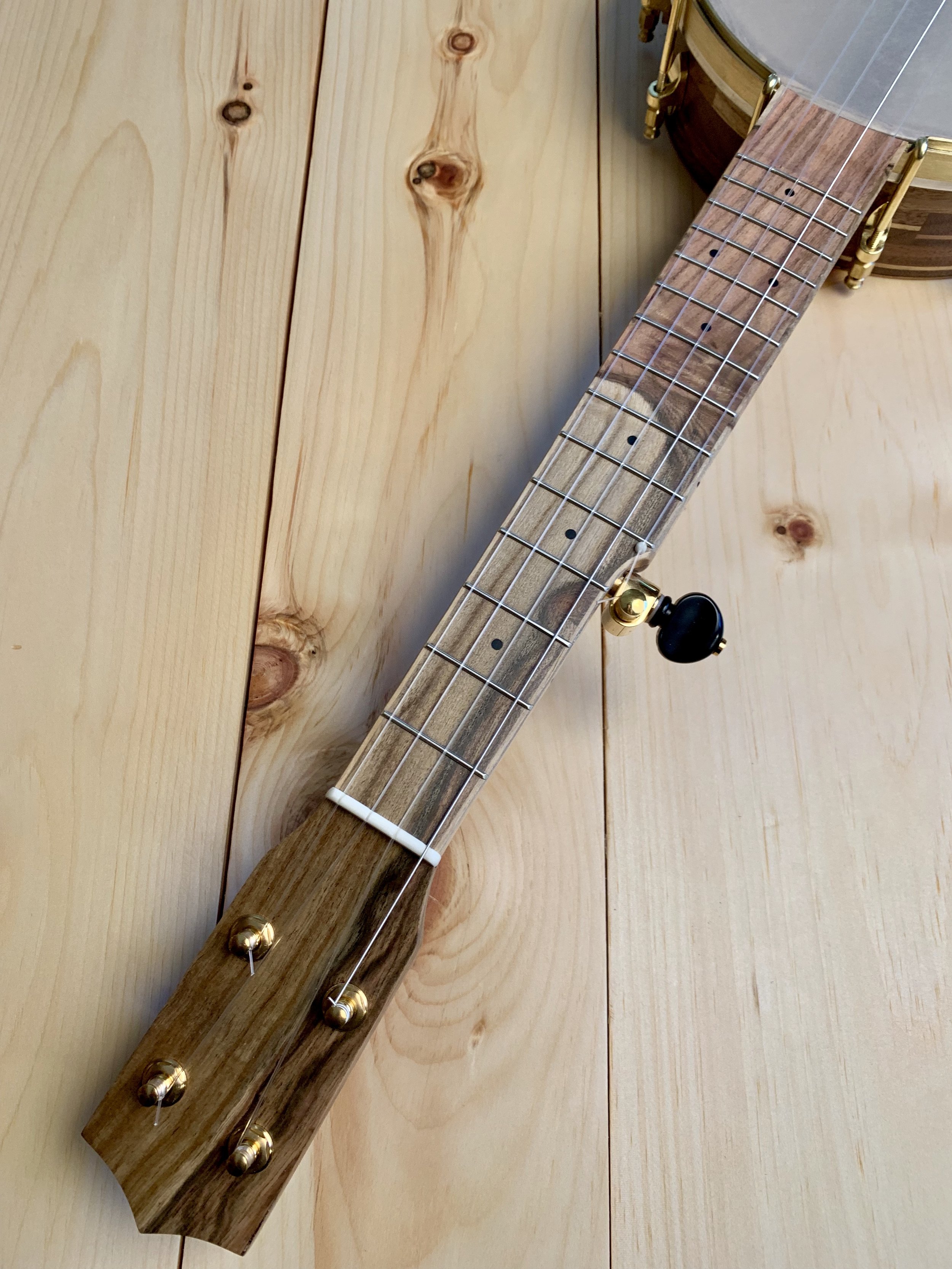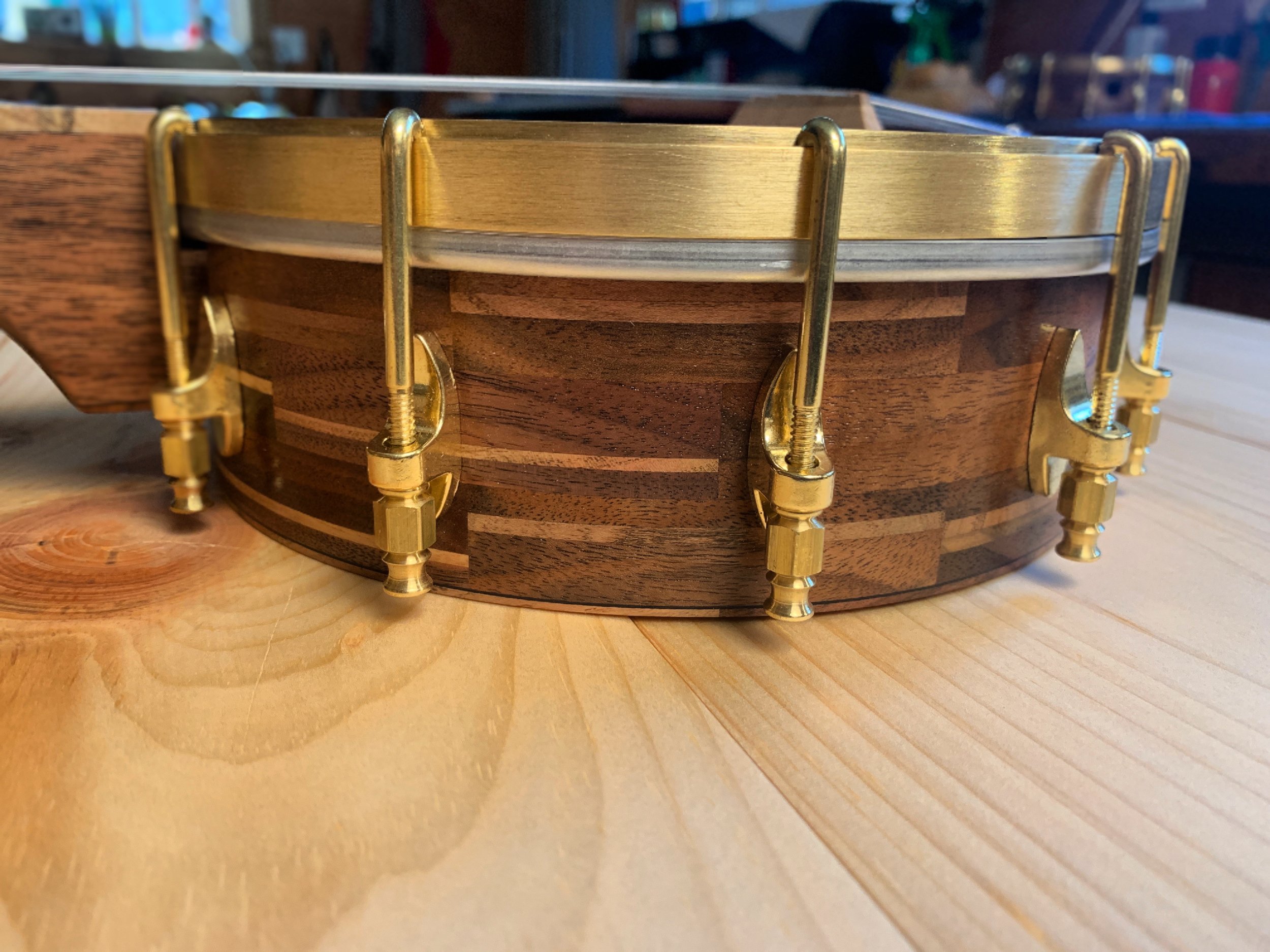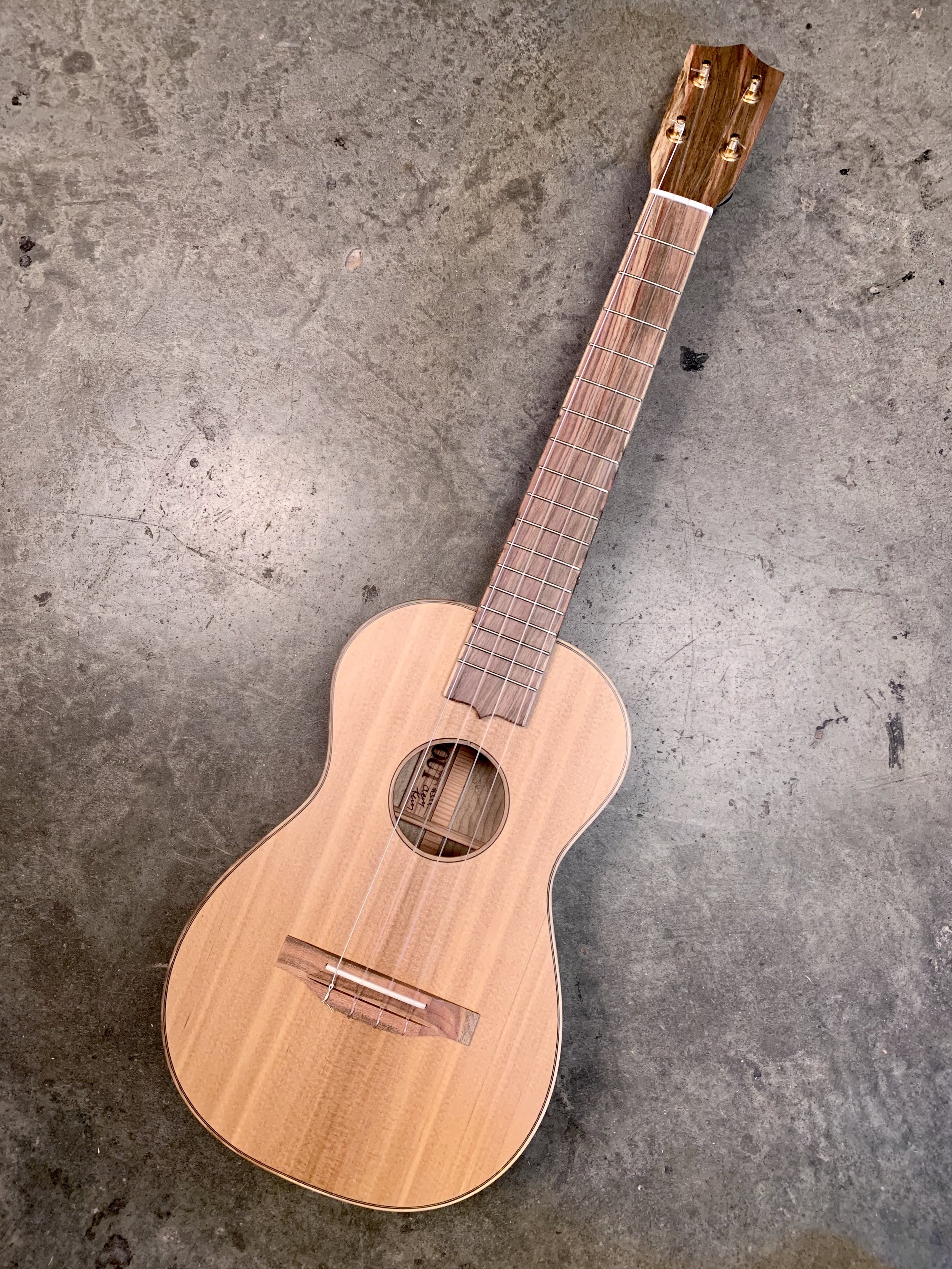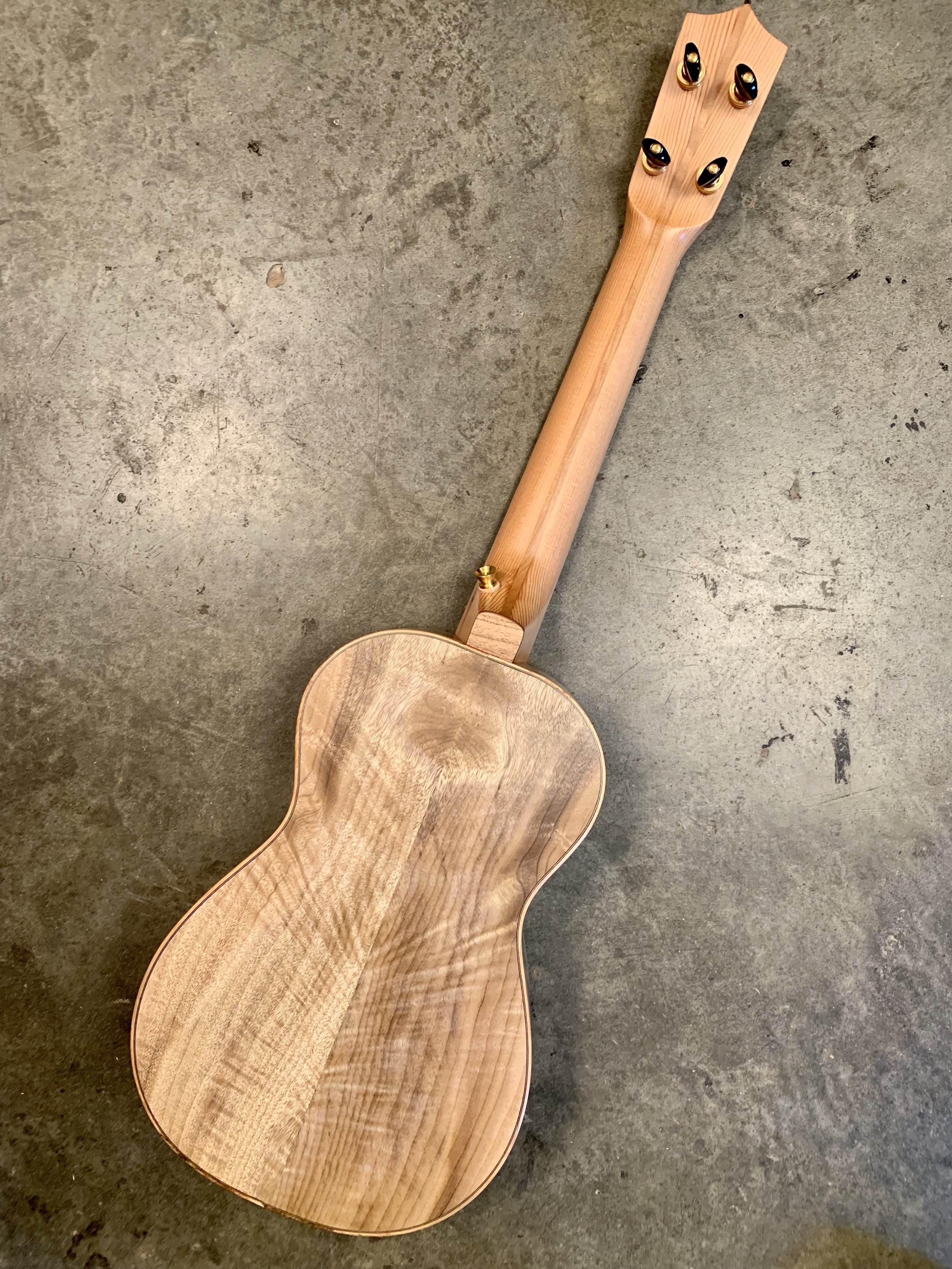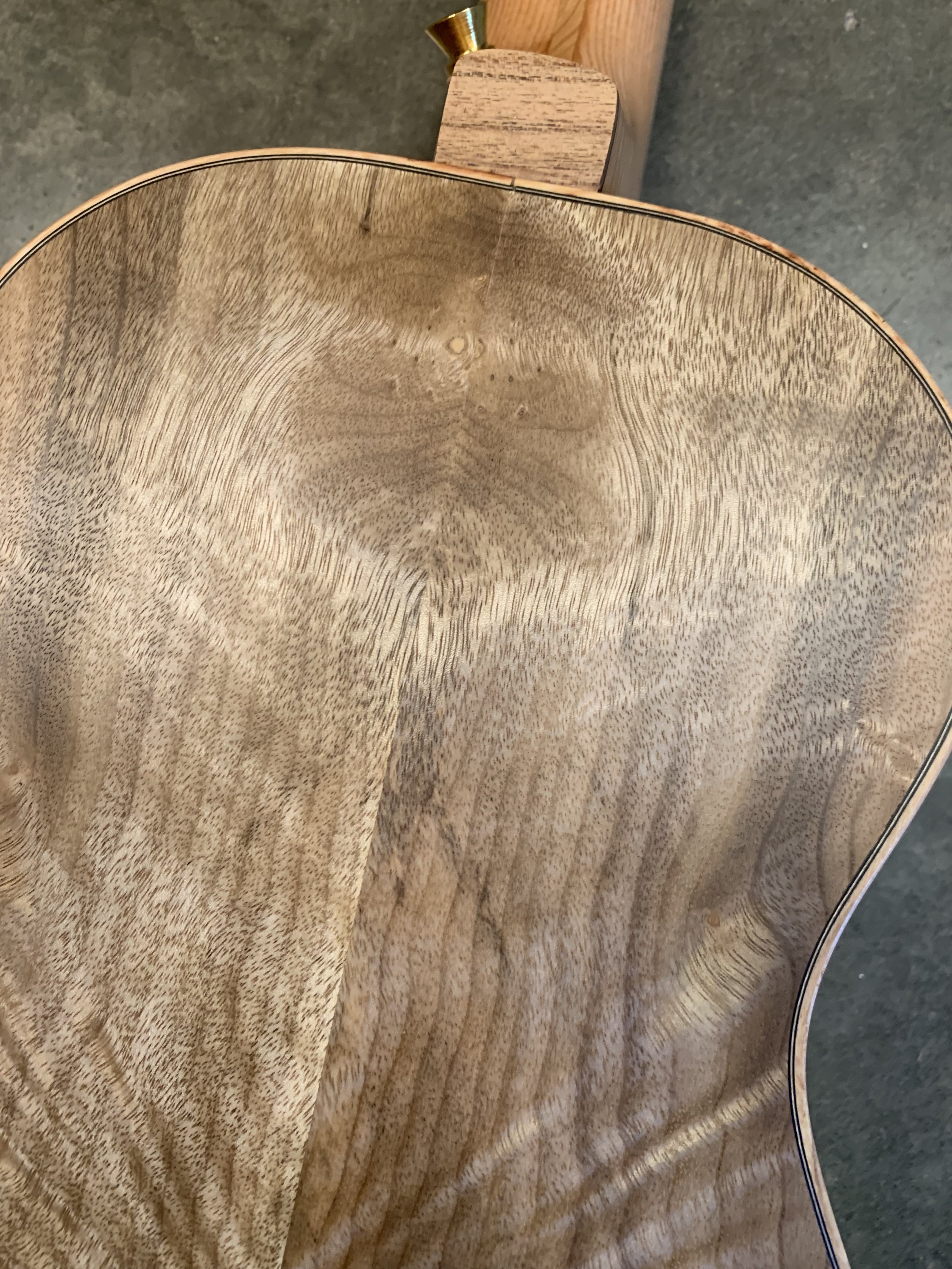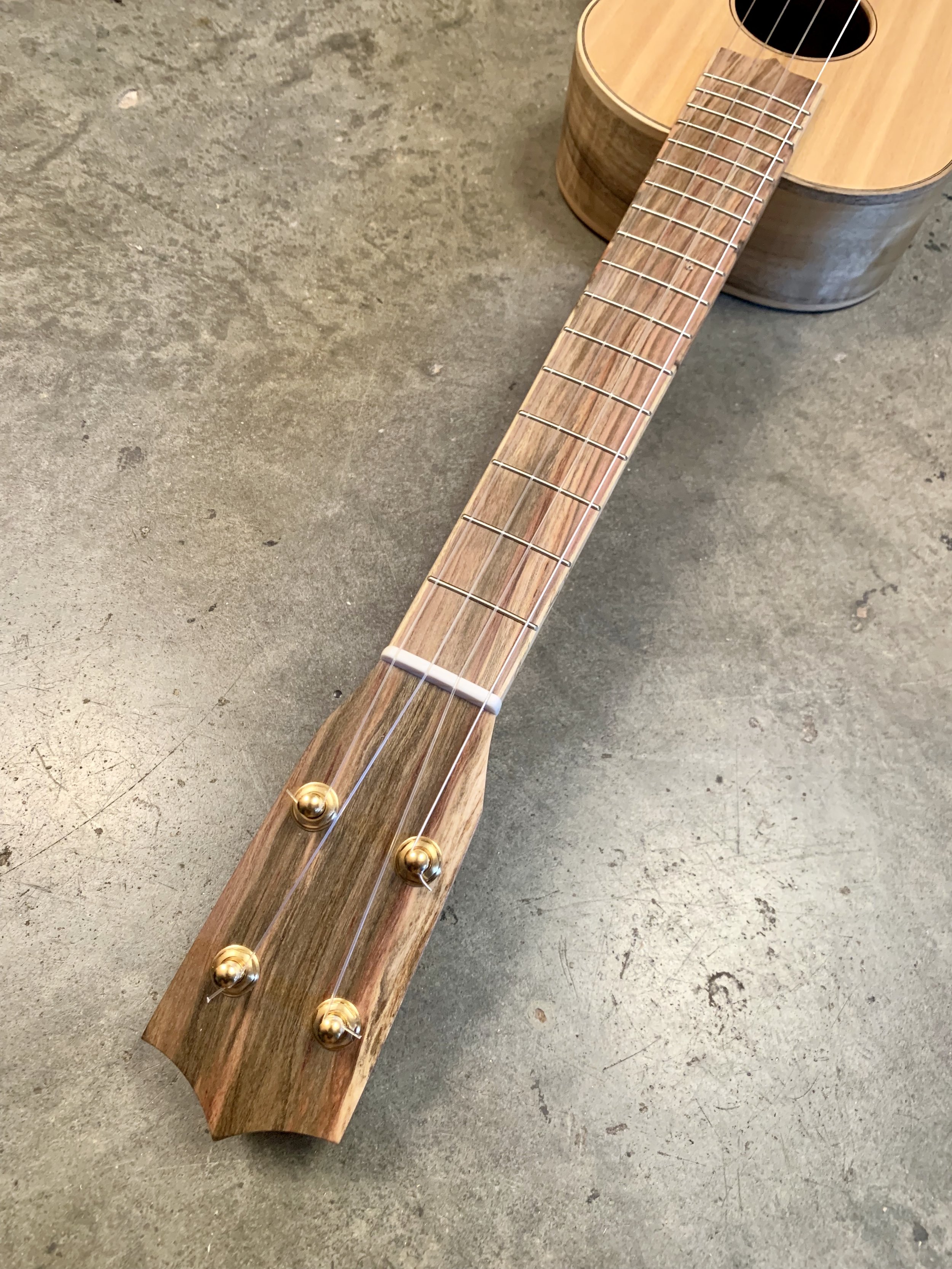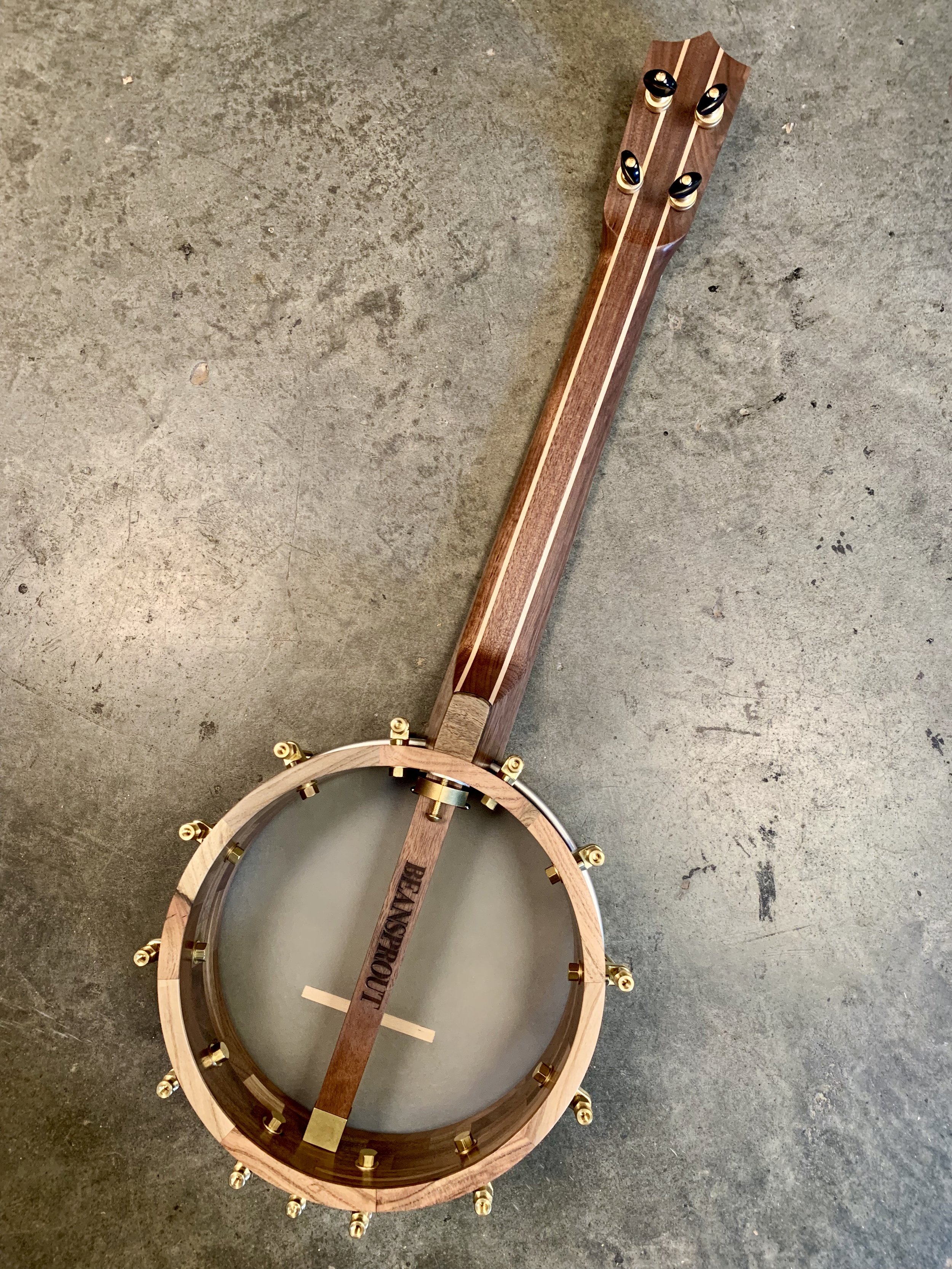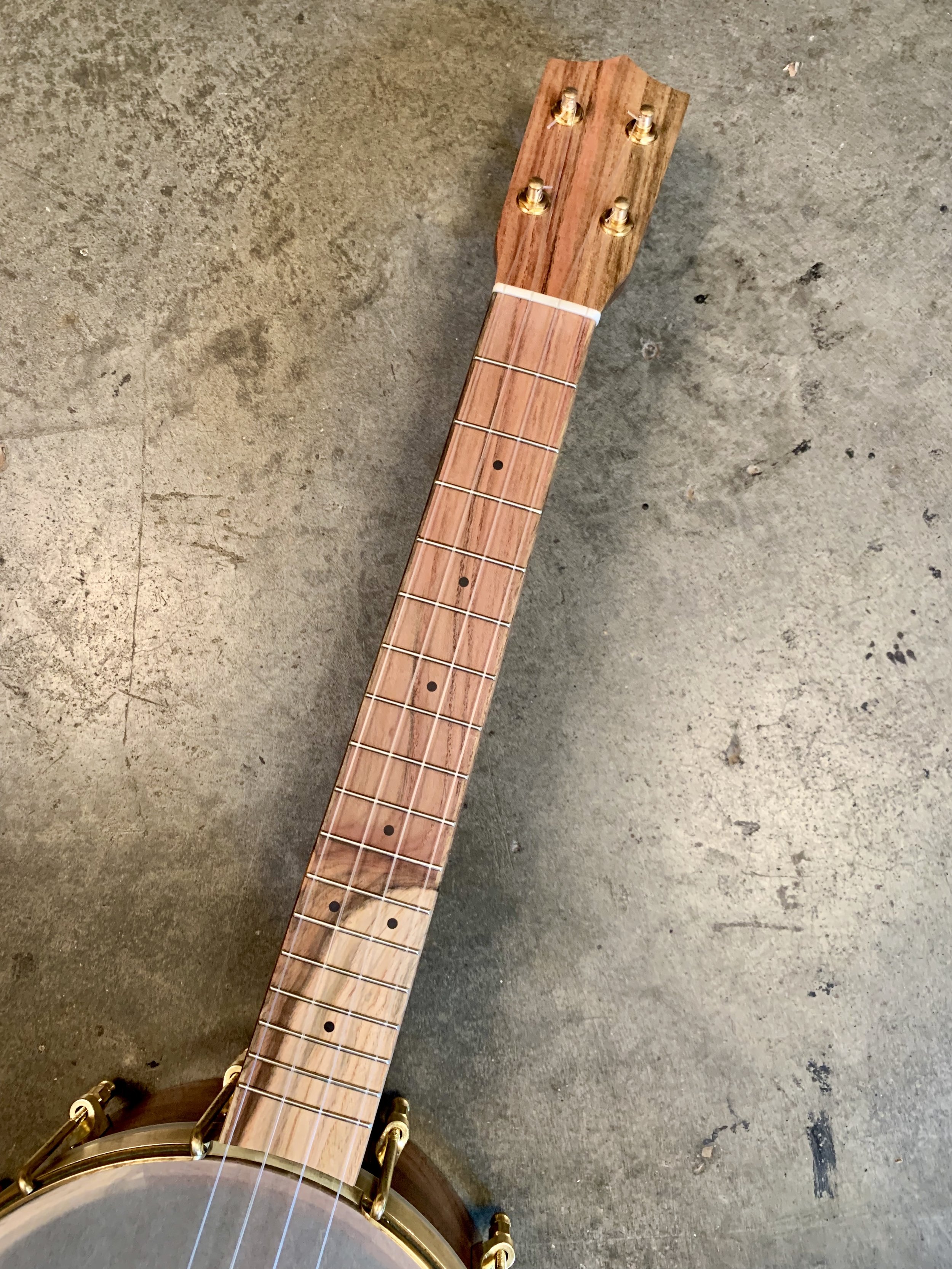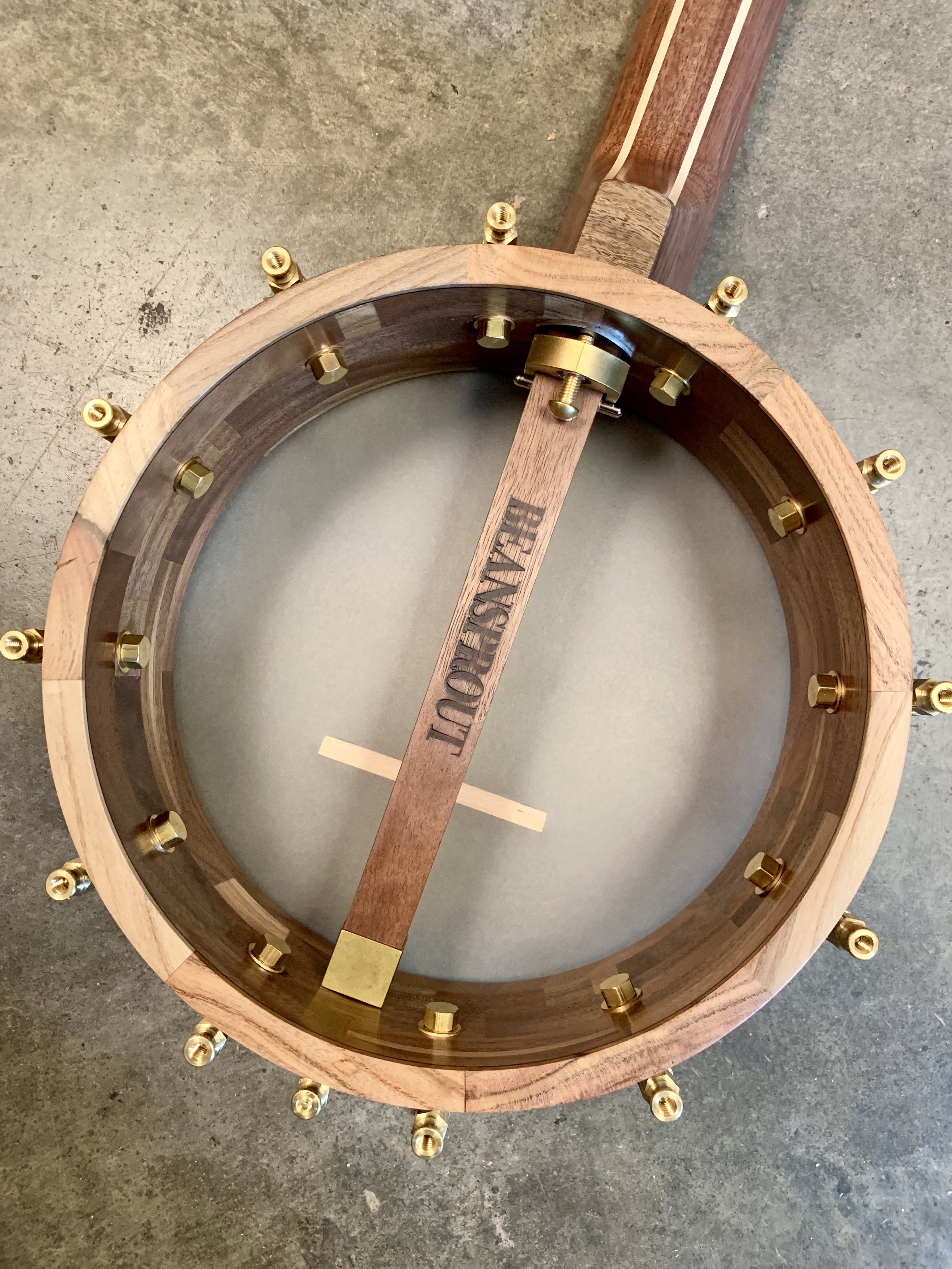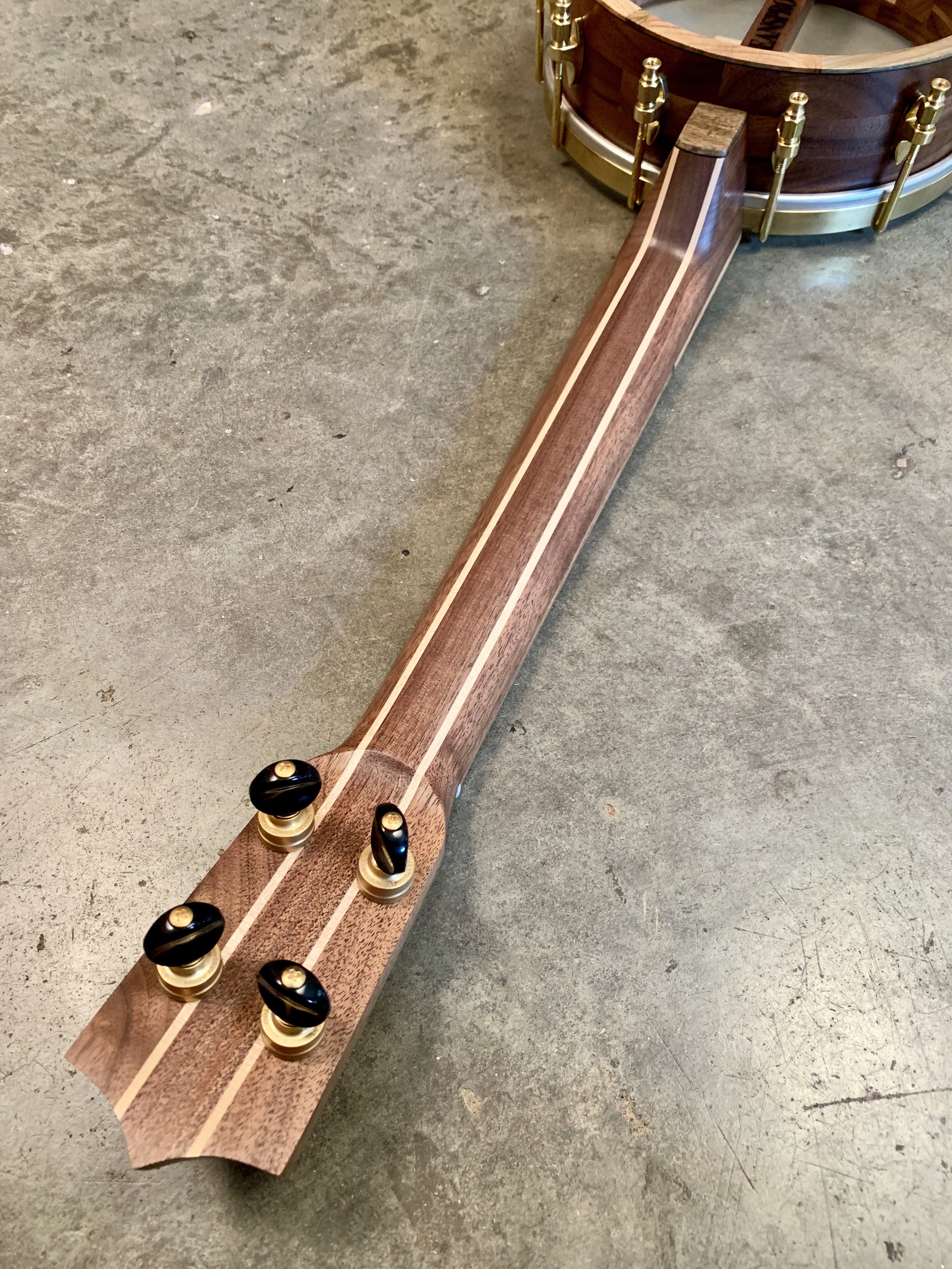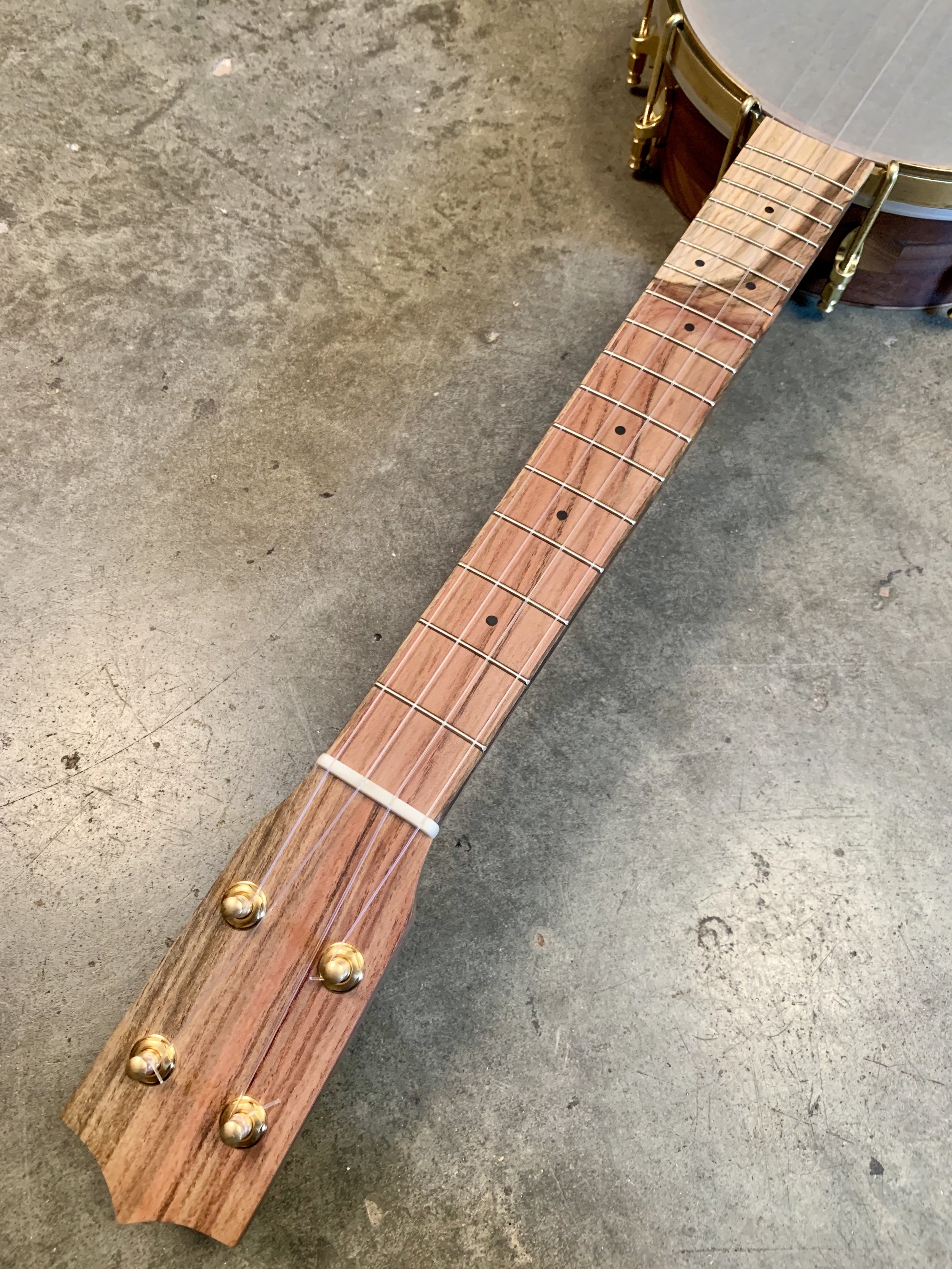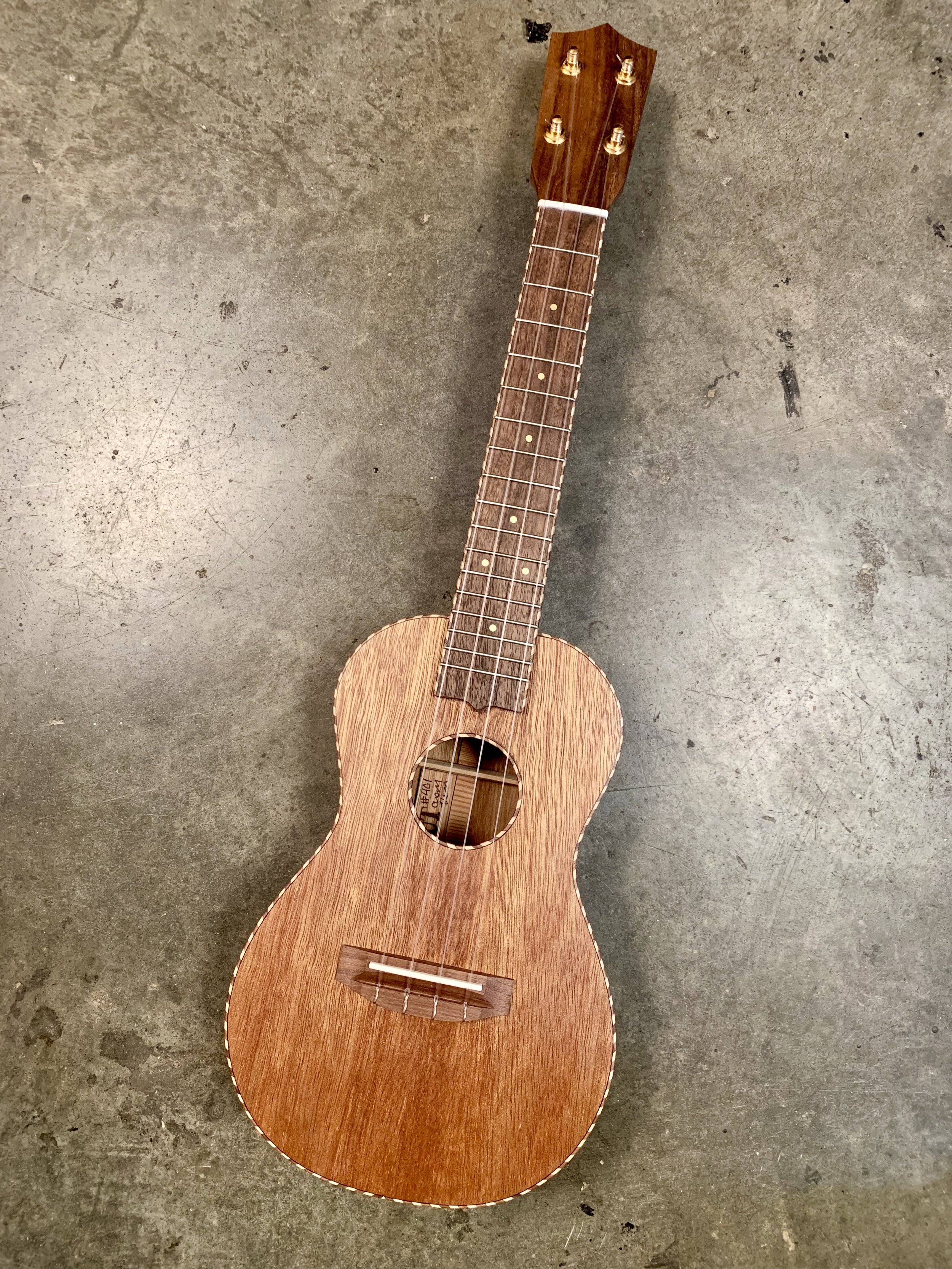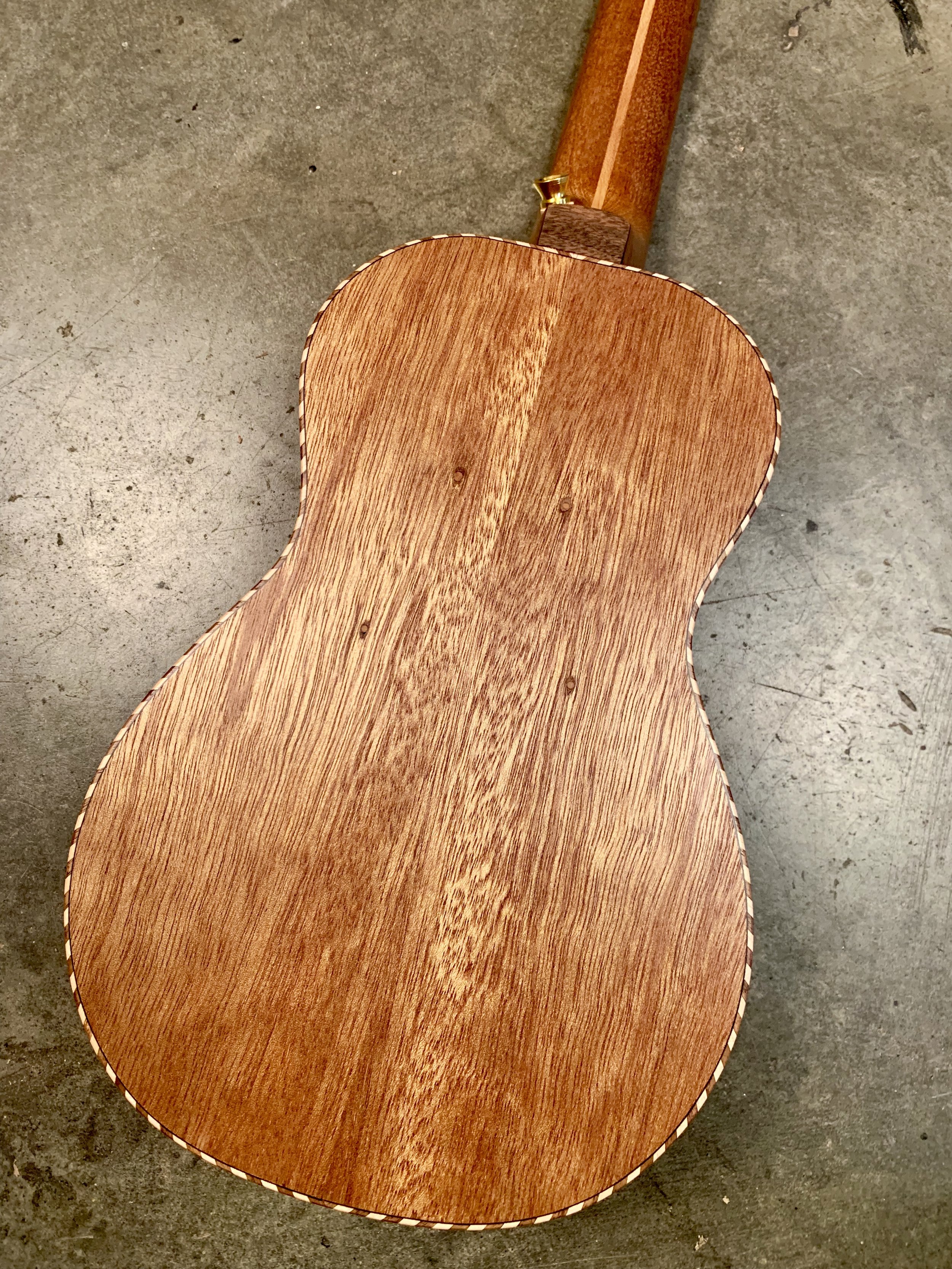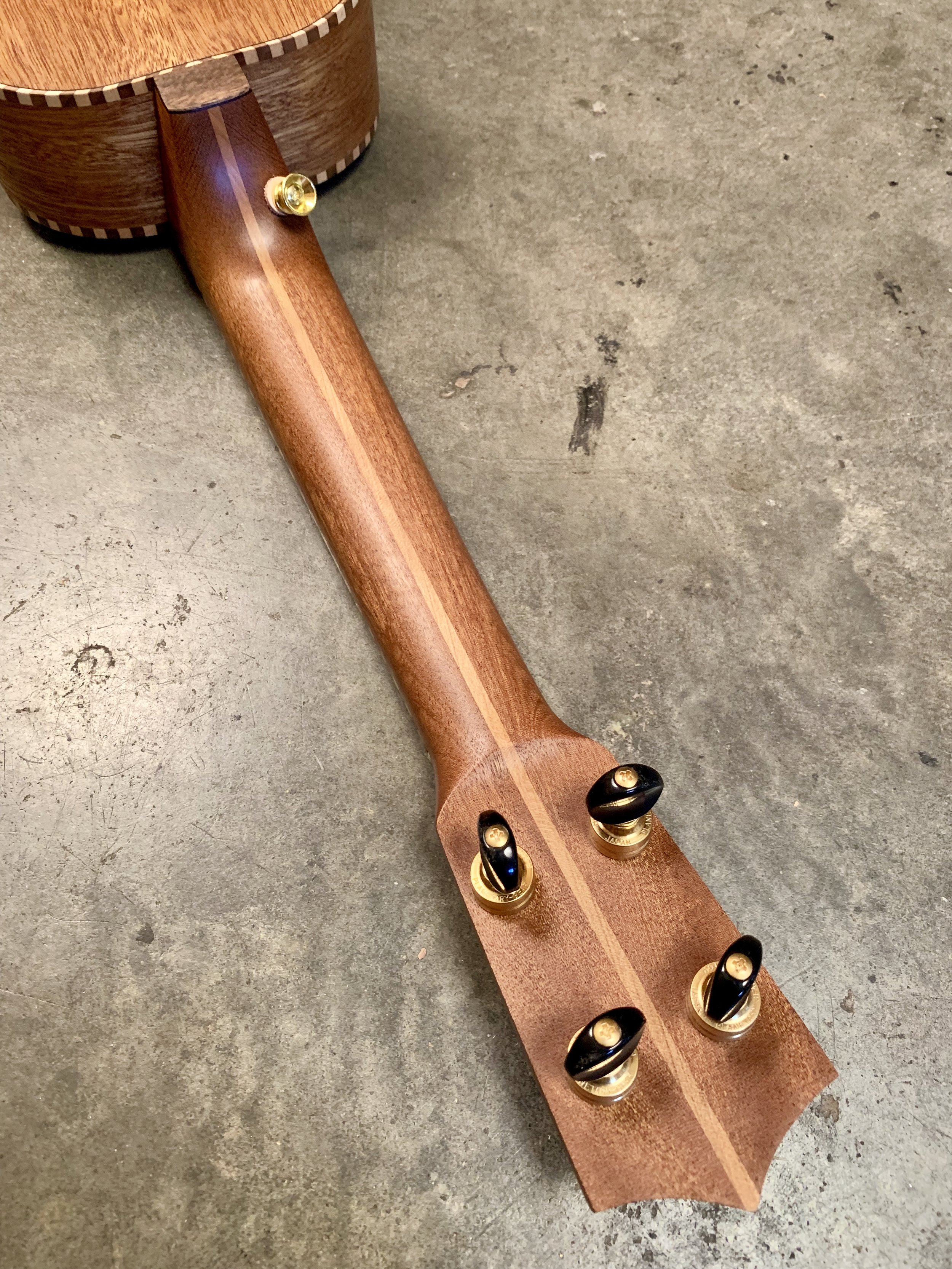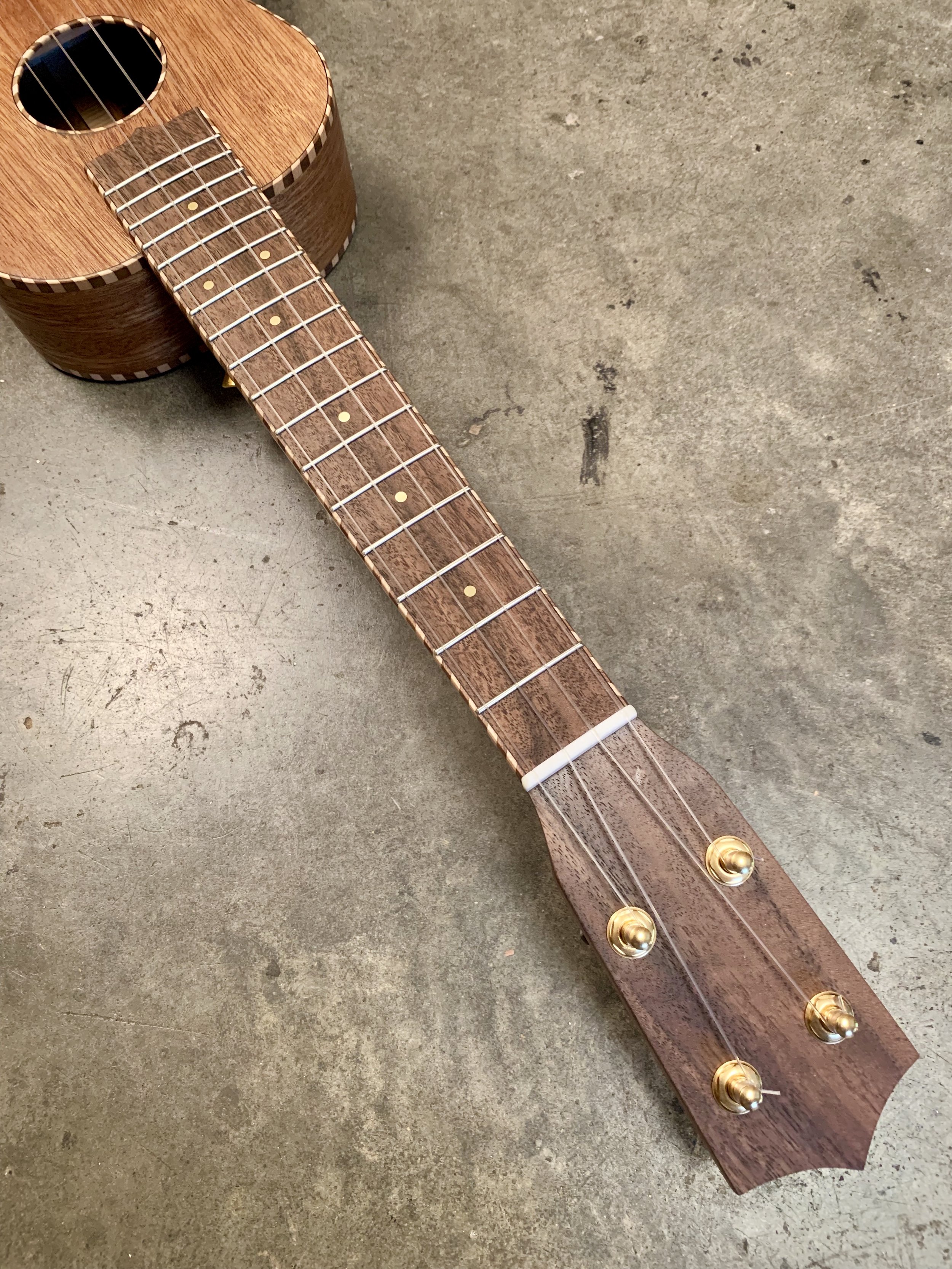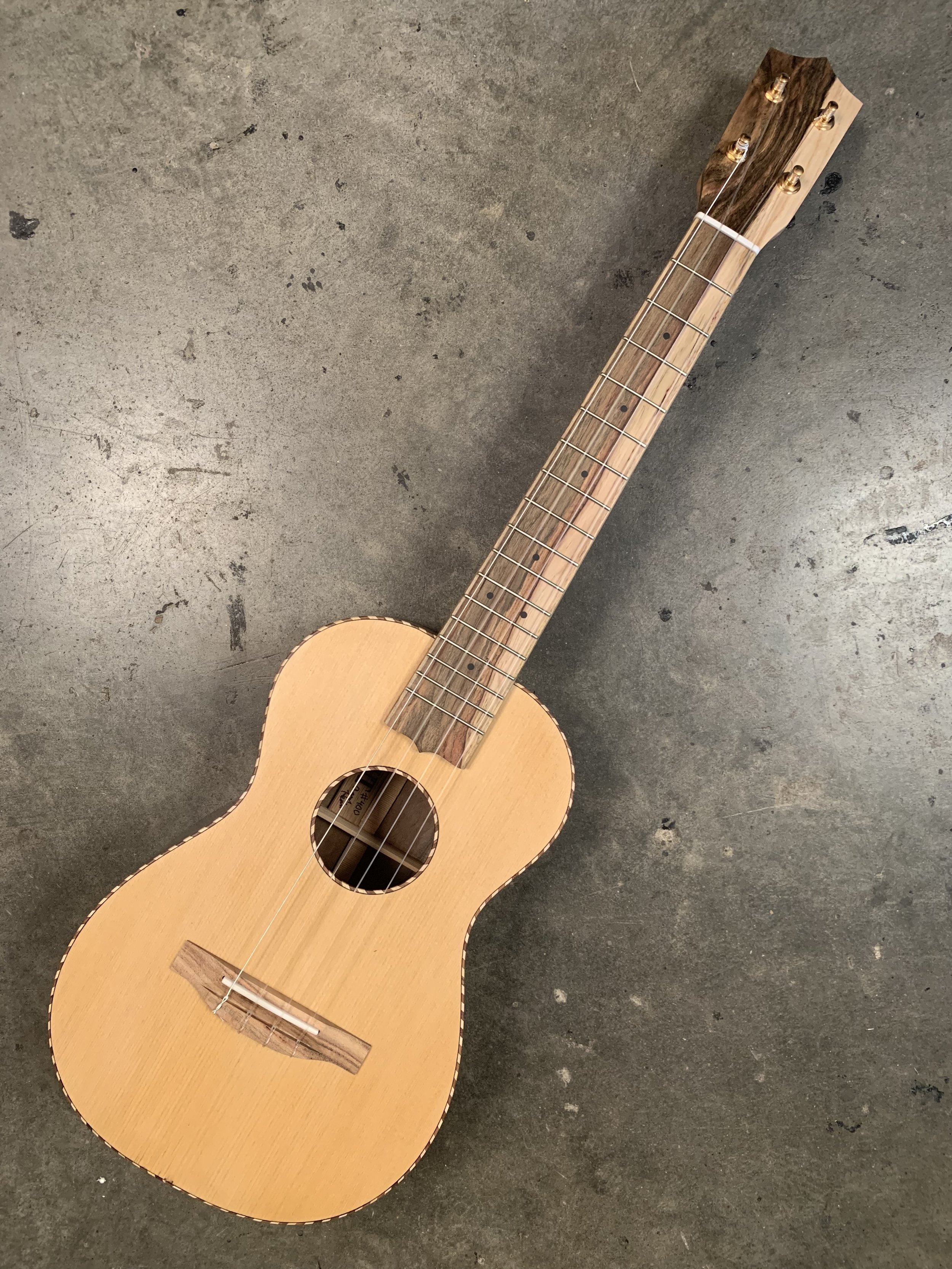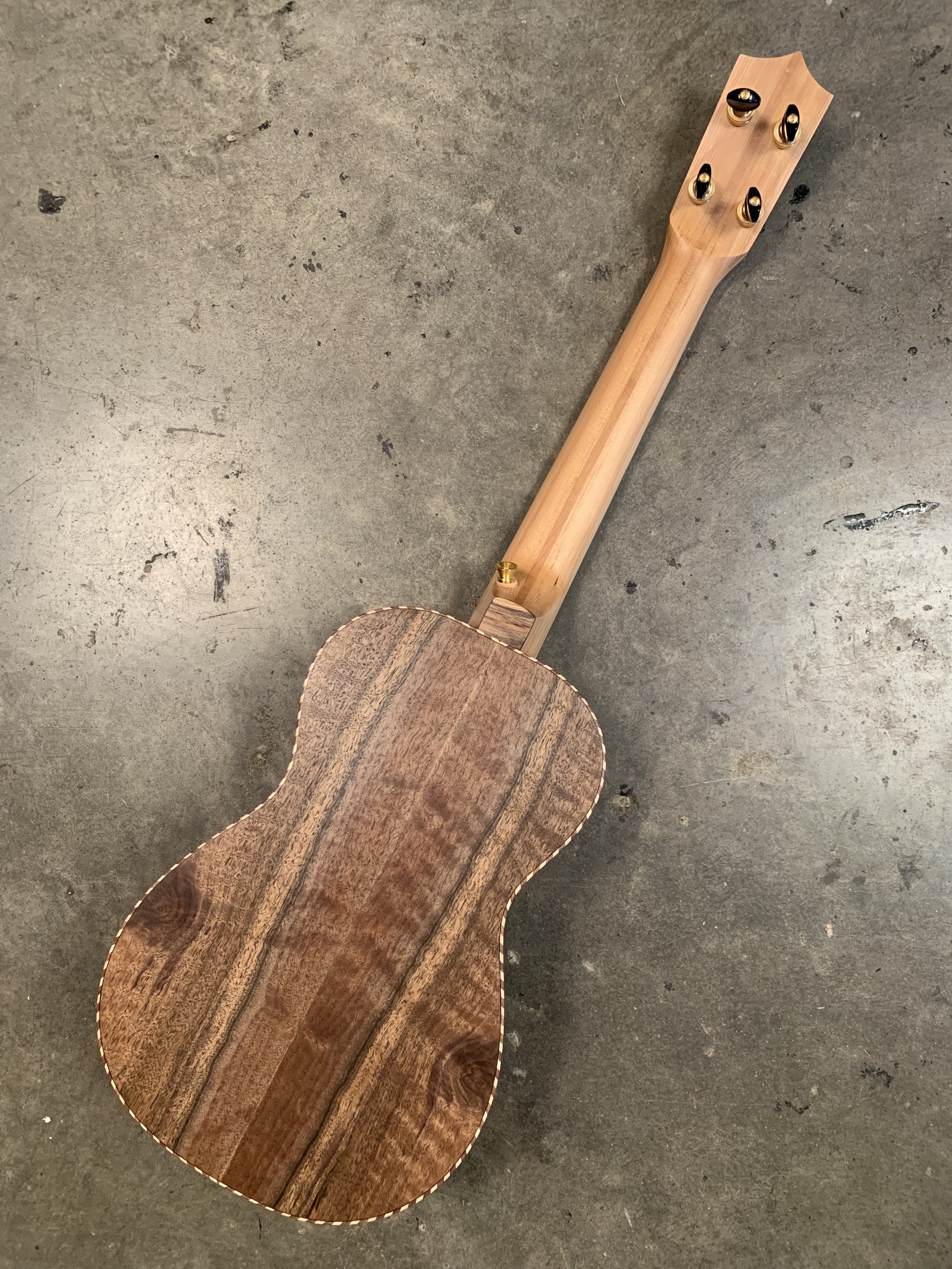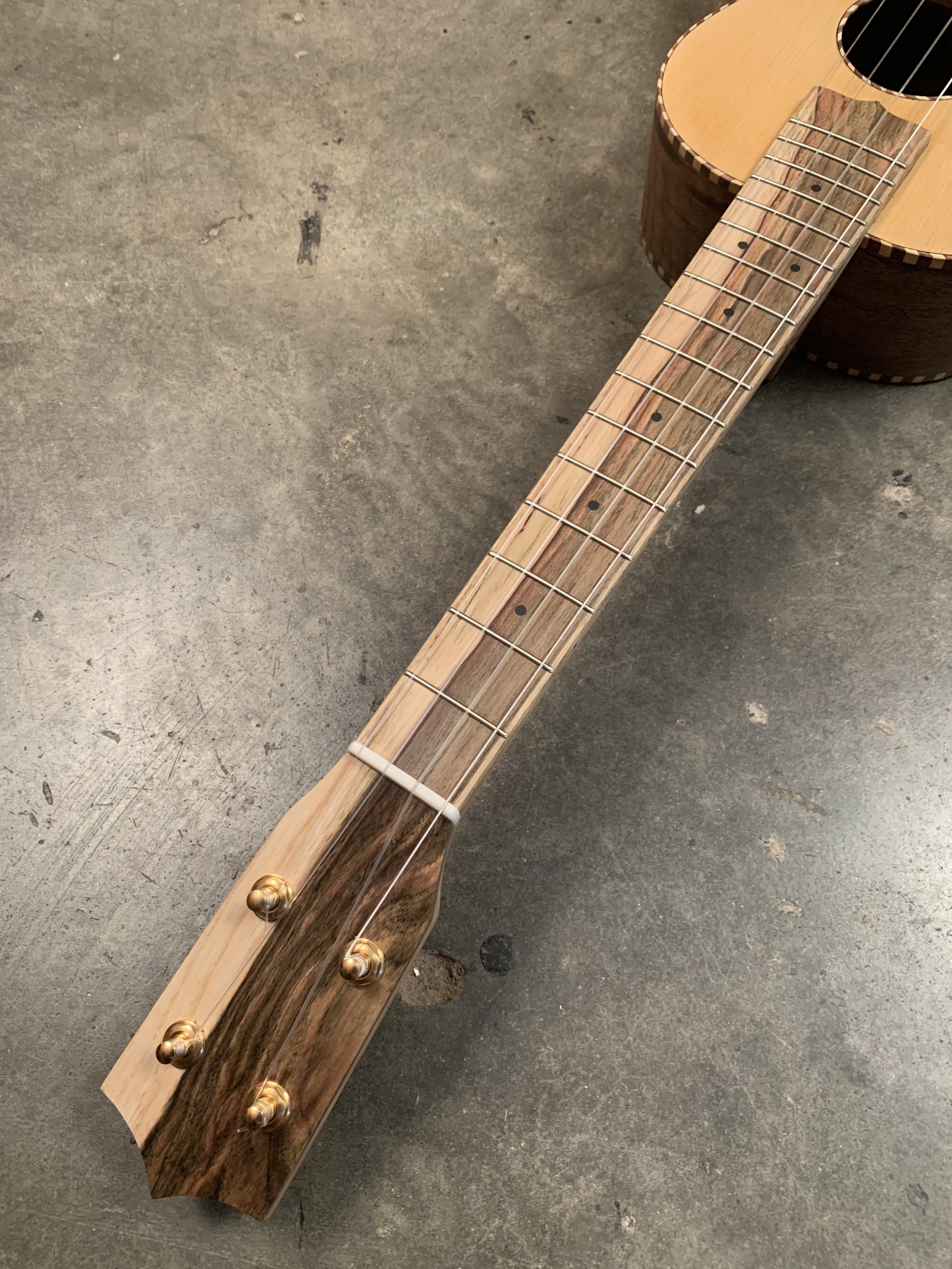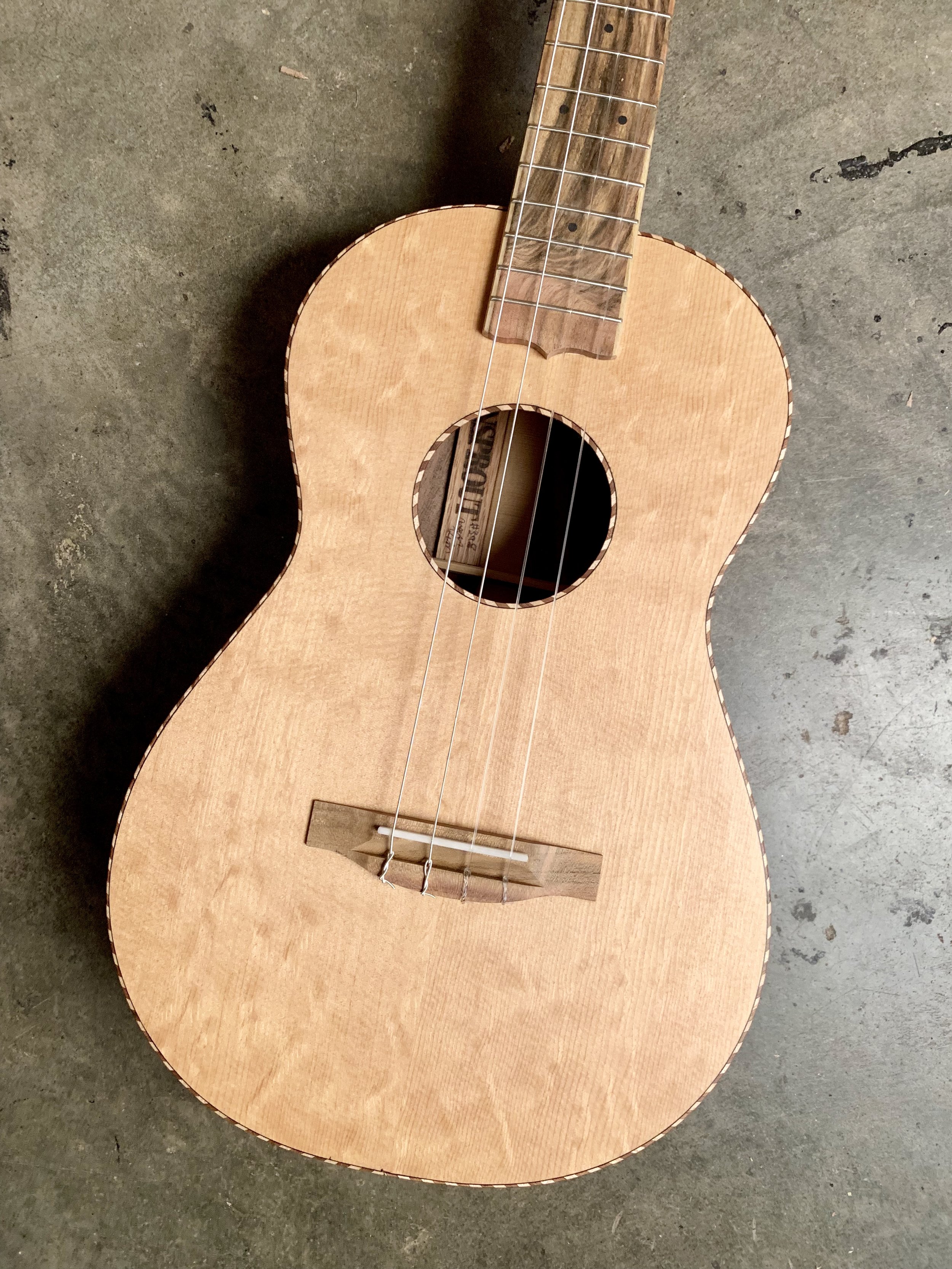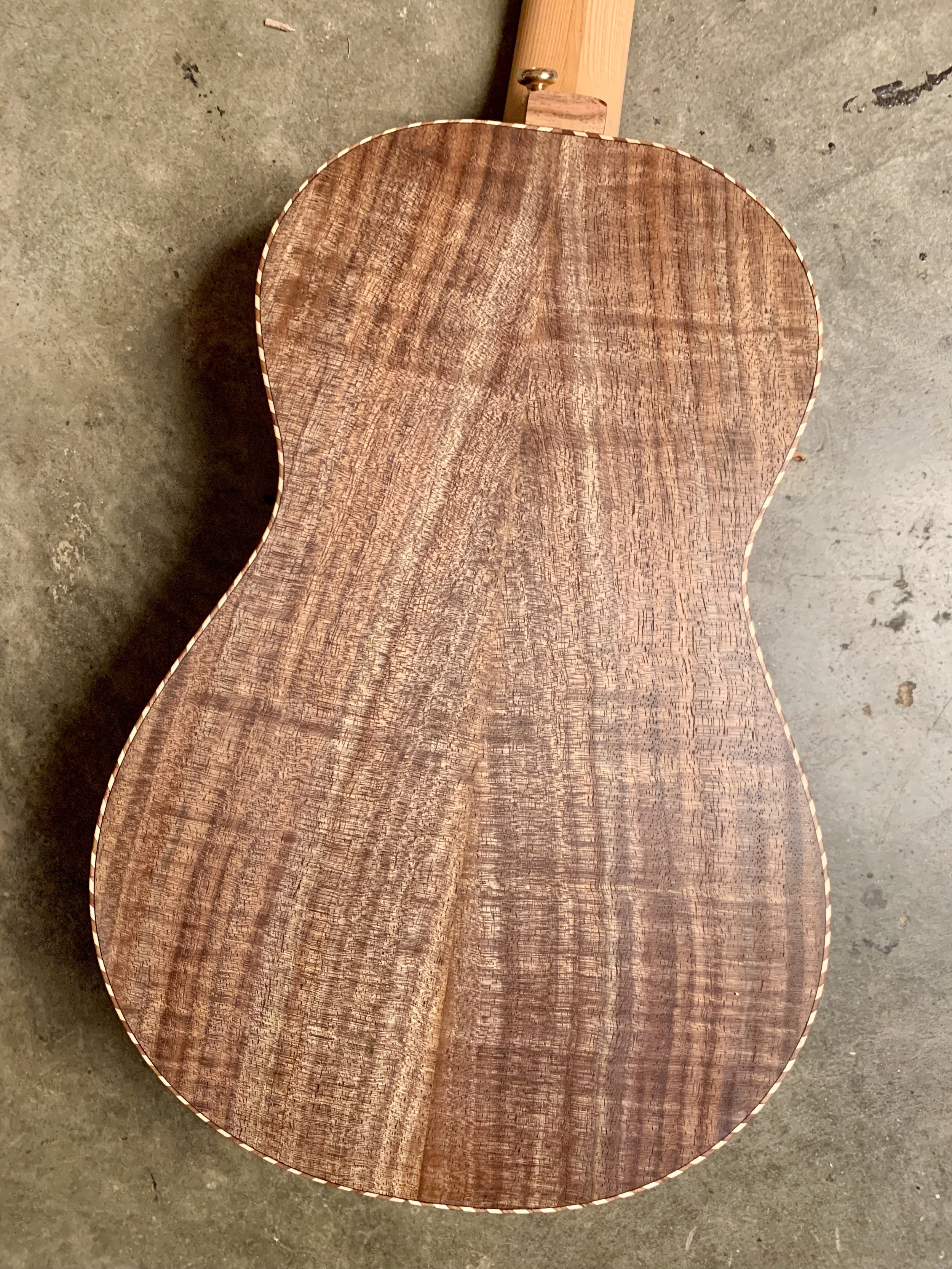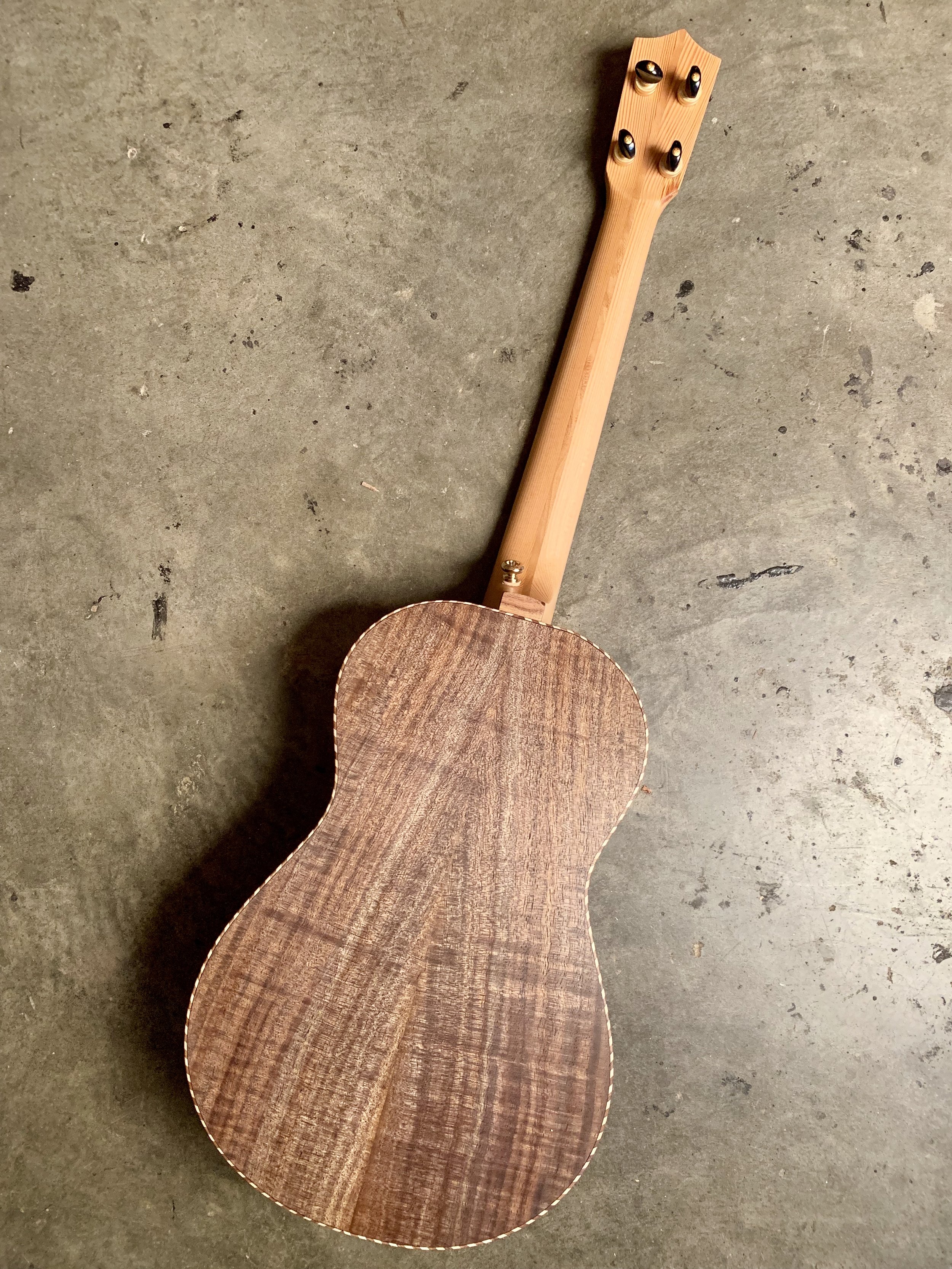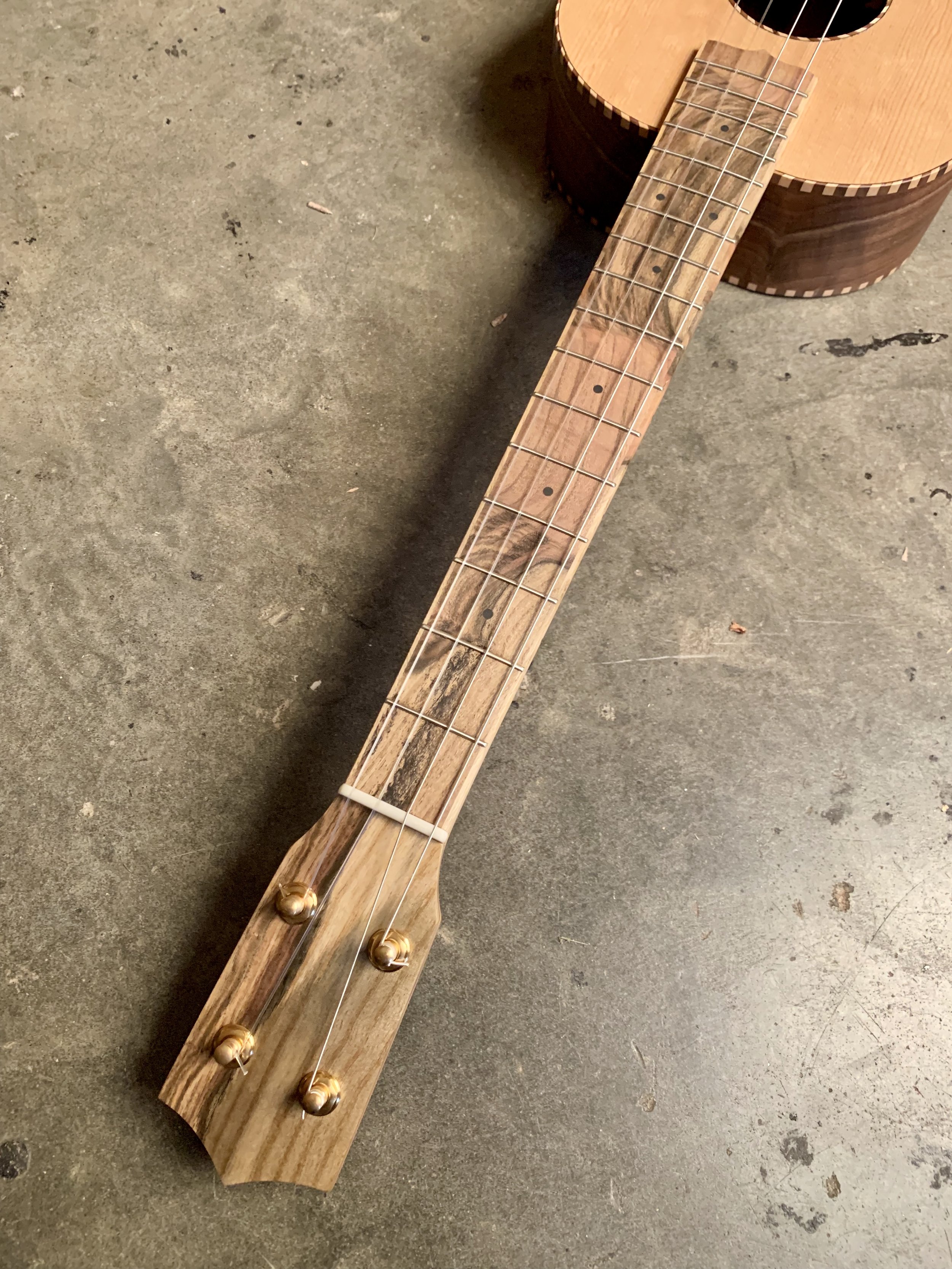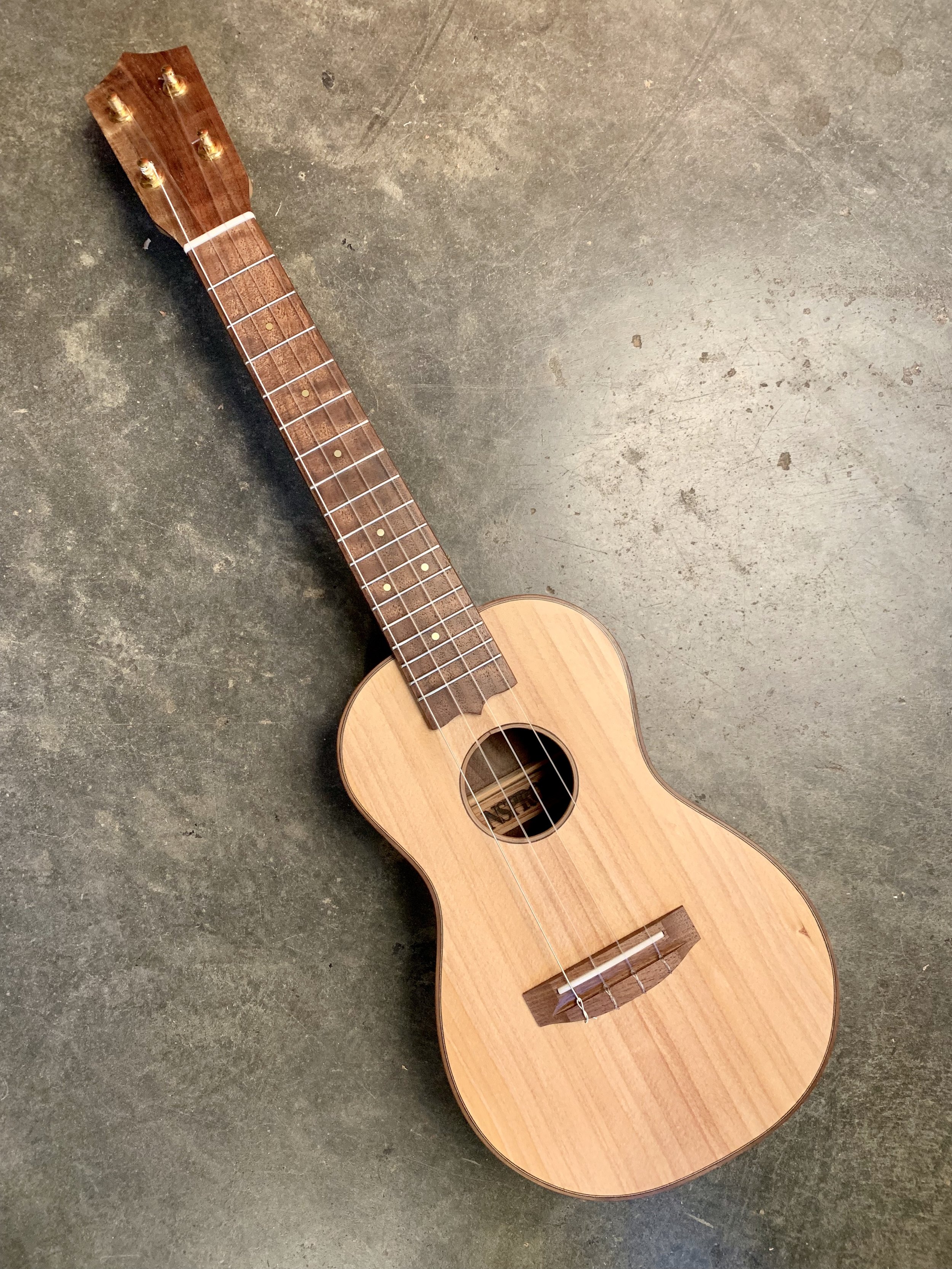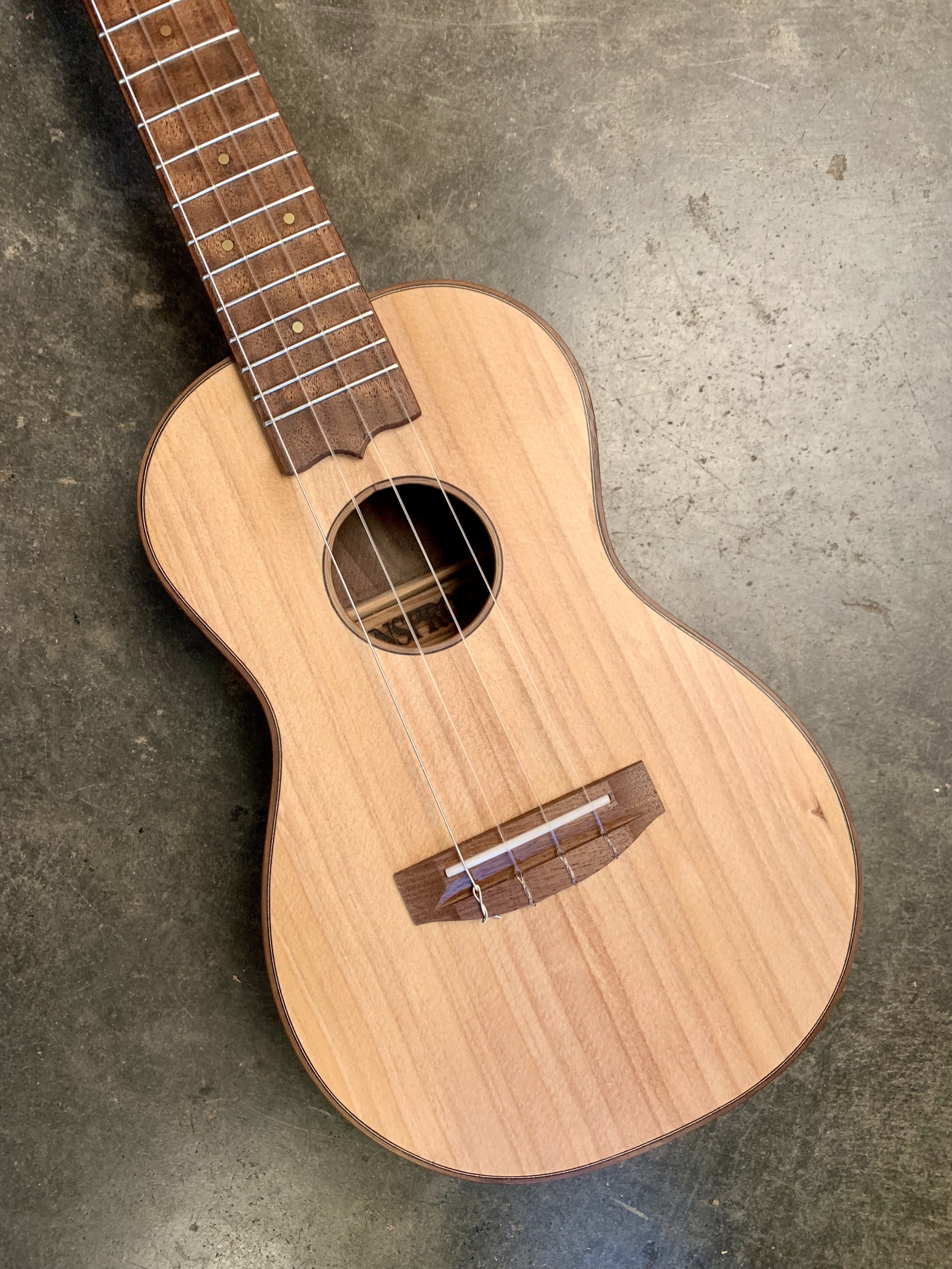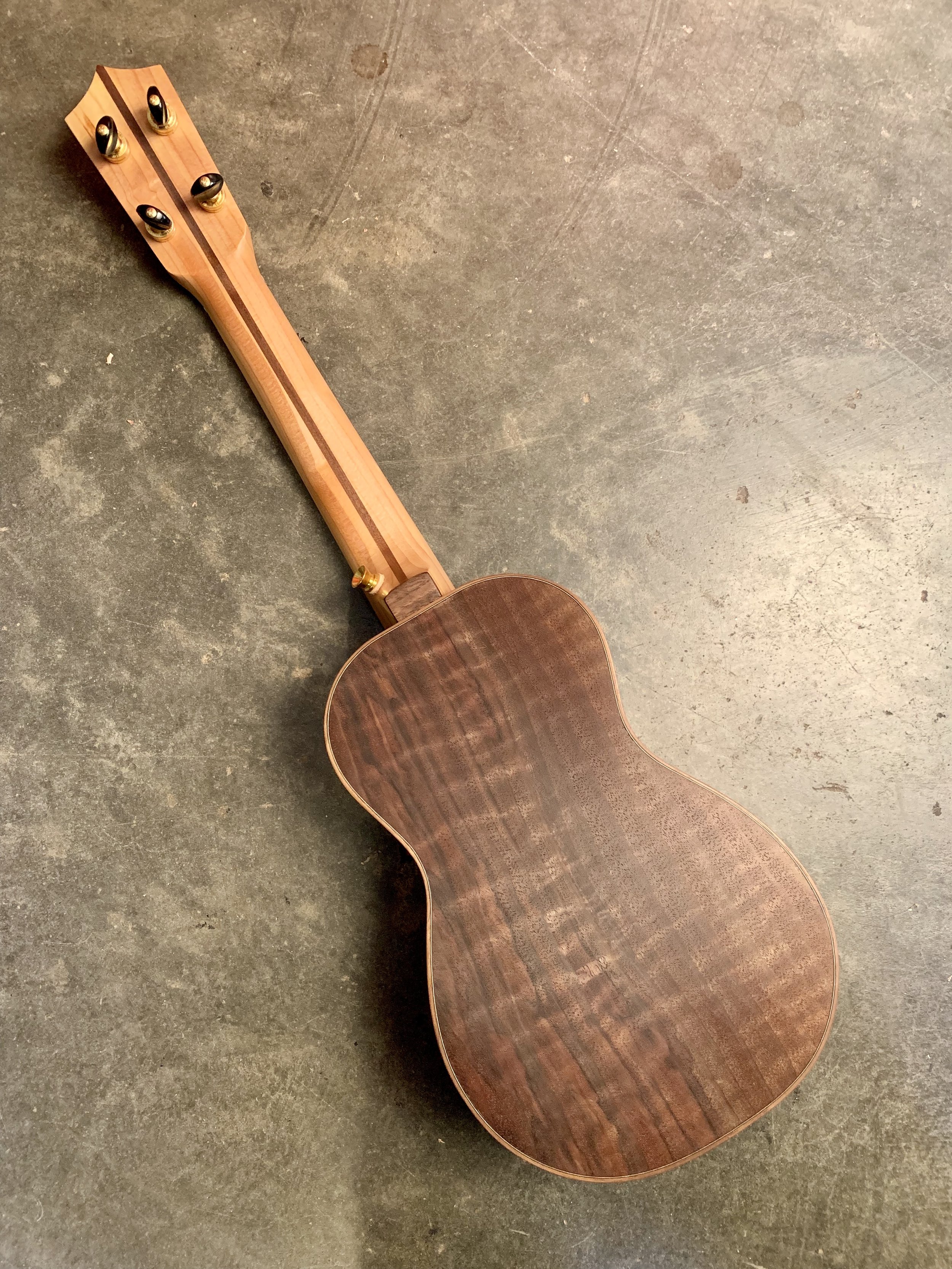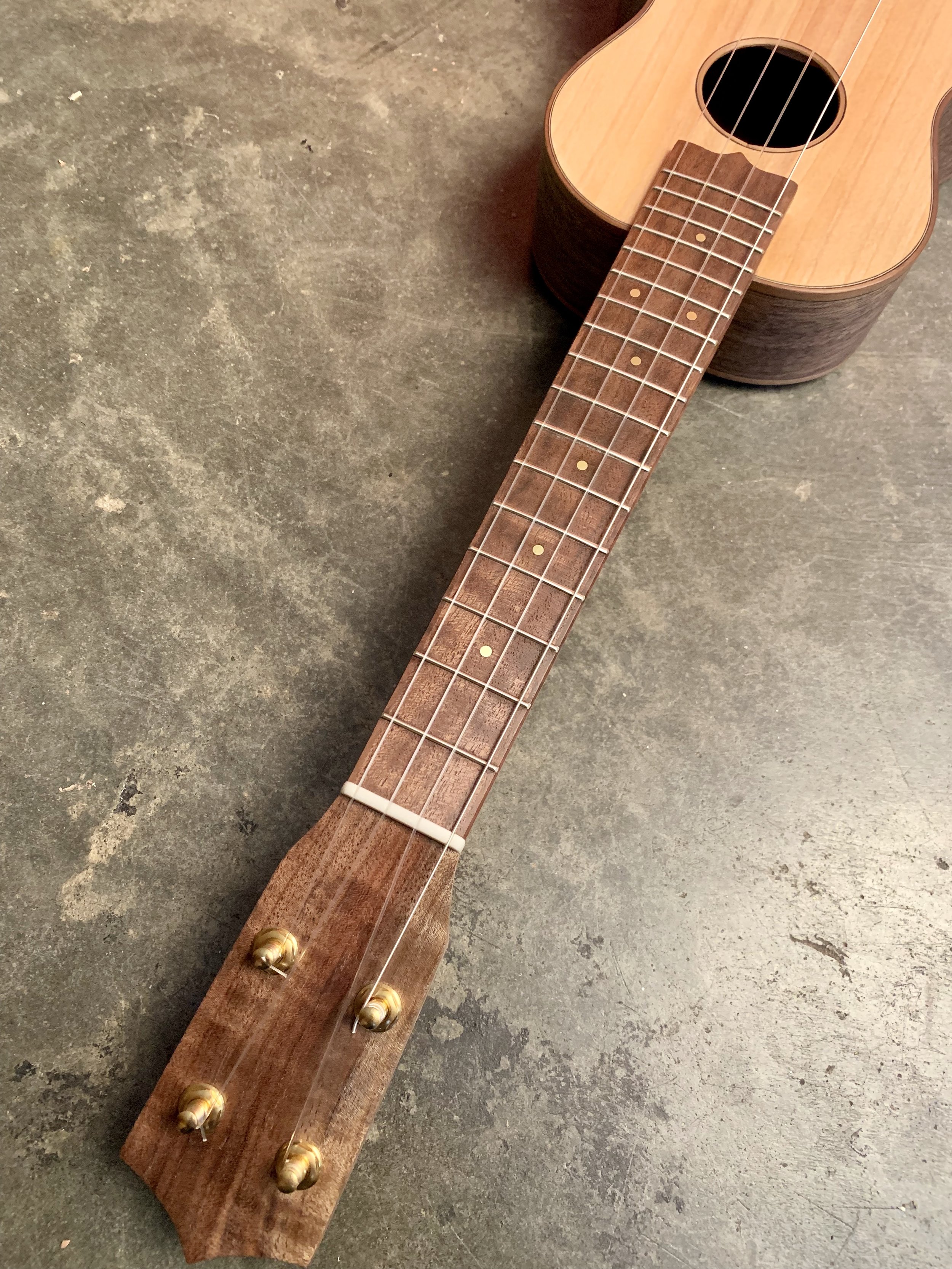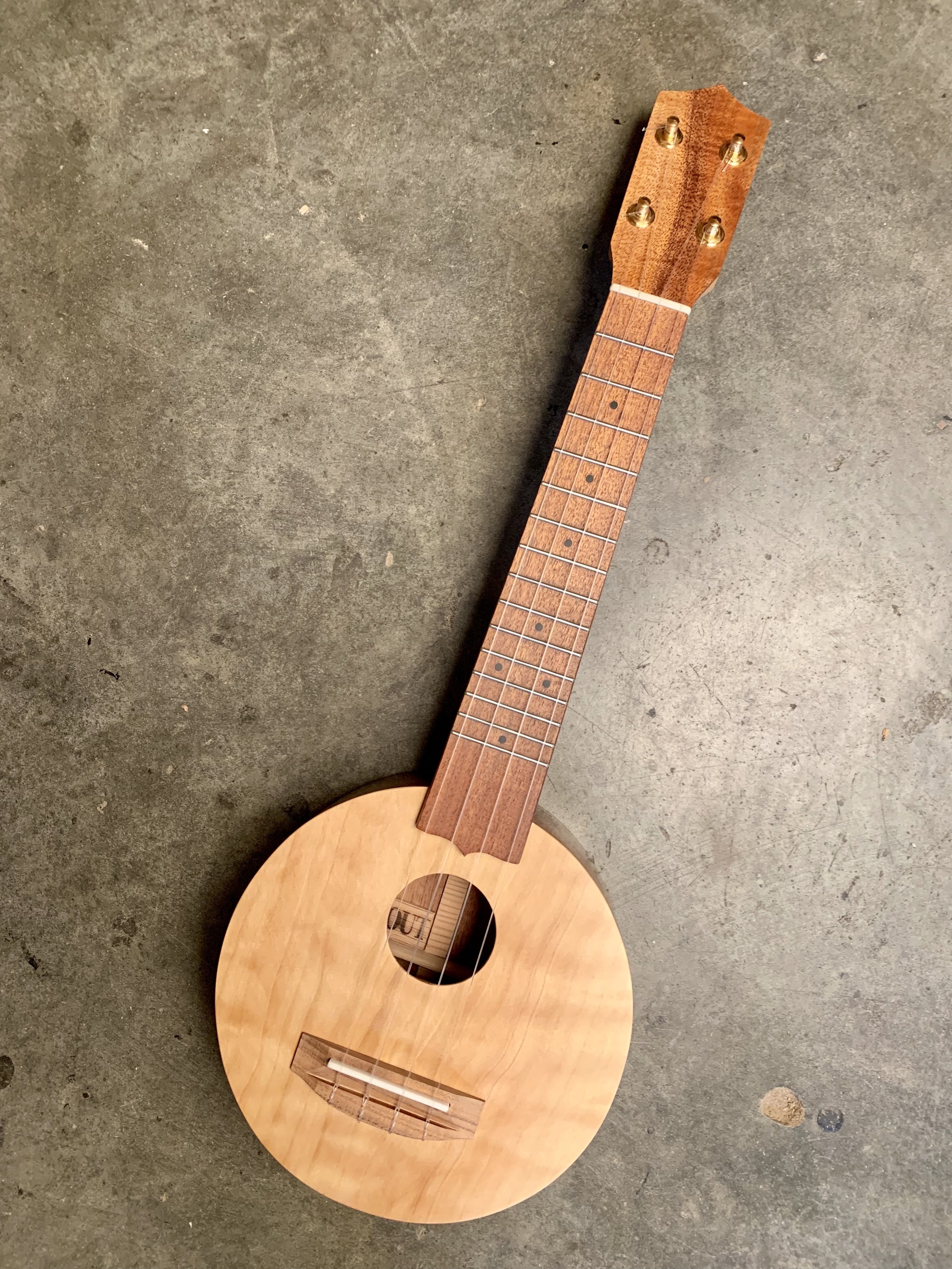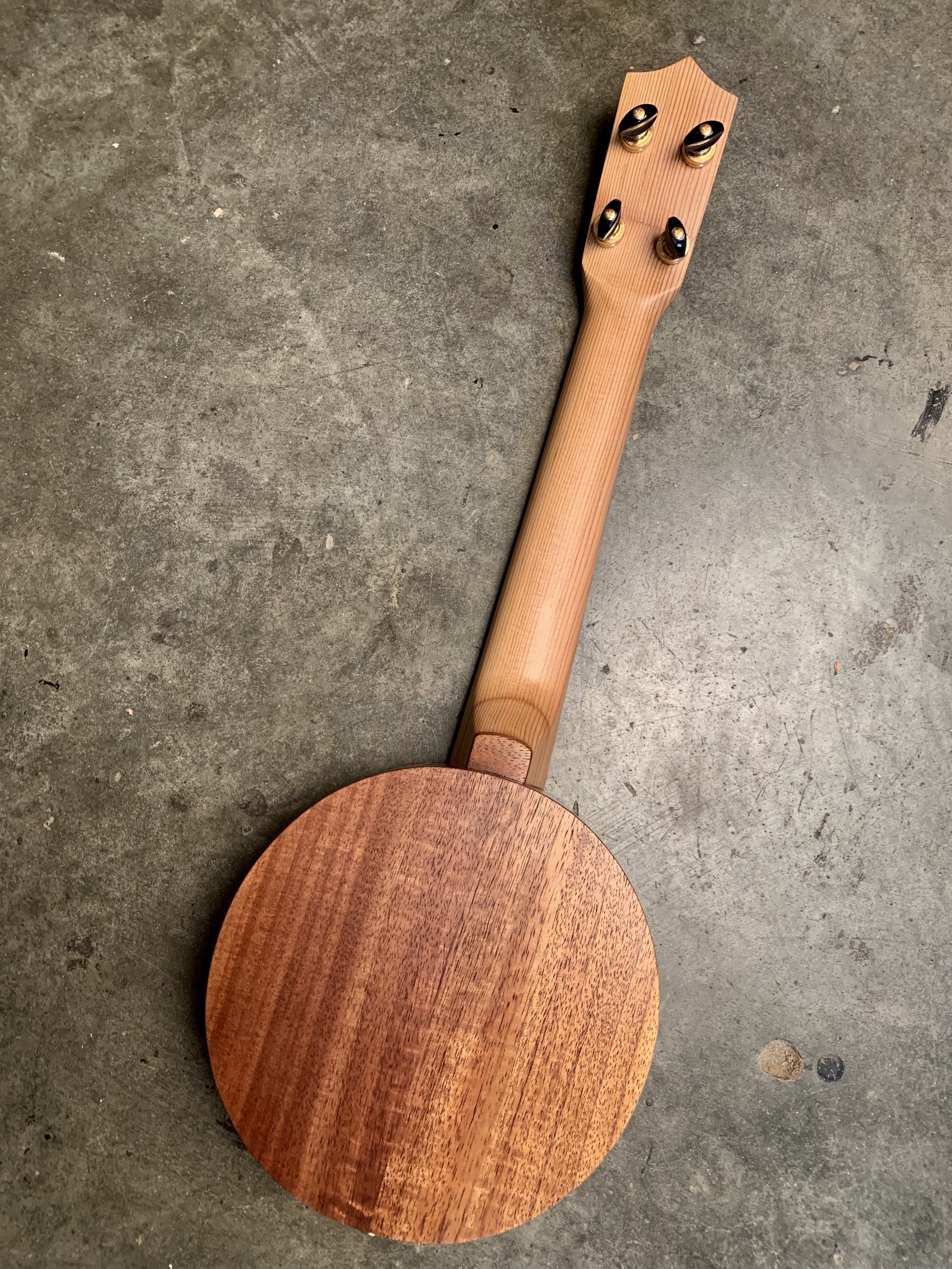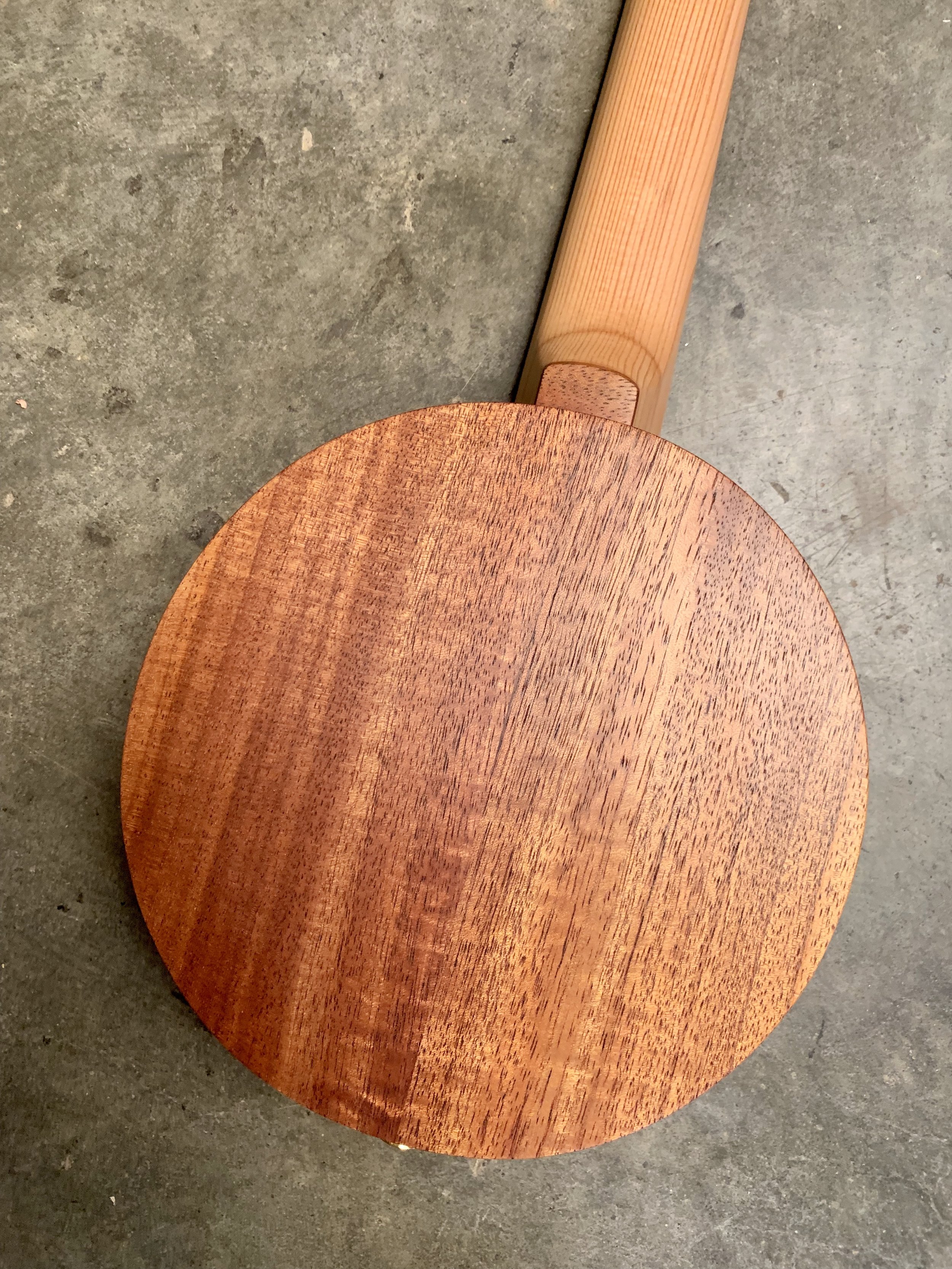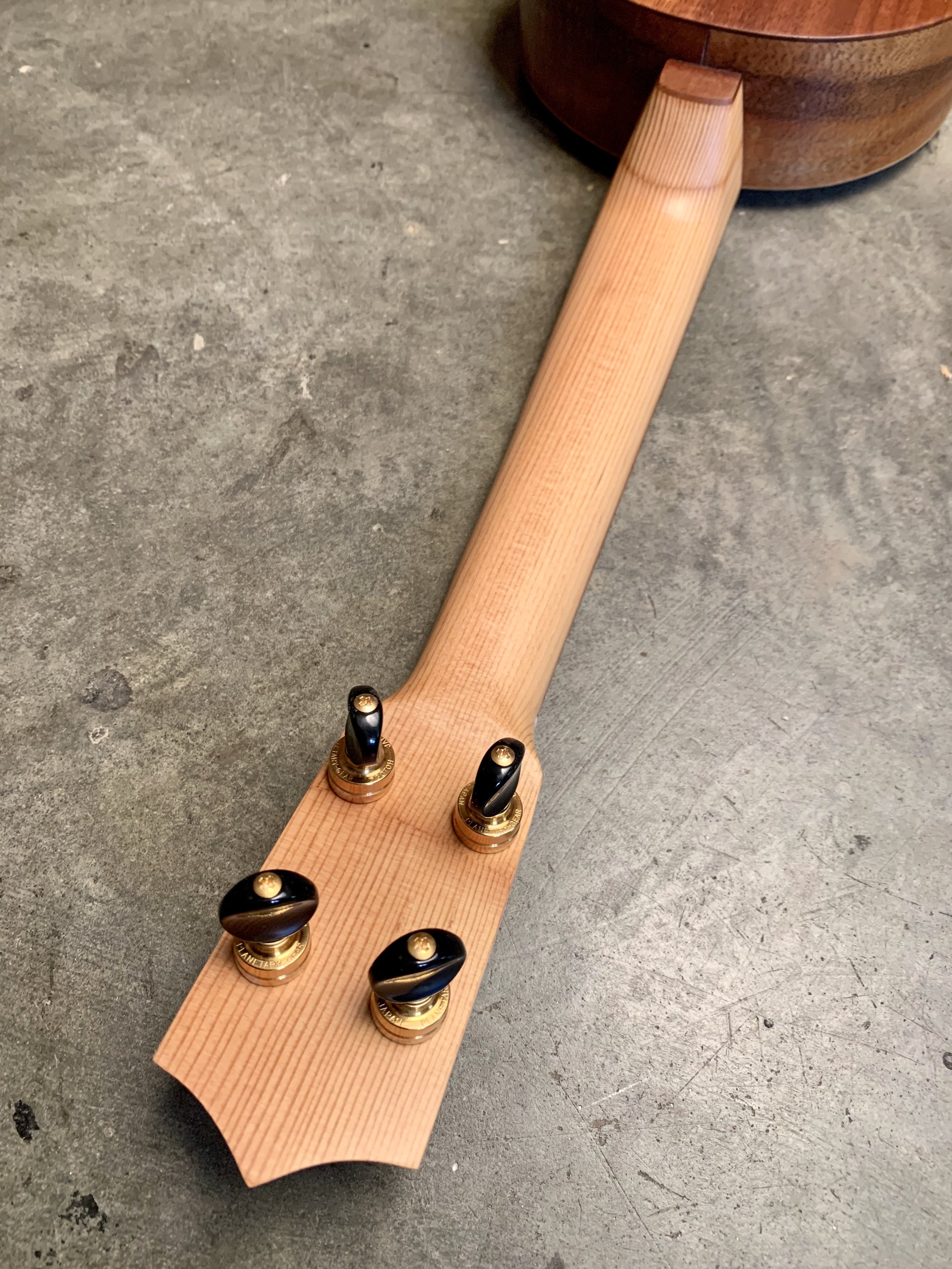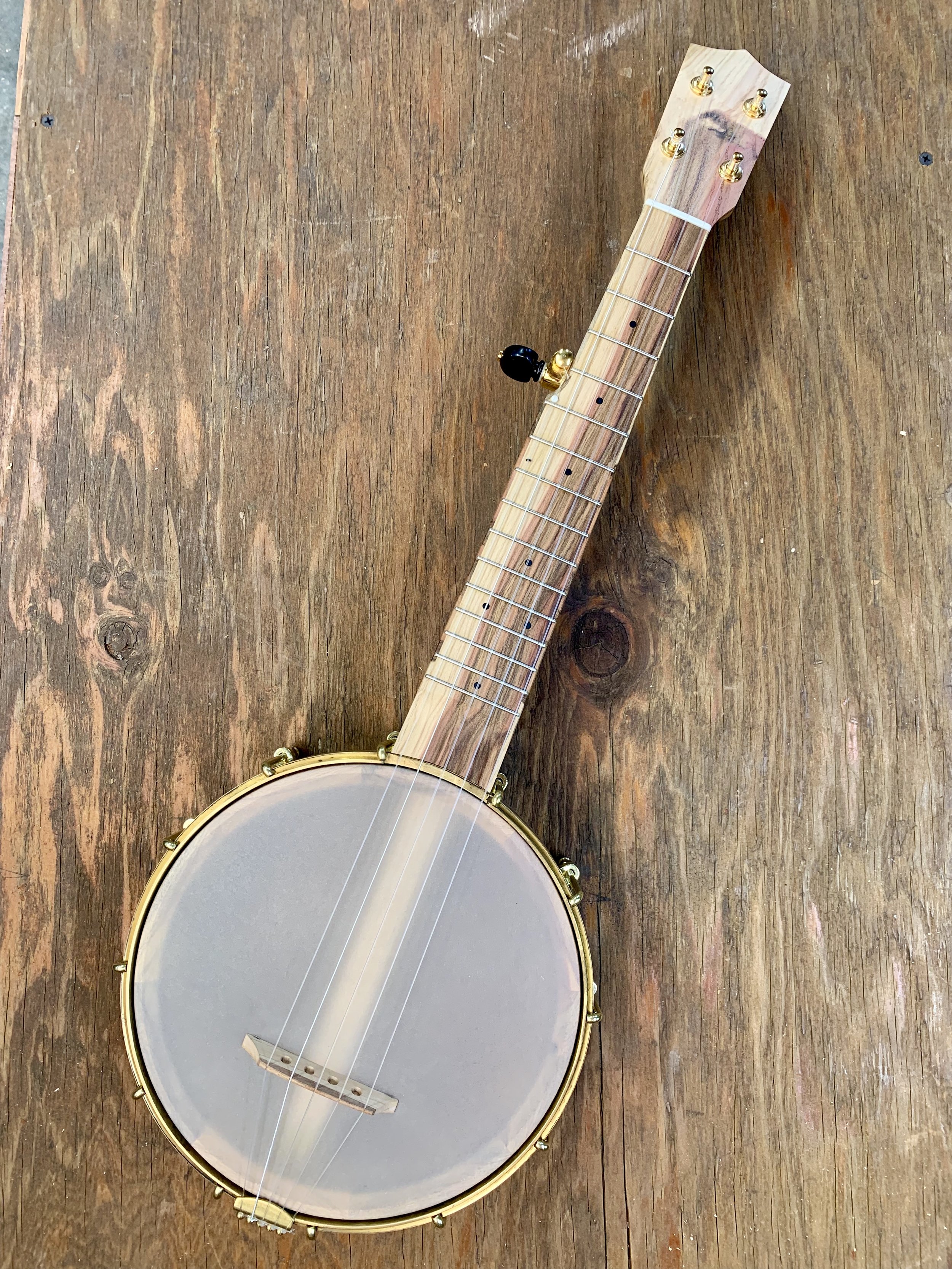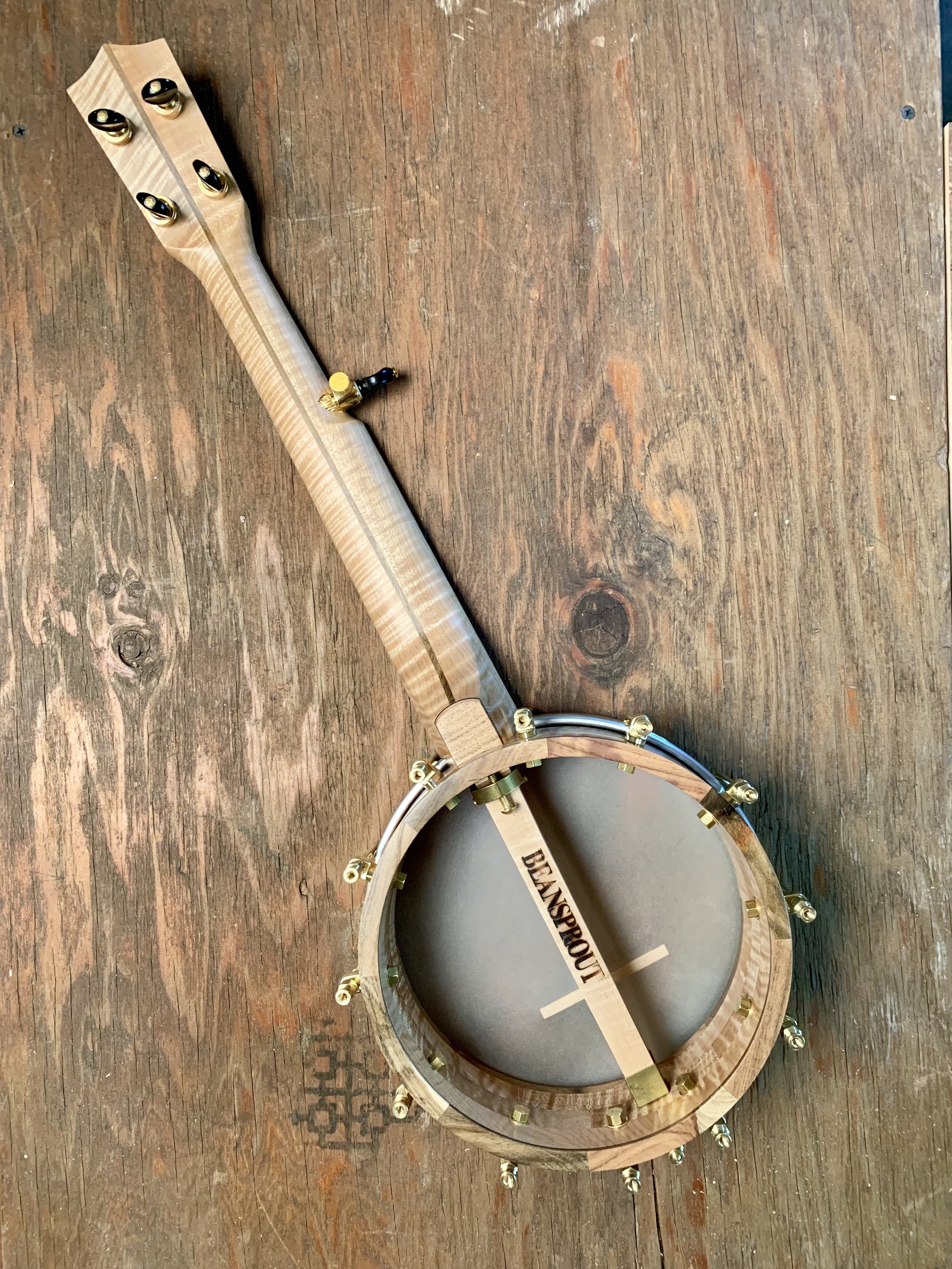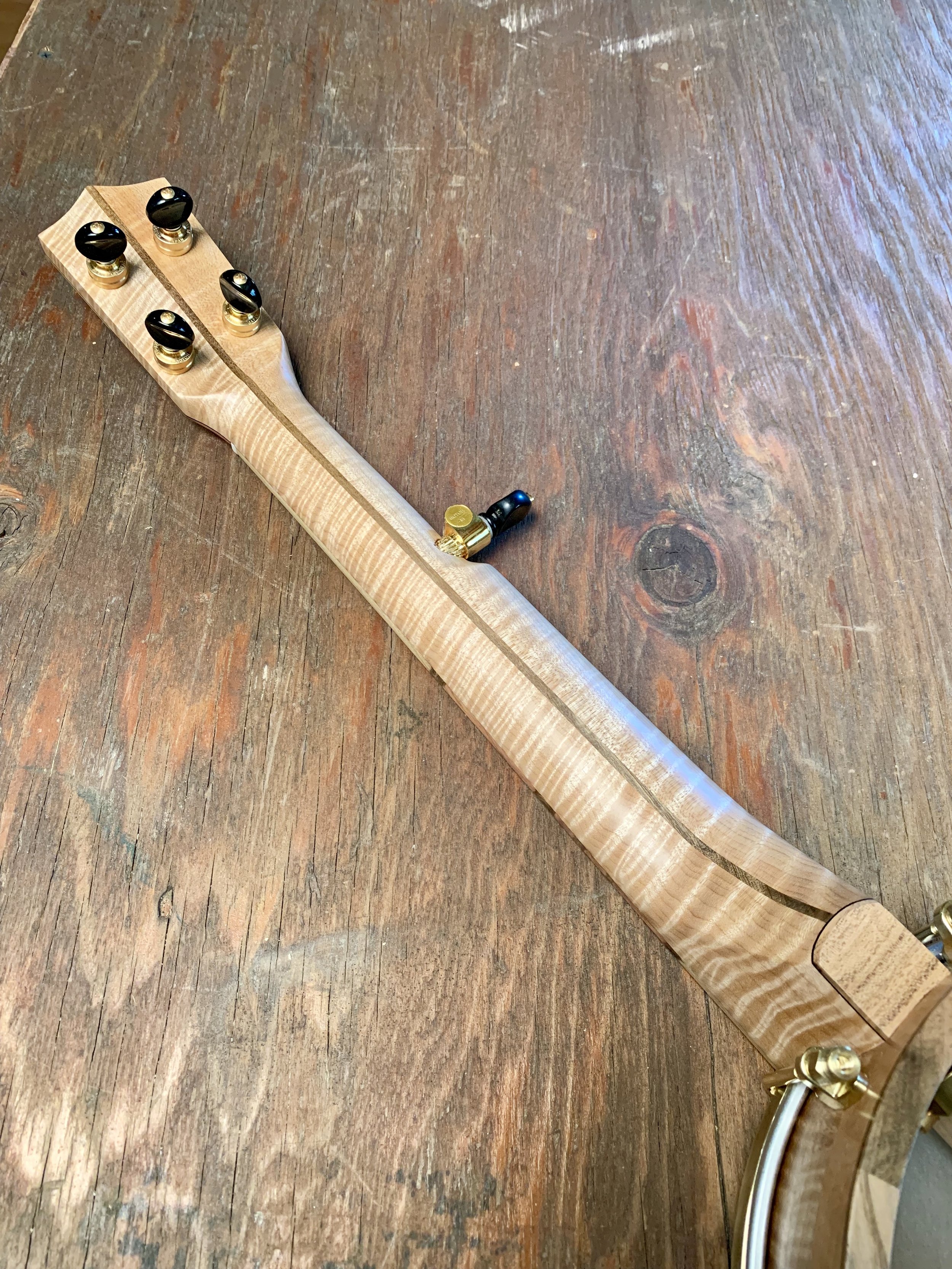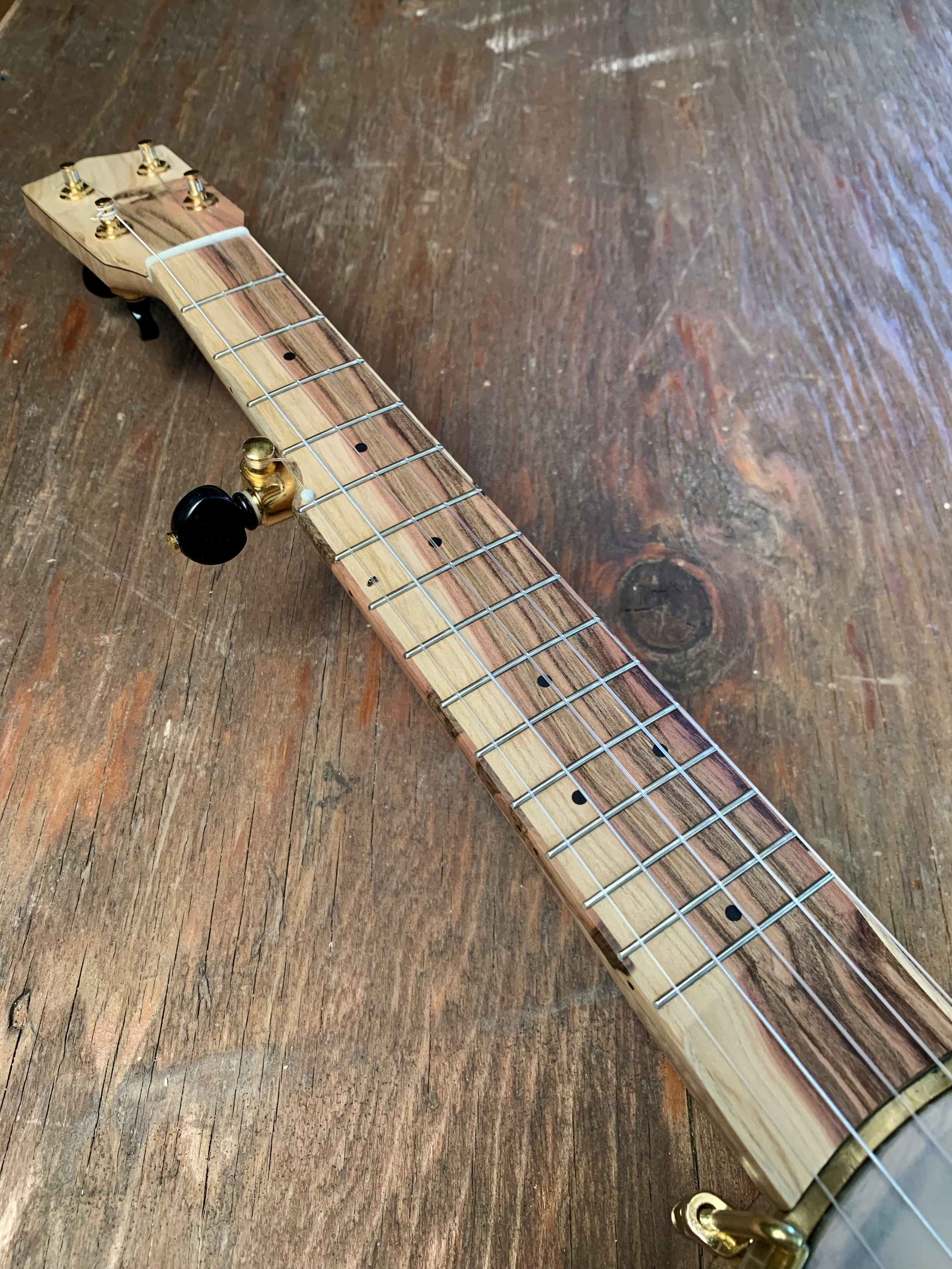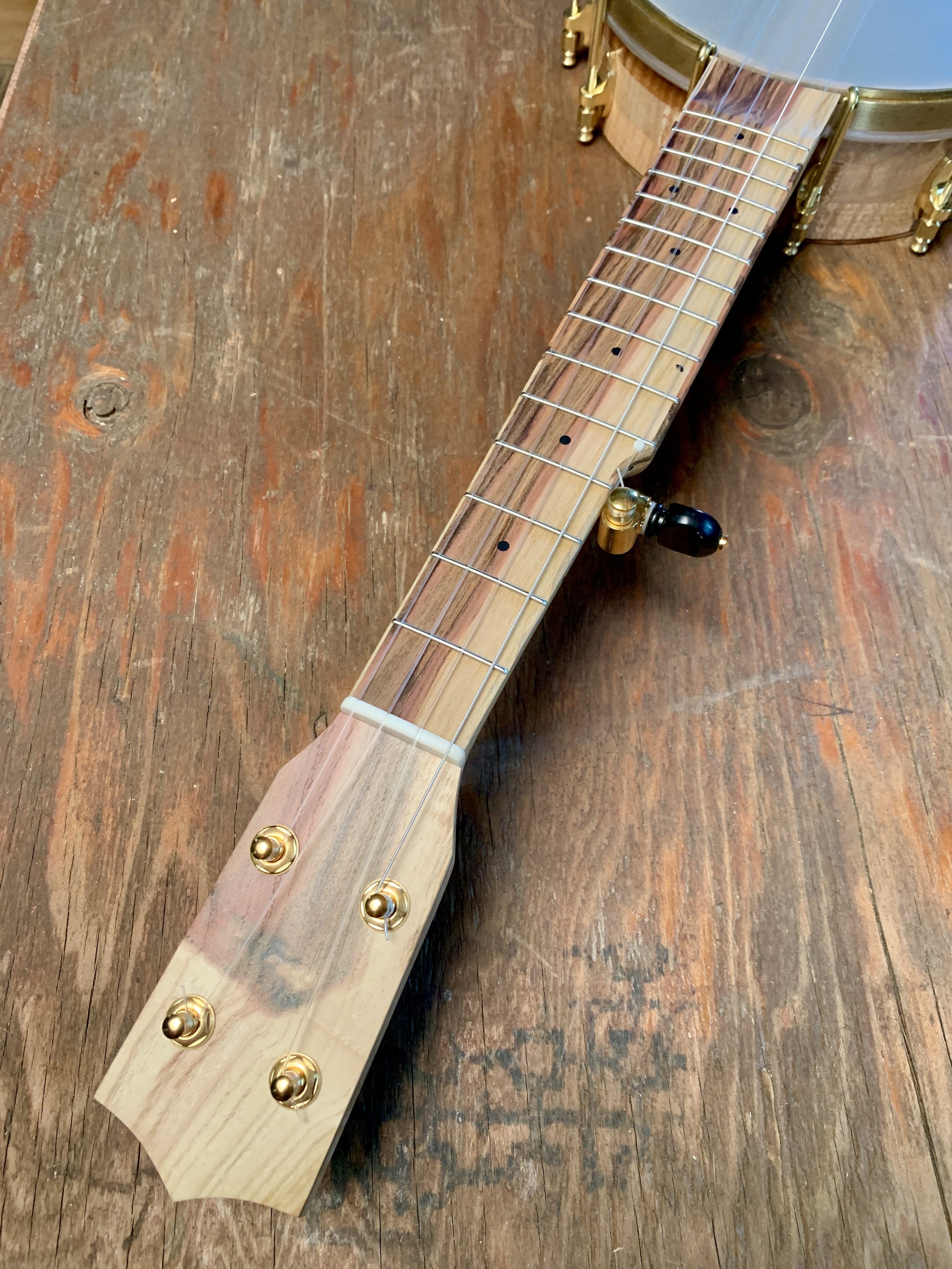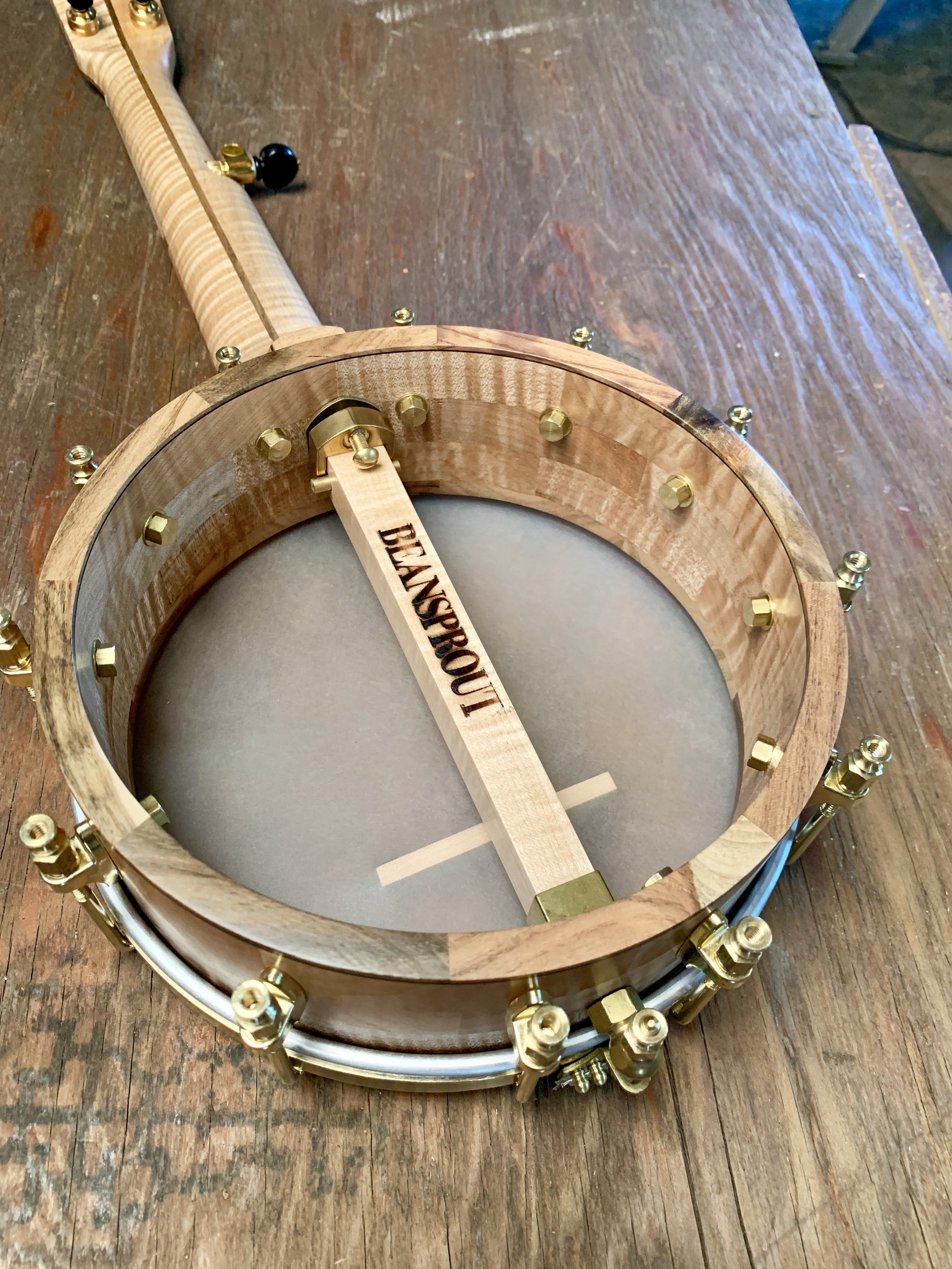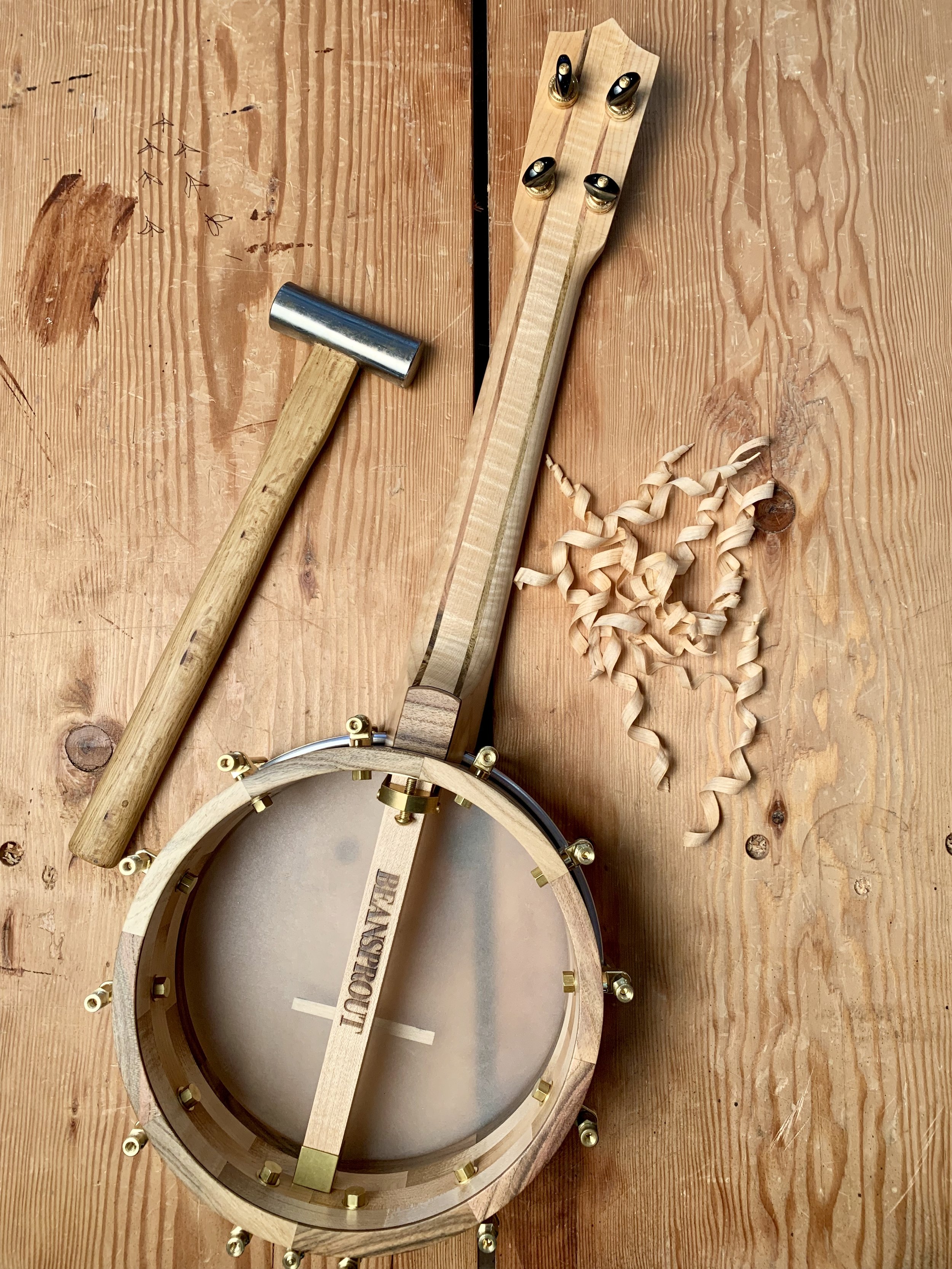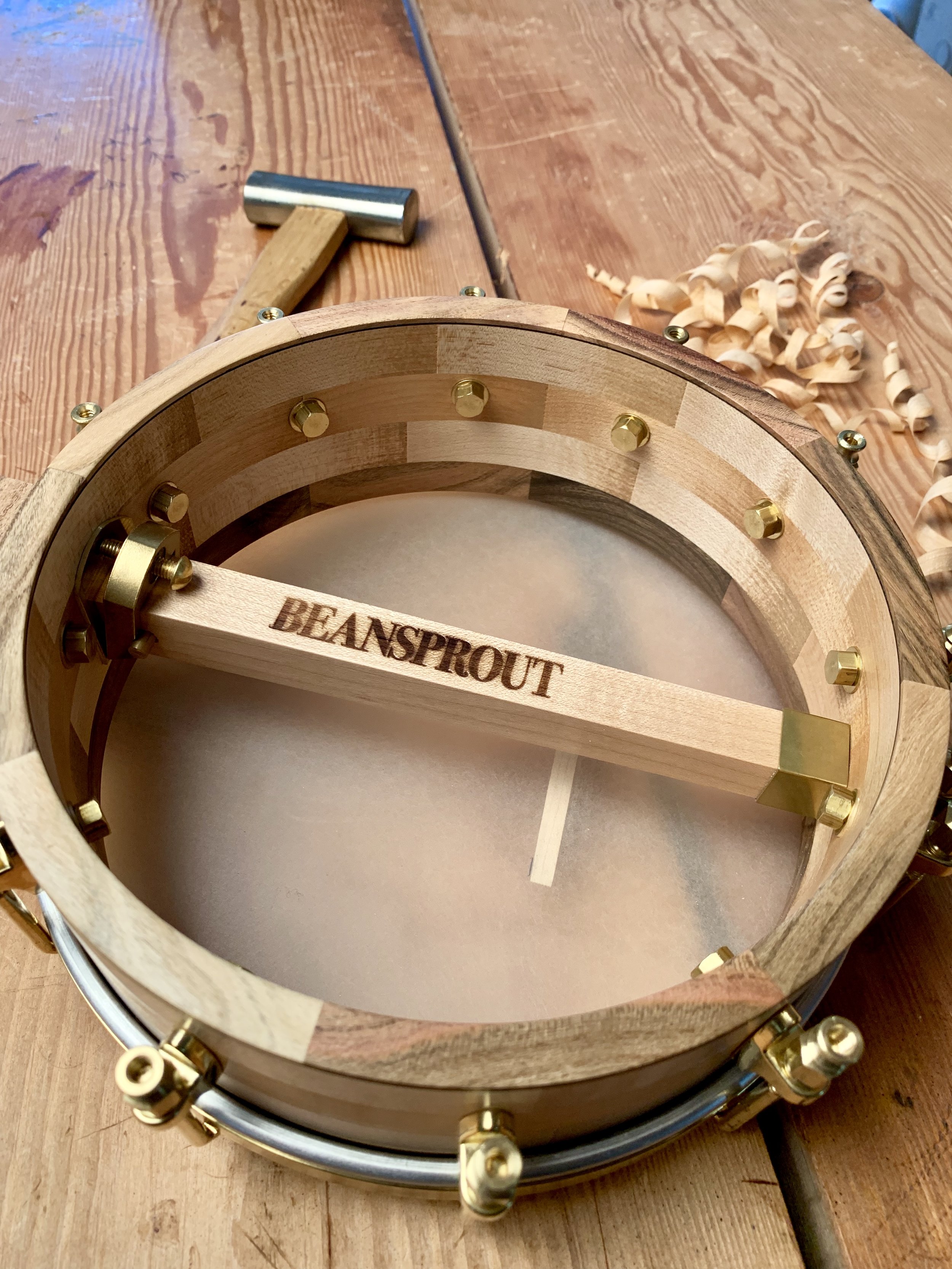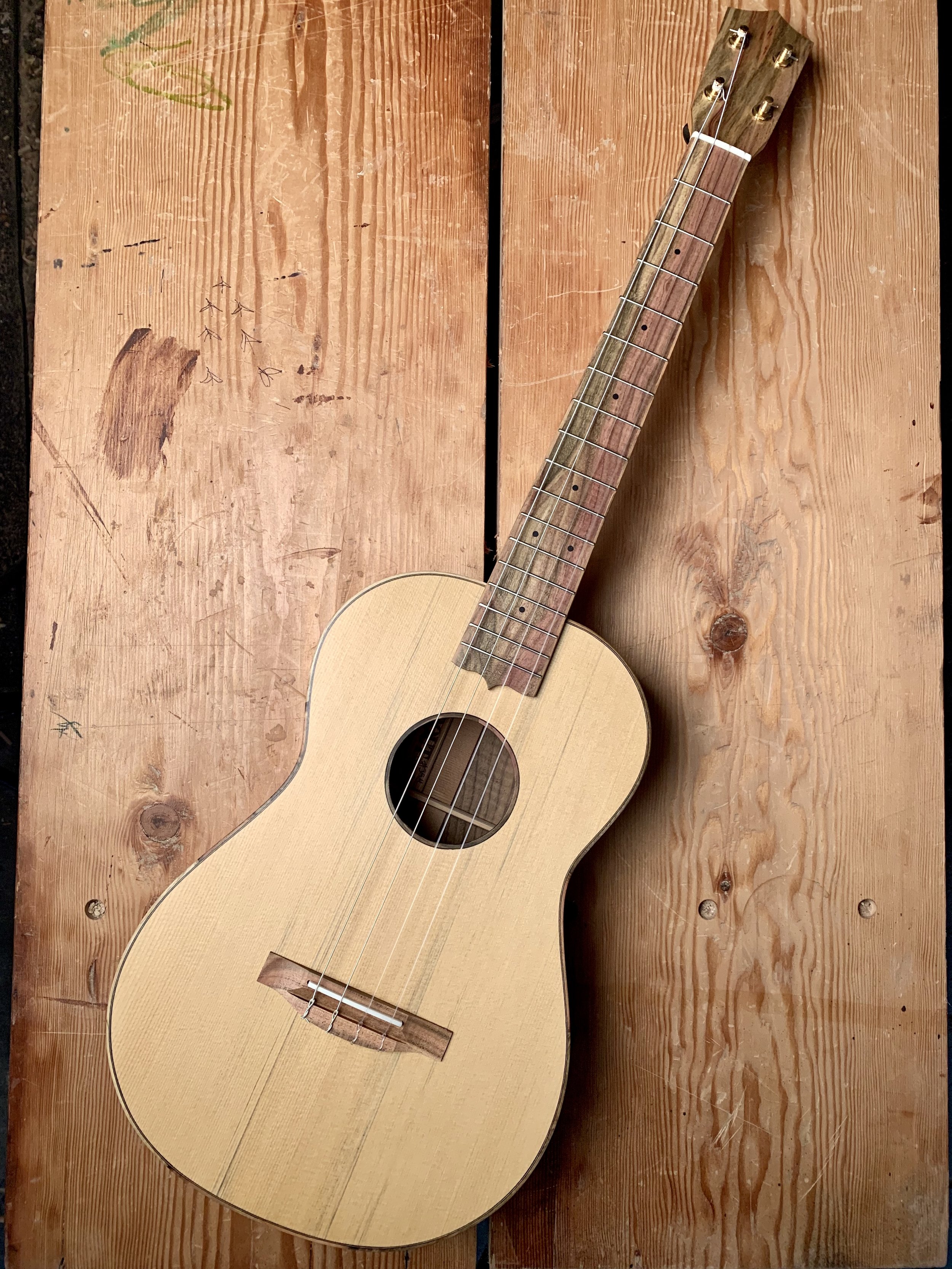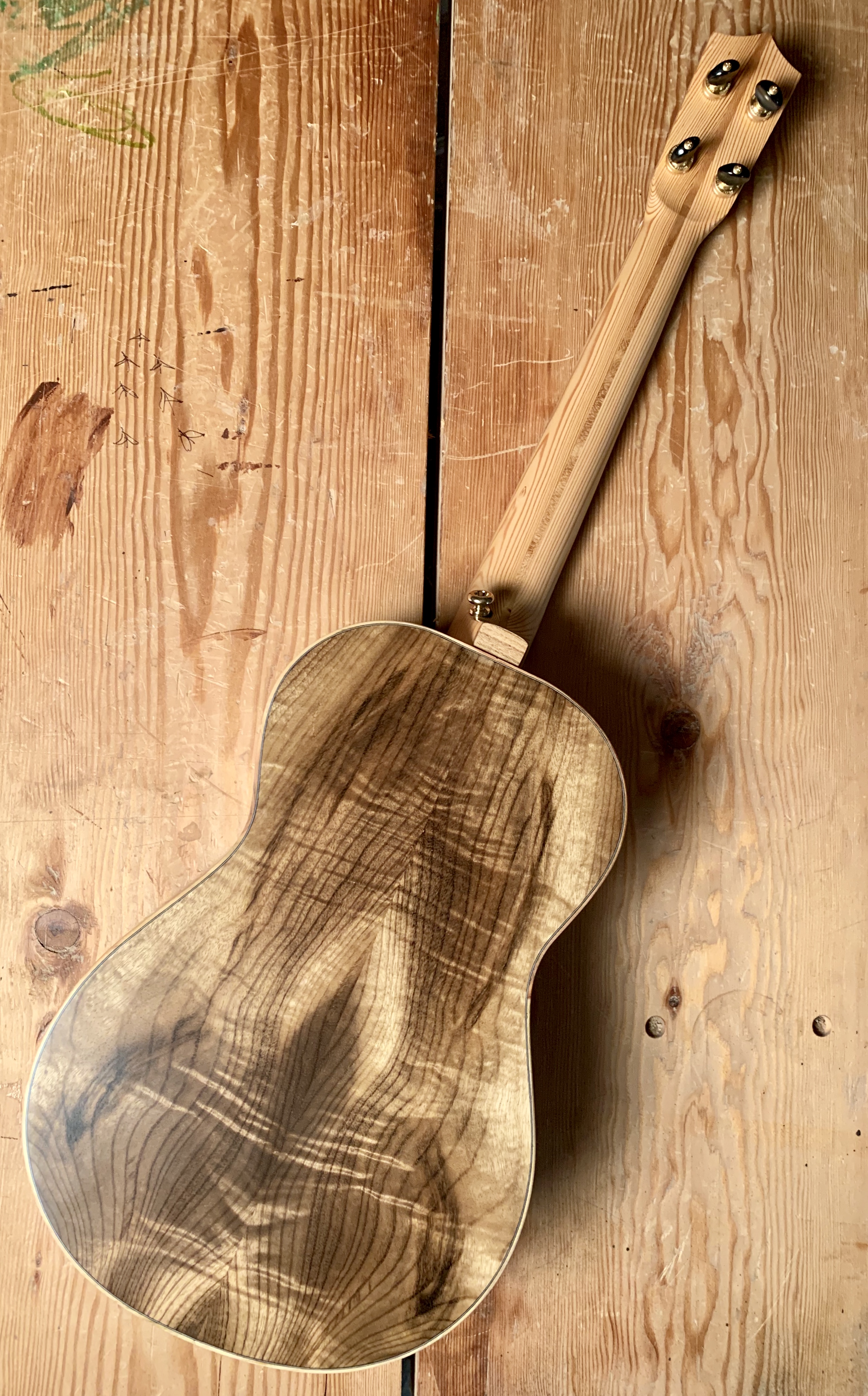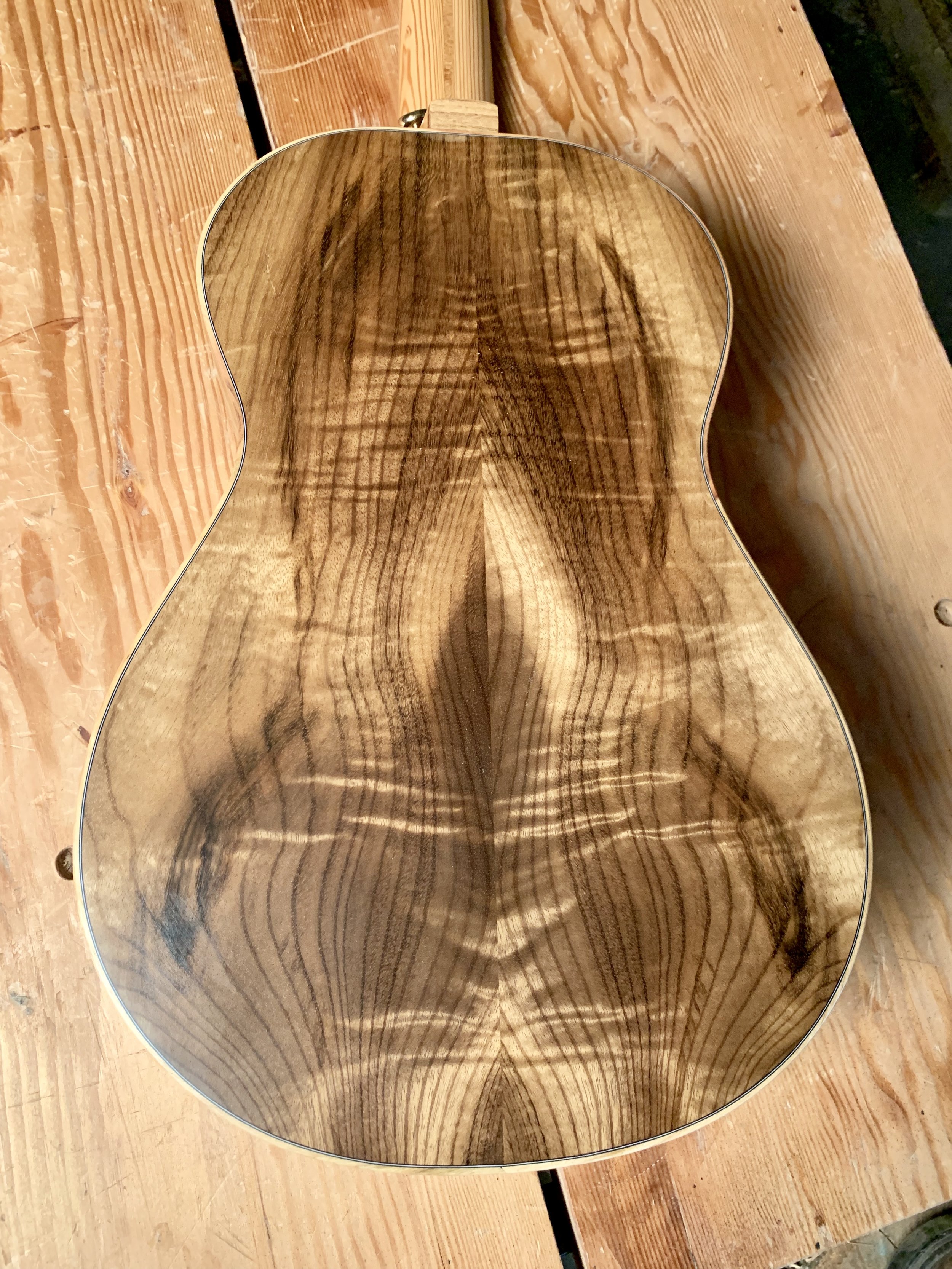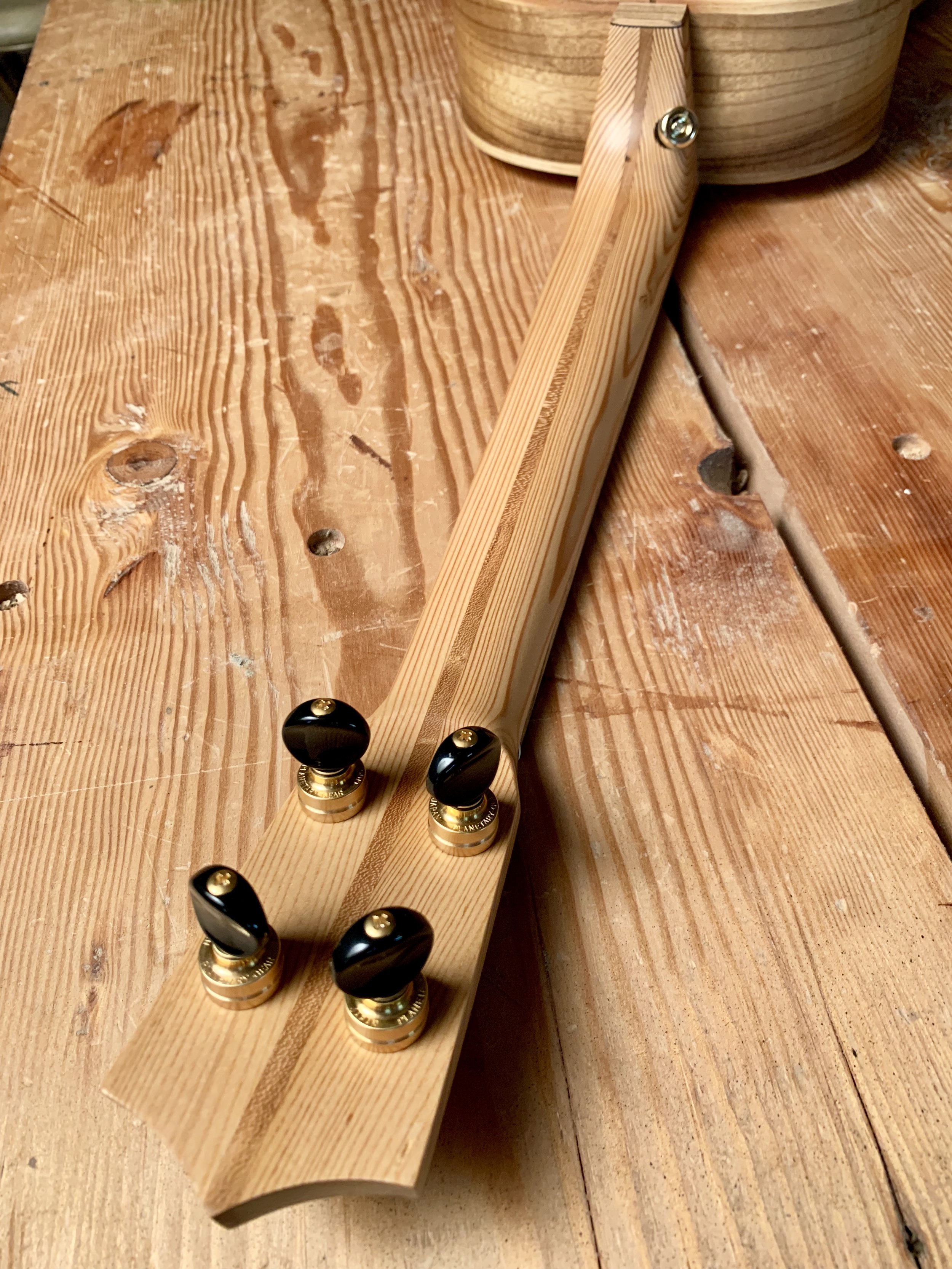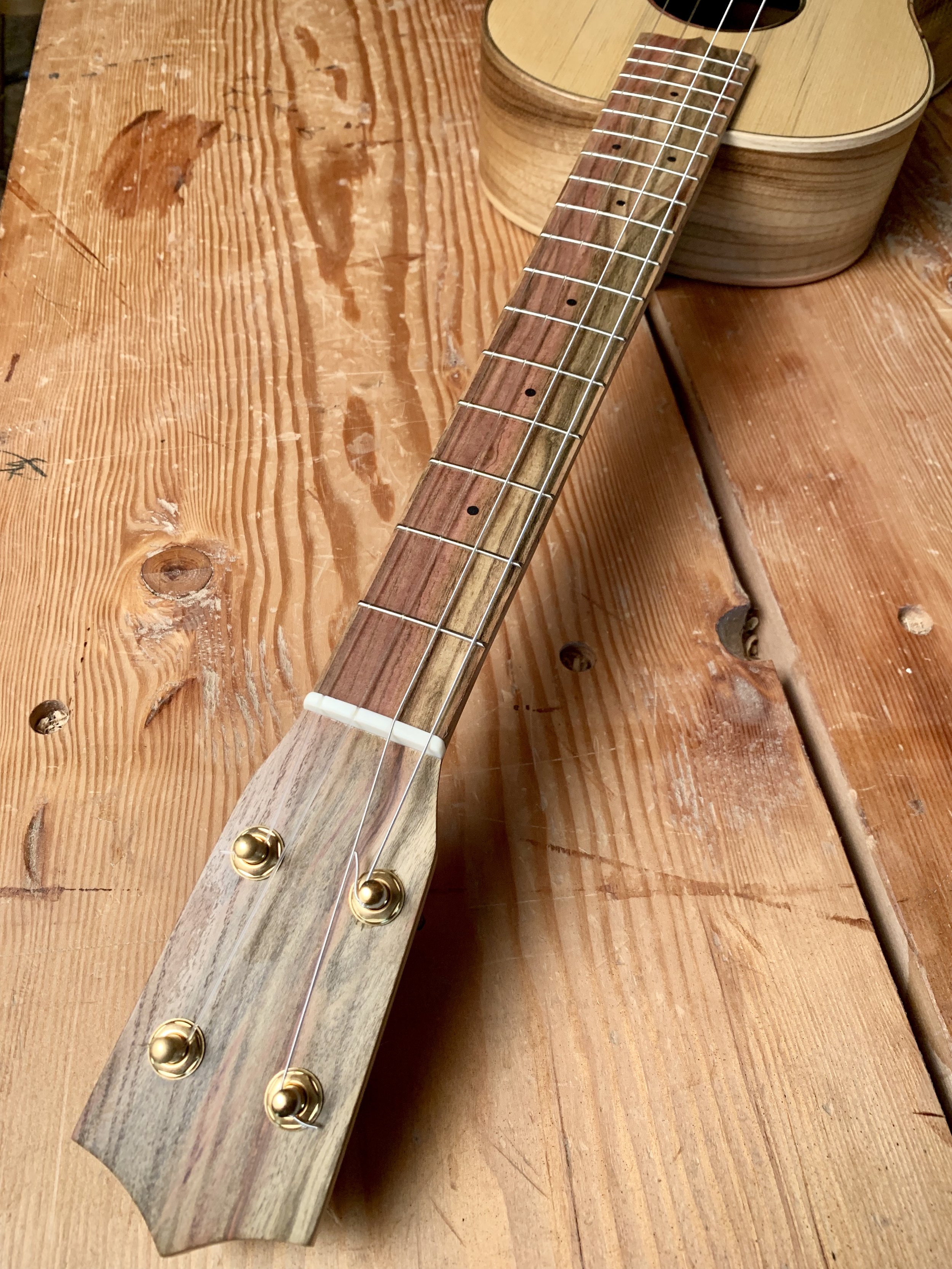I don’t really work in batches, as I always have the next two months of instruments creeping along behind, but I do promise what month you will get your uke in. It feels good to get a month finished and take a little time to refocus, take inventory, clean the shop and dive back in. I am interested in how the rhythm of a working life is interrupted by problems or issues and how they take your focus and time. It’s like a problem child in the class room causing the teacher to leave other students to be more independent. In the case of #414, we had such a good student that it took till today to notice its gifts. Beautiful, loud tone (but not harsh), simple grain and lines with tiny textures and features that draw the eye and a classic shape. The walnut is from the Carpenter Ant stash in Portland and the pistachio comes from California orchards via woodfromthewest.com.
#413- Maple and Pistachio Tenor Banjo Ukulele
Lately I’ve been thinking about consistency in the shop. Not just making a nice thing, but making a nice thing everyday, with repeatability and increased efficiency. I’ve noticed over the last few years that when I gain some time due to efficiency or greater skill, I just end up re-investing the time back into the instrument. I pretty much make a banjo uke in the same amount of time as I did 8 years ago, but the complexity and quality is much greater now. The tricky part is knowing when to start over or give up on a piece of wood. In this case, I admit that I threw away the first neck I made for this banjo and I don’t regret it. As we used to say when I worked as a stage hand: “admit it, fix it and move on.” The maple for this neck comes from Henry’s dance floor stash, the rim is made from the neck cutoffs saved from several other banjos, segmented together in a random mosaic of maple and pistachio. The pistachio fretboard, headplate and trim are from California orchards.
“My beansprout banjo ukulele arrived safely yesterday! It is absolutely stunning. Pictures don’t quite capture the beauty of this instrument. It is such a joy to just hold and look at. I really love the maple and pistachio mosaic drum and the spalted pistachio heel cap. Amazing craftsmanship.
I have logged several hours of playing time since the banjo ukulele arrived yesterday and I really like how comfortable the neck is and how easy the instrument is to play. I was torn between the choice of walnut vs maple but I love the bright punchy sound of the maple. The pistachio rim really balances the sound out nicely.
Thanks again Aaron. Your clawhammer book and youtube videos are what initially inspired me to learn the ukulele several years ago, and I’m just thrilled to have one of your ukuleles now to jam my favorite songs on. Looking forward to many more years of fun and learning with this amazing banjo ukulele.
-T.C.”
#412- Curly Walnut Four String Banjo
I was inspired to make this banjo by an old Vega style F tenor banjo that I used to play. A simple design, a comfortable size, sweet tone and loud volume. I chose the 11” rim from my five string banjos and 20” scale from my Baritone ukuleles so everything would feel familiar, although combined in a new way. This one is strung dgbe with baritone uke strings, but it would be suitable for other tunings and steel strings as well. Curly Oregon walnut from Goby in Portland and the pistachio is from woodfromthewest.com. To see the specs or order, hit the models page.
“The instrument arrived today safe and sound. Wow! It sounds so warm and beautiful, and it’s just gorgeous.
I love it.
I’ve only played for like 45 minutes, but I’m very pleased. I’m new to the baritone scale, so I may circle back with questions. But thanks again for everything. I hope to meet you all in person someday to personally express my gratitude for making such fine instruments.
- D. L. ”
#408- Port Orford Cedar and Myrtle Baritone Ukulele
This baritone sounds just as good as the last one with pistachio back and sides. It might have a little less raw power of sound, but it feels a little more elegant in the lap. It also has a more subtle color palette, featuring the more muted tones of the Wabi-sabi ideal. Old growth Port Orford Cedar, striped Myrtle and Pistachio from woodfromthewest.com and a hemlock neck salvaged from a barn in The Dalles, OR.
“Dear Aaron and Nicole,
I wanted to take a couple of days after I’d received my new Baritone, to sit and play, and to get to know it before I wrote. First let me say, I LOVE IT!!! In fact I’ve been trying to squeeze in extra practice time because it’s such a pleasure to hold it, feel the finish, and the smoothness of the neck makes playing such a wonder.
I love the beauty of the workmanship. The details are exquisite, especially along the fretboard, rope binding, etc. etc. etc. The over all weight is perfect (light) and the balance is amazing. I have an old Giannini baritone, that I love the sound of but the weight is weird/unbalanced and the fret board/neck is a narrow “C” shape that is at times very challenging to play. The slight radius of my new Beansprout Baritone’s fretboard and the fact that the string height is set and adjusted has made making barred chords so much easier.
I guess the one thing I’d have to say that your ukes should come with a warning, “Beware that you will want to play longer and finger soreness may develop”: All kidding aside, everything about the subtle sound and color, the wabi-sabi inclusions, make for a “well worth waiting for” experience. I also loved seeing the pictures and the final video when it was complete. This new Baritone #408 is a dream. I look forward to many years of playing. My only dilemma now is how long can I wait before I order a low G tenor?
Thank you and All the best,
- B. F. ”
#405- Spruce and Pistachio Baritone Ukulele
I love to be surprised. I picked out the wood for this one months ago, but I never took the time to really appreciate it till today. What looked like a plain spruce top ended up having multiple tiny bear claw marks that added an interesting texture to the straight grain dulcimer spruce top. I knew the pistachio back and sides were nice, but now I see how awesome they are. The multi color grafted wood is just stunning. Also, it’s dense and hard nature is perfect for reflecting the sounds from the softer spruce top. So choice. Of course, the pistachio fretboard is a winner too. The pistachio all comes from California orchards, the old growth fir neck is from a floor joist and the Sitka spruce top is salvaged from a 1960’s dulcimer maker’s stash.
“Aaron, I wanted to let you know my ukulele arrived safely yesterday. It looks and sounds awesome! I am totally pleased. I made a short video of me messing around with different versions of Ferre Jacques.
- J. M. ”
#403- Curly Port Orford Cedar and Mastergrade Walnut Alto Ukulele
It is very interesting to make a second instrument for someone because it not only has to stand on its own, but also make sense as a unit in someone’s collection. In this case, a low g was needed, so the soft wood top and hardwood back and sides was an easy choice. The amazing curly Port Orford Cedar, the Mastergrade walnut and the pistachio are all from Oregon and California, provided by woodfromthewest.com. The fir comes from an old floor joist, complete with one nail hole in the headstock. It sounds snappy but with good sustain and rich overtones, I’m quite happy with it.
#409- Curly Walnut and Pistachio Tenor Banjo Ukulele
There is a furniture maker/artist from Washington named Bruno Hervieux. (Normandie Woodworks) I met him because of our shared interest in old woodworking machines. I’ve recently been interested in and inspired by his furniture because of his unique use of mixed materials. These include wood, parchment, brass, straw and others. While looking at his work I realized that a banjo is also a piece of mixed media folk art, in this case brass, walnut and goat skin. A side table holds your coffee cup and a banjo makes music. It’s up to us to make them beautiful as well as functional. This banjo has curly walnut from Goby in Portland, pistachio from California orchards and a stained goat skin head.
#402- Fir and Maple Tenor Ukulele
By now, I shouldn’t be surprised by the tone of any ukulele, I’ve pretty much heard it all. I won’t say this one surprised me, I think delighted/tickled/fascinated are all better words. The maple back and sides make sure it is loud, but also offer clarity. The fir warms and rounds it up just enough. Sigh. It’s great. The fir and maple are from the Carpenter Ant stash in Portland. The spruce neck is from Camp Westwind in the Oregon coast and the pistachio is from California orchards.
#407- Walnut and Pistachio Mini Five String Banjo
These mini five string banjos have become more popular than I expected and I am still enjoying playing them, whether in open c or open g tuning. This one has a dark and growling tone, with a sweet edge to it. It comes from the combination of the low tuning, the natural skin head and the tonal quality of walnut. I also stained the skin head for the first time, using Tea and some amber dye. The walnut is from the carpenter ant stash in Portland and the pistachio is from California Orchards.
“I am in love with Gertie! I named my new banjo after a favorite aunt who changed her name to Lee when she got older. I still remember her as Gertie. This banjo is as wonderful as she was....always a new adventure ahead and full of life!
I appreciate your workmanship and the aesthetics of how she was built. A fine looking instrument. I love the easy touch... can hardly wait to start my lessons.
Thank you soooooo much!
- S. P.”
#406- Walnut and Pistachio Mini Five String Banjo
For this banjo rim, I made the block rim segments from the cutoffs leftover from making neck blanks. I purposely saw them so that each looks a little different. I also lay them out randomly so that each one is unique. It’s a nice excercise in letting go and appreciating what develops as I turn it on the lathe. For the fretboard, the customer wanted a piece of pistachio with lots of movement and color variation. They also asked for a frailing scoop, which is a cutout at the end of the fretboard to make Clawhammer technique a little easier. The walnut is from the Carpenter Ant stash in Portland and the pistachio is from California orchards. I liked this banjo so much that I made an extra video with it. See below.
#399- Port Orford Cedar and Curly Myrtle Tenor Ukulele
For this ukulele, I was interested in exploring a muted, earth tone color palette. This was inspired by looking at both the natural world and the muted color palette associated with Wabi-Sabi inspired art/culture. The bonus is the amazing spider and web that I found in the Myrtle board, it truly is an unique musical instrument. The neck is made from old Douglas Fir floorboards while the rest of the wood came from the Oregon coast via woodfromthewest.com.
#404- Walnut and Pistachio Tenor Banjo Ukulele
The first time I played a good, old, National resophonic guitar, I realized that it wasn’t just loud, it had a wide dynamic range. Yes, it could bark, but it could also purr. This sort of versatility is what I’m after, even with the humble banjo uke, and this one has it. The block rim pieces for the banjo rim are made from off cuts from previous banjos, hence the more random mosaic layout. Oregon walnut from the Carpenter Ant stash in Portland and Pistachio from California Orchards.
#401- Mahogany and Walnut Alto Ukulele
I’ve been interested lately in some of the earliest ukuleles made in Hawaii. These often included lots of inlay and marquetry, the most popular of which was the so called “rope” binding. In this case, I use alternating blocks of maple and walnut. As an homage to the old mainland version of these designs, I used some salvaged mahogany for the body and the neck. In tribute to our Oregon location, I chose walnut for the headplate, fretboard and bridge. An updated version of a classic design with my own twist in it.
#400- Port Orford Cedar and Curly Walnut Tenor Ukulele
Every day in the shop is a learning experience and every instrument has something to teach me. I am not perfect in my thoughts or deeds, but I try harder every day to listen to the wood, the tools and the music. Some instruments are born with no fuss, others need to make their presence known by offering more of a challenge to me. My job is to make sure that they all look and sound good at the end and all the lessons are remembered for the next uke. This tenor with a low g has great power and subtlety, is easy to play and looks beautiful. I hope it also has lessons to teach its owner. Curly walnut from Goby in Portland, salvaged hemlock neck from Portland Salvage Works and Port Orford Cedar and Pistachio from woodfromthewest.com.
“Just wanted to drop a note and say that this uke is the best I have ever played and it has made playing such a joy. Thank you for that! It was well worth the long wait and I’m very pleased!
All the best
Zooey Deschanel
”
#398- Spruce and Walnut Baritone Ukulele
This is instrument is for a friend and colleague, Ryan Kolberg, who I have played music with for several years. He mainly plays bass and guitar, so he decided on a baritone. He runs a recording studio and I think all good studios should have one of my ukes hanging around, ready to spark an idea. Curly walnut from Goby in Portland, Bearclaw Sitka spruce from Alaska, pistachio from California orchards and a salvaged Douglas fir neck from the barn at Level beer in Portland. I’m proud of the sound and look of this instrument, I can’t wait to hear what he comes up with.
#388- Spruce and Walnut Alto Ukulele
This instrument is for another long time customer and student from Vancouver, WA. We hit upon the challenge of making everything on the ukulele from spruce or walnut. The wide grain Oregon spruce is from Camp Westwind, where we teach music every fall. It behaves much differently than the cold growing Alaskan spruce, but I like it on ukuleles. All the walnut is urban salvage from Goby walnut in Portland, with lots of reds, purples and browns. Overall it is a loud but warm ukulele made from local wood for a good musician. Win.
“I am loving my new Beansprout uke! I gave it a good workout this past weekend. It met all my expectations. The tone was warm with plenty of volume, it was easy to play, but the best and most important thing was that it stayed in tune up the neck:)
I also appreciate your amazing skill and craftsmanship. Not only is it a beautiful sounding instrument it is an amazing work of art.
- C. M. ”
#395- Port Orford Cedar and Clockmaker’s Koa Scout Ukulele
Made from pieces of wood too that are too small for my other ukes, these Scout ukuleles are a way for me to occasionally produce a more “democratic” instrument. It is portable, easy to play, invites conversation, encourages musical community and is affordable for a hand made instrument. I make them whenever I get a few spare hours in the shop. The Koa for this one is from Lizann’s grandfather, who imported it to make grandfather clocks. The Port Orford Cedar and fir are from the Oregon coast.
#397- Curly Maple and Pistachio Mini Five String Banjo
This curly maple from Zena Forest Products is just so awesome. The curl is great, the reddish natural color is better than any stain and it is quite hard, which produces a strong tone. I paired it with some unique pistachio from California orchards to complete the look. With materials this nice, it really pushes the boundaries of my folk art. This inspires me to work better and more accurately but also grounds me to the wood’s and my own limitations. It is off to Hawaii to live it’s own best life as a beautiful and functional object.
#396- Maple and Pistachio Concert Banjo Ukulele
Just because you can play loudly, doesn’t mean you should. (Well, sometimes, maybe…). Either way, Ed will be well equipped with this one. Hard Maple from Henry’s dance floor stash and some awesome pistachio from California Orchards. Ready for music.
#394- Port Orford Cedar and Mastergrade Myrtle Baritone Ukulele
This one can do it all, deep and rich, bright and vibrant, loud and soft. It has so much sound it practically leaps off my lap! It is a whole different animal compared to the muddy and quiet import baritone ukuleles. The Mastergrade Myrtle back and sides really are a special piece that I have found myself staring at for long stretches of time. (Get back to work, Aaron.). The Port Orford Cedar top has blue streaks in it that I like as a subtle texture. The fir neck came from the barn at Level Beer in Portland. Everything else is from the Oregon Coast and California Central Valley via woodfromthewest.com.







